Popular Flowers Found In The Valley Of Flowers
Eye Catching Spectacles Of Over 600 Flower Species
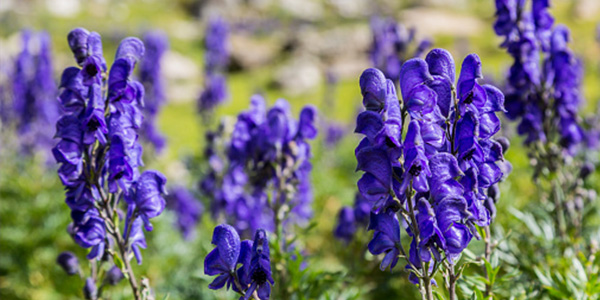
Local Name:Meetha Vish
Family:Ranunculaceae (Buttercup family)
1 to 2 Feet
Perennial (lives for more than two years)
- Local Name: Meetha Vish
- English Name: Balfour's Monkshood
- Botanical Name: Aconitum balfourii
- Flowering time: July to September
- Life span: Perennial (lives for more than two years)
- Height of the plant: Generally grows up to 1 to 2 feet in height
- Size of the flower: The flowers are medium-sized, typically around 1 inch in diameter
- Family: Ranunculaceae (Buttercup family)
- Habitat: Native to the Himalayan region, specifically found in alpine meadows and rocky slopes at high altitudes.
- uses:
- Ornamental plant: Aconitum balfourii is often cultivated for its attractive flowers and foliage.
- Medicinal purposes: Some traditional medicinal uses have been associated with Aconitum species, although caution is advised as the plant is highly toxic and should not be used without proper expertise.
- Insect repellent: It is believed that the strong scent of the plant can repel certain insects.
.jpg)
Local Name:Mitha telia
Family:Ranunculaceae (Buttercup family)
3 to 4 feet
Perennial (lives for more than two years)
- local name:Mitha telia, Dudhia-bis, Telia kachnag, Tilla
- English Name: Violet Monkshood
- Botanical Name: Aconitum violaceum
- Flowering time: August to September
- Life span: Perennial (lives for more than two years)
- Height of the plant: Generally grows up to 3 to 4 feet in height
- Size of the flower: The flowers are medium-sized, typically around 1 to 2 inches in length
- Family: Ranunculaceae (Buttercup family)
- Habitat: Native to the Himalayan region, specifically found in moist alpine meadows, forest clearings, and slopes at high altitudes.
- Uses:
- Ornamental plant: Aconitum violaceum is often grown for its showy violet-colored flowers, making it an attractive addition to gardens.
- Medicinal purposes: Some traditional medicinal uses have been associated with Aconitum species, although caution is advised as the plant is highly toxic and should not be used without proper expertise.
- Insect repellent: It is believed that the strong scent of the plant can repel certain insects.
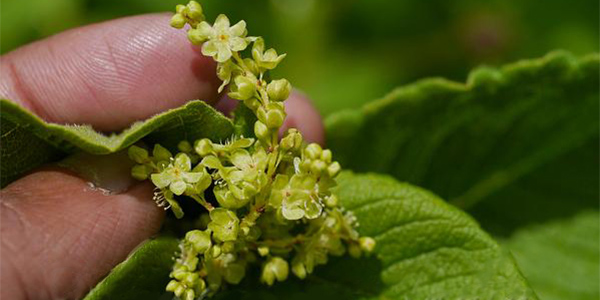
Local Name:Khyak Jari
Family:Polygonaceae (Knotweed family)
1 to 3 feet
Perennial (lives for more than two years)
- local name: Khyak Jari
- English Name: Rumex-leaved Knotweed
- Botanical Name: Aconogonum rumicifolium
- Flowering time: May to June
- Life span: Perennial (lives for more than two years)
- Height of the plant: Generally grows up to 1 to 3 feet in height
- Size of the flower: The flowers are small and inconspicuous, typically around 1/4 inch in diameter
- Family: Polygonaceae (Knotweed family)
- Habitat: Native to temperate regions, it is commonly found in meadows, grasslands, forest edges, and disturbed areas.
- Uses:
- Erosion control: Aconogonum rumicifolium is sometimes used for stabilizing soil on slopes and preventing erosion.
- Ornamental plant: Due to its attractive foliage, it can be grown as an ornamental plant in gardens.
- Medicinal uses: Some traditional medicinal uses have been associated with Aconogonum species, although specific uses for Aconogonum rumicifolium may vary based on local practices and knowledge.
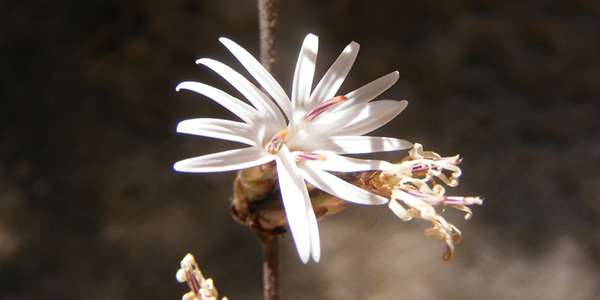
Local Name:Khad-jhari
Family:Asteraceae (Aster family)
2 to 3 feet
Perennial (lives for more than two years)
- local name: Karu-Bhuti, Khad-jhari
- English Name: Ainsliaea Aptera
- Botanical Name: Ainsliaea aptera
- Flowering time: August to September
- Life span: Perennial (lives for more than two years)
- Height of the plant: Generally grows up to 2 to 3 feet in height
- Size of the flower: The flowers are small to medium-sized, typically around 0.5 to 1 inch in diameter
- Family: Asteraceae (Aster family)
- Habitat: Native to various regions in Asia, including China, Japan, and Korea. It is typically found in mountainous areas, forest edges, and open slopes.
- Uses:
- Ornamental plant: Ainsliaea aptera is valued for its attractive flowers and can be cultivated in gardens.
- Medicinal purposes: Some traditional medicine systems use parts of the Ainsliaea aptera plant for various medicinal purposes, such as treating respiratory conditions and promoting blood circulation.
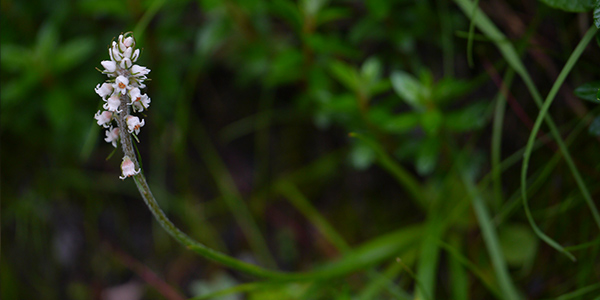
Local Name:Khasi
Family:Melanthiaceae
up to 12 inches (30 cm)
Perennial (lives for more than two years)
- English Name: Aletris pauciflora
- Botanical Name: Aletris pauciflora
- Local Name: Khasi
- Flowering time: June - July
- Life span: Perennial plant, meaning it lives for more than two years
- Height of the plant: Can reach a height of up to 12 inches (30 cm)
- Size of the flower: The flowers are small, usually less than an inch (2.5 cm) in size
- Family: Melanthiaceae
- Habitat: Native to the southeastern United States, particularly found in dry, sandy soils of pine forests and open woods
- Uses:
- Medicinal: In traditional herbal medicine, Aletris pauciflora has been used for its tonic, diuretic, and emmenagogue properties. It has been used to treat menstrual disorders, digestive issues, and to improve appetite.
- Ornamental: The small, delicate flowers make Aletris pauciflora an attractive addition to rock gardens or naturalistic planting schemes.
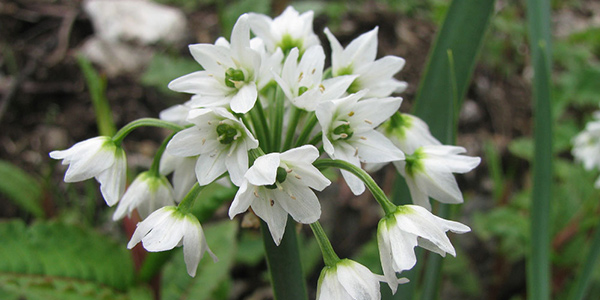
Local Name:Jangli lahsun
Family:Amaryllidaceae
10 to 15 cm.
Perennial
- English Name: Allium Humile
- Botanical Name: Allium humile
- Local Name: Jangli lahsun
- Flowering time: April to May
- Life span: Perennial
- Height of the plant: Typically 10 to 15 cm.
- Size of the flower: Small, approximately 1 to 2 cm. in diameter
- Family: Amaryllidaceae
- Habitat: Native to the Himalayan region and found in various parts of India, particularly in the states of Himachal Pradesh, Uttarakhand, and Jammu and Kashmir.
- Uses:
- Ornamental purposes: Allium humile is cultivated for its attractive flowers and is often used in rock gardens, borders, or as a groundcover plant.
- Medicinal properties: In traditional medicine, various parts of the plant, including the bulbs, are used for their therapeutic properties, such as treating digestive disorders and boosting immunity.
- Culinary uses: The bulbs of some Allium species, including Allium humile, have culinary applications and are used as a flavoring agent in certain cuisines.
- Ecological importance: Allium humile serves as a nectar source for bees and other pollinators, contributing to biodiversity and ecosystem health.
- Cultural significance: In certain regions of India, Allium humile holds cultural significance and may be used in religious rituals or festivals.
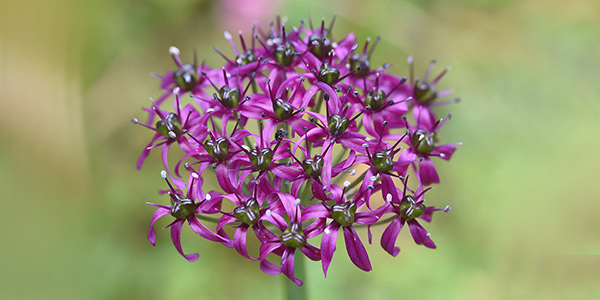
Local Name:Doona
Family:Amaryllidaceae
15-30 cm.
Perennial (multiple years)
- English Name: Wallich's Allium
- Botanical Name: Allium wallichii
- Local Name: Doona
- Flowering time: May to July
- Life span: Perennial (multiple years)
- Height of the plant: Typically around 15-30 cm.
- Size of the flower: Small, approximately 1-2 cm. in diameter
- Family: Amaryllidaceae
- Habitat: Found in the Himalayan region, specifically in the alpine and subalpine zones of Uttarakhand, India.
- Uses:
- Ornamental plant: Wallich's Allium is often cultivated as an ornamental plant in gardens and landscapes due to its attractive flowers.
- Medicinal purposes: Some parts of the plant, such as the bulbs and leaves, are used in traditional medicine for their medicinal properties.
- Culinary use: The leaves and bulbs of Wallich's Allium are sometimes used in local cuisine for flavoring dishes.
- Biodiversity conservation: The plant plays a role in maintaining biodiversity in its natural habitat and contributes to the ecological balance of the region.

Local Name:Sugandhi booti, Kapasi
Family:Asteraceae
30-90 cm (12-35 inches)
Perennial (lives for several yearss)
- English Name: Royle's Pearly Everlasting
- Botanical Name: Anaphalis royleana
- Local Name: Sugandhi booti, Kapasi
- Flowering time: July to September
- Life span: Perennial (lives for several years)
- Height of the plant: 30-90 cm (12-35 inches)
- Size of the flower: 1-2 cm (0.4-0.8 inches) in diameter
- Family: Asteraceae
- Habitat: Found in the Western Himalayas and other mountainous regions of India, growing at altitudes of 2,500 to 4,500 meters (8,200 to 14,800 feet). It prefers well-drained soil and is commonly found in open slopes, meadows, and rocky areas.
- Uses:
- Medicinal uses: The plant has various traditional medicinal uses in India. It is believed to have antipyretic (fever-reducing), analgesic (pain-relieving), and anti-inflammatory properties. It is used to treat fever, respiratory ailments, digestive disorders, and skin conditions.
- Ornamental purposes: The flowers of Anaphalis royleana are often used in flower arrangements and for making garlands and wreaths due to their attractive appearance and long-lasting nature.
- Cultural significance: In some regions of India, Anaphalis royleana is considered sacred and is used in religious ceremonies and rituals.
- Ecological importance: The plant serves as a nectar source for various pollinators, including butterflies and bees. It also provides food and habitat for certain insect species.
- Soil conservation: Anaphalis royleana is known to have soil-binding properties, which helps in preventing soil erosion in mountainous areas.
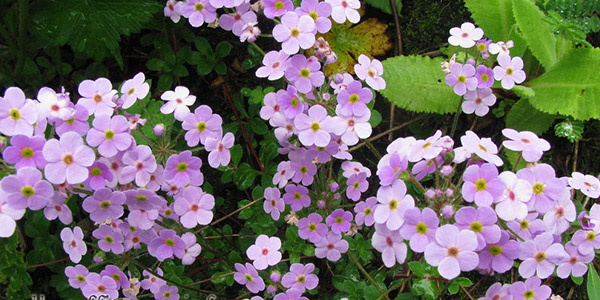
Local Name:Not specified
Family:Primulaceae
5 to 15 cm.
Perennial (lives for several years)
- English Name: Rock jasmine
- Botanical Name: Androsace studiosarum
- Local Name: Not specified
- Flowering time: Typically blooms in spring, usually between April and June
- Life span: Perennial plant, can live for several years
- Height of the plant: Varies, but generally ranges from 5 to 15 cm. in height
- Size of the flower: Small, delicate flowers with a diameter of approximately 1 to 2 cm.
- Family: Primulaceae
- Habitat: Native to mountainous regions of Central and Southern Europe, particularly the Alps and Carpathians.
- Grows in rocky crevices and alpine meadows, often in high altitudes.
- Uses:
- Primarily grown as an ornamental plant due to its attractive flowers. It is often cultivated in rock gardens, alpine gardens, or as a ground cover.
- The flowers can also be used in floral arrangements or bouquets.
- Additionally, some species of Androsace have medicinal properties and are used in traditional herbal medicine.
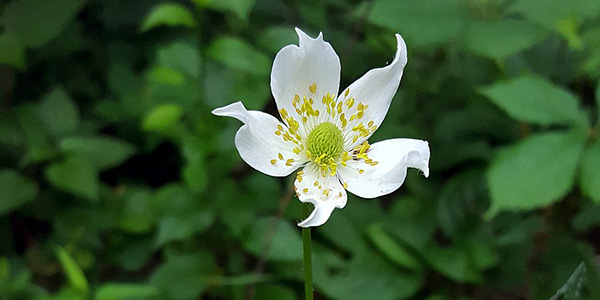
Local Name:Not specified
Family:Ranunculaceae
6-12 inches (15-30 cm)
Perennial (long lifespan)
- English Name: Four Petal Anemone
- Botanical Name: Anemone tetrasepala
- Local Name: Not specified
- Flowering time: Typically blooms from late spring to early summer (May to June)
- Life span: Perennial plant with a long lifespan
- Height of the plane: Varies, but generally reaches a height of 6-12 inches (15-30 cm)
- Size of the flower: The flowers are small and typically measure around 1 inch (2.5 cm) in diameter
- Family: Ranunculaceae
- Habitat: Native to North America, particularly found in moist woodland areas and meadows
- Uses:
- Ornamental plant: Flower Anemone tetrasepala is primarily grown for its attractive flowers, which can add color and beauty to gardens and landscapes.
- Pollinator attraction: The flowers of this plant can attract pollinators like bees and butterflies, contributing to the overall biodiversity of the area.
- Erosion control: Due to its spreading habit and root system, Flower Anemone tetrasepala can be used to help control erosion in certain areas
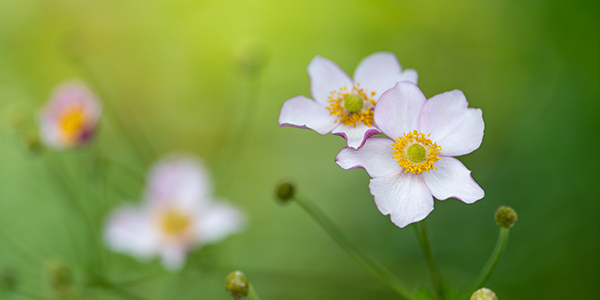
Local Name:Mudeela, Agali
Family:Ranunculaceae (Buttercup family)
12 to 18 inches (30 to 45 cm)
Perennial (Can lives for several years)
- English Name: Vine leaved Anemone
- Botanical Name: Anemone vitifolia
- Local Name: Mudeela, Agali
- Flowering time: July to September
- Life span: Can live for several years
- Height of the plant: Varies, but typically grows to a height of 12 to 18 inches (30 to 45 cm)
- Size of the flower: The flowers are medium-sized, typically measuring 2 to 3 inches (5 to 7.5 cm) in diameter
- Family: Ranunculaceae (Buttercup family)
- Habitat: Native to the temperate regions of Europe and Asia, and cultivated in gardens worldwide. Specific habitat requirements may vary.
- Uses:
- Primarily grown as an ornamental plant in gardens and landscapes. The attractive flowers add color and beauty to flower beds and borders. Some species may have medicinal properties or are used in traditional herbal remedies, but it is unclear if Anemone vitifolia specifically has any significant uses in this regard.

Local Name:Not specified
Family:Ranunculaceae (Buttercup family)
1 to 2 feet (30 to 60 cm.)
Perennial(lives for several years)
- English Name: Himalayan Columbin
- Botanical Name: Aquilegia pubiflora
- Local Name: Not applicable
- Flowering time: May to June
- Life span in year: Perennial (typically lives for several years)
- Height of the plant: Approximately 1 to 2 feet (30 to 60 cm.)
- Size of the flower: 1 to 2 inches (2.5 to 5 cm.) in diameter
- Family: Ranunculaceae (Buttercup family)
- Habitat: Native to the western United States and Canada, typically found in mountain meadows, open woods, and rocky slopes.
- Uses:
- Ornamental plant: Aquilegia pubiflora is cultivated for its attractive flowers and is commonly used in gardens and landscapes for its aesthetic appeal.
- Pollinator attraction: The flowers of Aquilegia pubiflora attract bees, butterflies, and hummingbirds, making it a beneficial plant for pollinator gardens.
- Medicinal properties: Some species of Aquilegia have been traditionally used in herbal medicine for their potential healing properties, but specific uses for Aquilegia pubiflora are not widely documented.
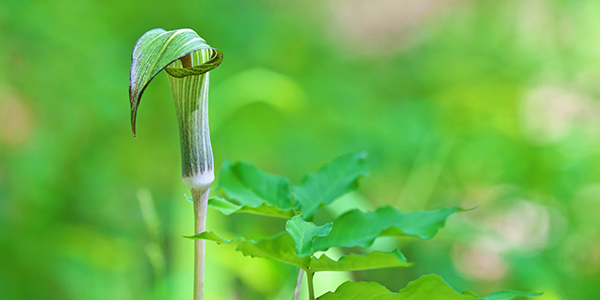
Local Name:Not specified
Family:Araceae (Arum family)
1 to 2 feet (30 to 60 cm.)
Perennial (lives for several years)
- English Name: Jack-in-the-Pulpit
- Botanical Name: Arisaema jaquemontii
- Local Name: Not commonly known by a specific local name in India
- Flowering time: Usually blooms in the months of April and May
- Life span: Typically lives for 10 to 15 years
- Height of the plant: Grows to an average height of 1 to 2 feet
- Size of the flower: The flower consists of a spathe (hooded structure) that is typically 3 to 4 inches long, and a spadix (central column) that can reach up to 6 inches in length.
- Family: Araceae (Arum family)
- Habitat: Native to the Himalayan region, including India, Bhutan, and Nepal. It can be found growing in moist, shady forests and along stream banks.
- Uses:
- Ornamental: Jack-in-the-Pulpit is a popular choice for gardeners due to its unique and intriguing flower structure. It adds an interesting element to woodland gardens or shady areas.
- Medicinal: Some species of Arisaema, including Arisaema jaquemontii, have been used in traditional medicine for various purposes, such as treating respiratory ailments and skin conditions.
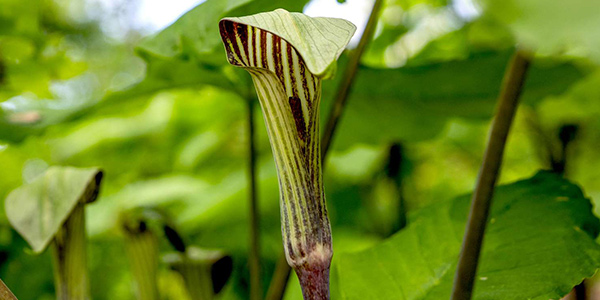
Local Name:Not specified
Family:Araceae
1 to 2 feet (30 to 60 cm.)
Perennial (long-lived)
- English Name: Himalayan Cobra Lily
- Botanical Name: Arisaema propinquum
- Local Name: Not specified
- Flowering time: June to September
- Life span: Perennial (long-lived)
- Height of the plant: Approximately 30-60 cm. (1-2 feet)
- Size of the flower: The inflorescence (spadix) can reach up to 15-20 cm. (6-8 inches) in length.
- Family: Araceae
- Habitat: Native to the Himalayan region, including India, Nepal, Bhutan, and China. It grows in forests, shady slopes, and damp areas.
- Uses:
- Ornamental plant: The distinctive and attractive flower of Arisaema propinquum makes it popular among garden enthusiasts.
- Medicinal: Some Arisaema species have been used in traditional medicine for various purposes, although specific information regarding Arisaema propinquum's medicinal uses is limited.
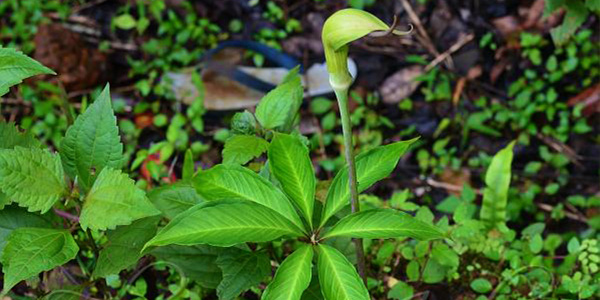
Local Name:Arum lily, Varuna
Family:Araceae
1 to 2 feet (30 to 60 cm.)
Perennial (lives for many years)
- English Name: Twisted Leaf Jack-in-the-Pulpit
- Botanical Name: Arisaema tortuosum
- Local Name: Arum lily, Varuna,Bagh Jandhra
- Flowering time: April to June
- Life span: Perennial (lives for many years)
- Height of the plant: Typically 1 to 2 feet (30 to 60 cm.)
- Size of the flower: The inflorescence consists of a spathe (flowering structure) that can reach up to 6 inches (15 cm.) in length.
- Family: Araceae
- Habitat: Native to the Himalayan region, including India, Nepal, Bhutan, and Tibet. It is often found in shady and moist areas of forests, along stream banks, and in high-altitude regions.
- Uses:
- Ornamental: Due to its unique and attractive spathe, Arisaema tortuosum is grown as an ornamental plant in gardens and landscapes.
- Medicinal: In traditional medicine, certain parts of the plant are used for various therapeutic purposes, such as treating digestive disorders and skin ailments. However, it's important to note that proper medical guidance should be sought before using it for any medicinal purposes.
- Cultural significance: In some regions, the plant holds cultural and religious significance and is used in traditional rituals and ceremonies.
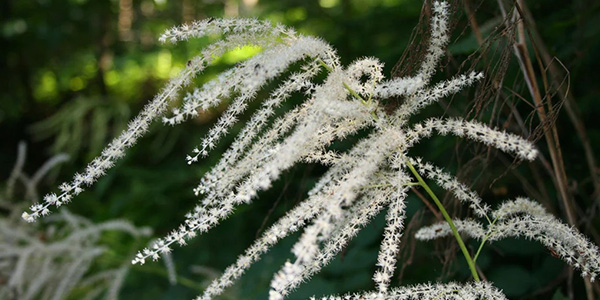
Local Name:Not specified
Family:Rosaceae (Rose family)
3 to 6 feet (0.9 to 1.8 meters)
Perennial (lives for several years)
- English Name: Goat's Beard
- Botanical Name: Aruncus dioicus
- Local Name: Not commonly known or used in India
- Flowering time: June to July
- Life span: Perennial, can live for several years
- Height of the plant: Typically grows to a height of 3 to 6 feet (0.9 to 1.8 meters)
- Size of the flower: The flowers are small and appear in dense, plume-like clusters that can reach up to 2 feet (0.6 meters) in length
- Family: Rosaceae (Rose family)
- Habitat: Native to Europe, Asia, and North America, it thrives in moist woodlands, stream banks, and shaded areas
- Uses:
- Ornamental purposes: Goat's Beard is popular in gardens and landscapes for its attractive plume-like flowers and fern-like foliage. It adds a delicate and graceful element to floral arrangements and bouquets.
- Wildlife habitat: The plant provides food and shelter for various insects, including bees and butterflies. The seeds are also consumed by birds.
- Erosion control: The deep roots of Aruncus dioicus help stabilize soil, making it useful for erosion control on slopes and banks.
- Medicinal properties: Some traditional herbal medicine systems use certain parts of the plant for their astringent, anti-inflammatory, and diuretic properties.
.jpg)
Local Name:Not specified
Family:Asteraceae (daisy family)
1 to 2 feet (30 to 60 cm.)
Perennial (lives for more than two years)
- English Name: White Aster
- Botanical Name: Aster albescens
- Local Name: Not specified (commonly known as White Aster)
- Flowering time: September to November
- Life span: Perennial (typically lives for more than two years)
- Height of the plant: Varies, but usually between 1 to 2 feet (30 to 60 cm)
- Size of the flower: Small to medium-sized, approximately 1 inch (2.5 cm) in diameter
- Family: Asteraceae (daisy family)
- Habitat: Found in various habitats including meadows, grasslands, open woodlands, and along roadsides.
- Uses:
- Ornamental purposes: The White Aster is often cultivated for its attractive flowers and is commonly used in gardens and floral arrangements.
- Pollinator support: The flowers attract bees, butterflies, and other pollinators, making it beneficial for biodiversity and ecosystem health.
- Medicinal applications: Some species of the Aster genus, though not specifically Aster albescens, have been traditionally used in herbal medicine to treat various ailments such as digestive disorders, respiratory issues, and inflammation.

Local Name:Not specified
Family:Asteraceae (Sunflower family)
Approximately 20-40 cm.
Perennial (lives for several years)
- English Name: Diplostephium Aster
- Botanical Name: Diplostephium diplostephioides
- Local Name: Not commonly known by a specific local name in India
- Flowering time: Late spring to early summer (May to June)
- Life span: Perennial (can live for several years)
- Height of the plant: Approximately 20-40 cm.
- Size of the flower: Small, typically around 1-2 cm. in diameter
- Family: Asteraceae (Sunflower family)
- Habitat: Native to high-altitude regions of the Andes in South America. In India, it is not indigenous but can be found in certain botanical gardens or specialized nurseries.
- Uses:
- Primarily cultivated as an ornamental plant for its attractive flowers. It can be grown in rock gardens, alpine gardens, or containers. The flowers are often used in floral arrangements or bouquets due to their delicate beauty.
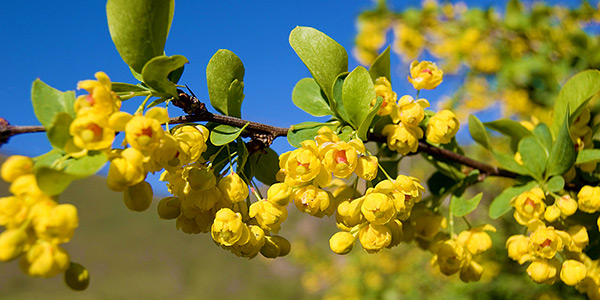
Local Name:Daruhaldi
Family:Berberidaceae
2-3 meters
Perennial
- English Name: Indian Barberry
- Botanical Name: Berberis aristata
- Local Name: Daruhaldi
- Flowering time: March to June
- Life span: Perennial
- Height of the plant: Typically grows up to 2-3 meters
- Size of the flower: Small yellow flowers, usually around 5-7 mm in diameter
- Family: Berberidaceae
- Habitat: Native to the Himalayan region of India, particularly found in the states of Himachal Pradesh, Uttarakhand, and Kashmir. It is also found in other parts of India, Nepal, and Bhutan.
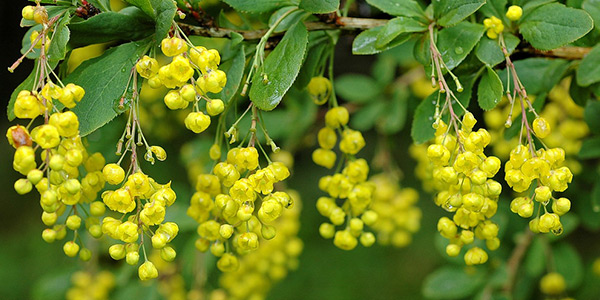
Local Name:Not specified
Family:Berberidaceae
2 to 3 meters (6.5 to 10 feet)
Perennial (long-lived)
- English Name: Jaeschke's Barberry
- Botanical Name: Berberis jaeschkeana
- Local Name: Not specified
- Flowering time: April to May
- Life span: Perennial (long-lived)
- Height of the plant: 2 to 3 meters (6.5 to 10 feet)
- Size of the flower: Small, yellow flowers
- Family: Berberidaceae
- Habitat: Native to the western Himalayas, found in rocky areas and forests
- Uses:
- Ornamental plant: Cultivated for its attractive foliage and flowers
- Medicinal: Some species of Berberis have traditional medicinal uses, although specific uses for Berberis jaeschkeana are not mentioned specifically.
- Wildlife support: The flowers provide a nectar source for pollinators, and the berries may be consumed by birds and small mammals.
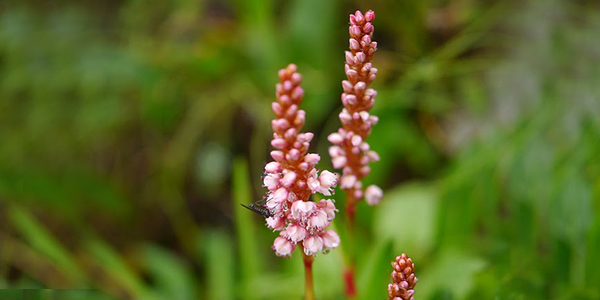
Local Name:Not specified
Family:Polygonaceae
grows up to 30 to 60 cm.
Perennial
- English Name: Flower Bistorta Affinis
- Botanical Name: Bistorta affinis
- Local Name: Indian Bistort
- Flowering time: June to August
- Life span: Perennial
- Height of the plant: Typically grows up to 30-60 cm in height
- Size of the flower: The flowers are small, approximately 1-2 cm in diameter
- Family: Polygonaceae
- Habitat: Found in the temperate regions of the Himalayas, particularly in the states of Himachal Pradesh, Uttarakhand, and Jammu and Kashmir.
- Uses:
- Ornamental: Flower Bistorta Affinis is often cultivated for its attractive flowers and foliage, making it a popular choice in gardens and landscapes.
- Medicinal: In traditional medicine, various parts of the plant are used for treating ailments like diarrhea, dysentery, and hemorrhoids.
- The roots are particularly valued for their astringent and anti-inflammatory properties.
- Ecological: Flower Bistorta Affinis plays a vital role in supporting local biodiversity by providing nectar and pollen for pollinators, including bees and butterflies. It also serves as a food source for some herbivorous animals.
- Erosion control: The plant's dense root system helps stabilize soil, making it useful in erosion control efforts.
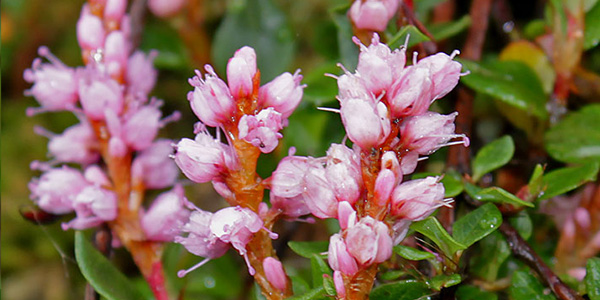
Local Name:Not specified
Family:Polygonaceae (Buckwheat family)
10-20 cm.
Perennial (lives for several years)
- English Name: Alpine Bistort
- Botanical Name: Bistorta vaccinifolia
- Local Name: Not commonly known by a specific local name
- Flowering time: June to August
- Life span: Perennial plant, can live for several years
- Height of the plant: Usually grows up to 10-20 cm. in height
- Size of the flower: The flowers are small and clustered in dense spikes, measuring around 0.5 to 1 centimeter in diameter
- Family: Polygonaceae (Buckwheat family)
- Habitat: Native to the alpine and subalpine regions of the Himalayas, it can be found in areas with moist, rocky soil and ample sunlight
- Uses:
- Ornamental plant: Due to its attractive flowers and foliage, it is cultivated as an ornamental plant in gardens and rockeries
- Medicinal uses: Some traditional systems of medicine use various parts of the plant for treating ailments like diarrhea, dysentery, and fever. However, it is important to note that the efficacy and safety of such uses have not been extensively studied.
- Ecological value: Bistorta vaccinifolia plays a role in alpine ecosystems by providing habitat and food for pollinators and other wildlife.
- Soil erosion control: Its dense root system helps stabilize soil on slopes and prevent erosion.
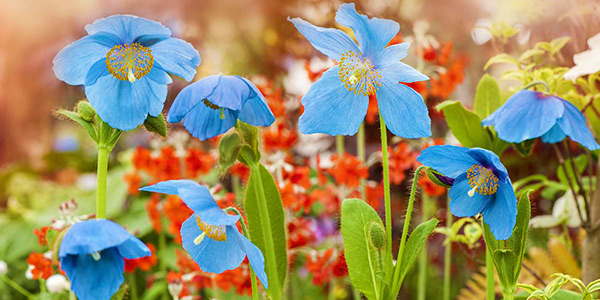
Local Name:Neela Posta
Family:Papaveraceae (Poppy family)
2 to 4 feet (60 to 120 cm) tall
Perennial (lives for several years)
- English Name: Blue Poppy
- Botanical Name: Meconopsis betonicifolia
- local name: Neela Posta
- Flowering time: May to June
- Life span: Perennial (can live for several years)
- Height of the plant: Typically grows up to 2 to 4 feet (60 to 120 cm) tall
- Size of the flower: The flowers are large and showy, measuring around 3 to 4 inches (7.5 to 10 cm) in diameter
- Family: Papaveraceae (Poppy family)
- Habitat: Native to the higher regions of the Himalayas, particularly in Bhutan, Nepal, and Tibet. It thrives in cool, moist alpine environments.
- Uses:
- Ornamental purposes: Blue Poppies are highly sought after for their vibrant blue flowers, making them popular in gardens and landscapes.
- Medicinal uses: Some species of Meconopsis, including the Blue Poppy, have been used in traditional medicine for various purposes. They are believed to have anti-inflammatory, analgesic, and sedative properties.
- Symbolic value: The Blue Poppy is considered a symbol of beauty, purity, and mysticism. It holds cultural significance in regions where it is found, often representing the enchanting and delicate aspects of nature.
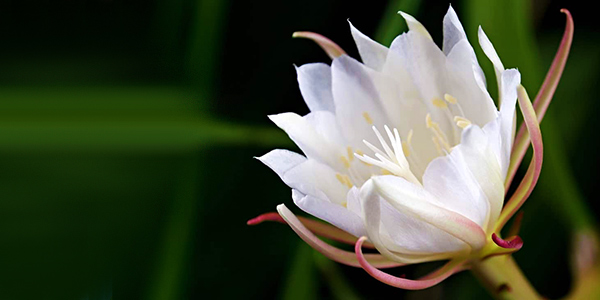
Local Name:Brahma Kamal
Family:Asteraceae (Sunflower family)
30-40 cm. tall
Perennial (lives for several years)
- English Name: Flower Brahma Kamal (Saussurea Obvallata)
- Botanical Name: Saussurea Obvallata
- Local Name: Brahma Kamal, King of Himalayan Flowers
- Flowering time: June to September
- Life span: Perennial (can live for many years)
- Height of the plant: Typically grows up to 30-40 cm. tall
- Size of the flower: Large, measuring around 15-20 cm. in diameter
- Family: Asteraceae (Sunflower family)
- Habitat: Found in the higher regions of the Himalayas, specifically in the alpine zones at altitudes of 3,000 to 4,500 meters
- Uses:
- Culturally significant flower in India, especially in the states of Uttarakhand and Himachal Pradesh
- Often considered sacred and associated with Hindu mythology and spirituality
- Used in religious ceremonies and offerings to deities
- Medicinally, the flower and other parts of the plant are used in traditional Ayurvedic and Tibetan medicine for their therapeutic properties
- Conservation efforts are in place to protect and preserve the Brahma Kamal due to its rarity and ecological importance.
.jpg)
Local Name:Not specified
Family:Ranunculaceae
30-90 cm (12-35 inches)
Perennial (long-lived)
- English Name: Marsh Marigold
- Botanical Name: Caltha palustris
- Local Name: Not applicable; not native to India
- Flowering time: April to June
- Life span: Perennial (long-lived)
- Height of the plant: 30-90 cm (12-35 inches)
- Size of the flower: 3-5 cm (1-2 inches) in diameter
- Family: Ranunculaceae
- Habitat: Marshes, wetlands, streams, and damp meadows
- Uses:
- Ornamental plant: Marsh Marigold is often grown in gardens for its attractive yellow flowers.
- Medicinal uses: In traditional herbal medicine, various parts of the plant are used to treat conditions like rheumatism, urinary problems, and respiratory ailments.
- Wildlife support: The plant provides nectar and pollen for bees, butterflies, and other insects, and its leaves serve as a food source for some herbivorous insects.
- Environmental significance: Caltha palustris plays a role in stabilizing wetland ecosystems, preventing soil erosion, and improving water quality.
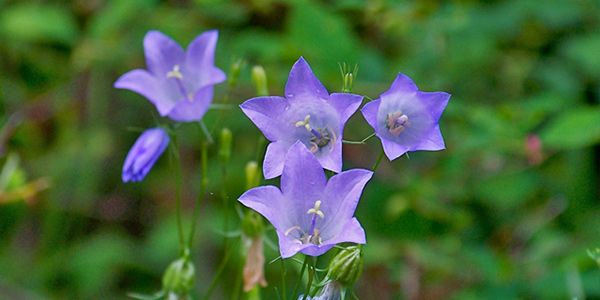
Local Name:
Family:Campanulaceae (Bellflower family)
2 to 4 feet (60 to 120 cm)
Perennial (lives for several years)
- English Name: Giant Bellflower
- Botanical Name: Campanula latifolia
- Local Name: Not commonly known by a specific local name in India
- Flowering time: June to August
- Life span: Perennial (can live for several years)
- Height of the plant: Typically grows to a height of 2 to 4 feet (60 to 120 cm)
- Size of the flower: The flowers are large, bell-shaped, and can reach a size of 1 to 2 inches (2.5 to 5 cm) in diameter
- Family: Campanulaceae (Bellflower family)
- Habitat: Found in temperate regions, often in meadows, woodlands, and along forest edges. It prefers well-drained soil and partial shade.
- Uses:
- Ornamental purposes: The Giant Bellflower is cultivated as an ornamental plant in gardens for its beautiful flowers.
- Pollinator support: The flowers attract bees, butterflies, and other pollinators, making it beneficial for pollinator gardens.
- Medicinal uses: In some traditional systems of medicine, various parts of the plant are used for their medicinal properties.,For example, the roots are believed to have diuretic and laxative effects.
- Wildlife habitat: The plant provides food and shelter for insects and small animals.
- Cut flower: The flowers can be used in floral arrangements and bouquets.
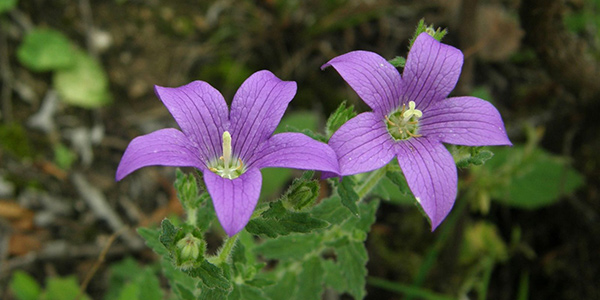
Local Name:Not specified
Family:Campanulaceae (Bellflower family)
1 to 2 feet (30 to 60 cm.)
Perennial (lives for several years)
- English Name: Pale Bellflower
- Botanical Name: Campanula pallida
- Local Name: Not commonly known by a specific local name in India.
- Flowering time: June to September
- Life span: Perennial, can live for several years
- Height of the plant: Typically grows up to 30-60 cm (1-2 feet) tall
- Size of the flower: The flowers are small, typically around 2-3 cm (0.8-1.2 inches) in diameter
- Family: Campanulaceae (Bellflower family)
- Habitat: Native to the Balkans in southeastern Europe, but can also be found in other parts of Europe and Asia.
- In India, it can be grown in gardens or cultivated in suitable conditions.
- Uses:
- Ornamental: Campanula pallida is popular as an ornamental plant due to its attractive bell-shaped flowers and delicate appearance. It is often used in gardens, borders, and rockeries.
- Cut flowers: The flowers of Campanula pallida can be cut and used in floral arrangements or bouquets.
- Medicinal: Some species of Campanula are used in traditional medicine for various purposes, but specific medicinal uses for Campanula pallida are not widely known.
- Pollinator attractant: The flowers of Campanula pallida attract bees and other pollinators, making them beneficial for supporting local ecosystems and promoting biodiversity.
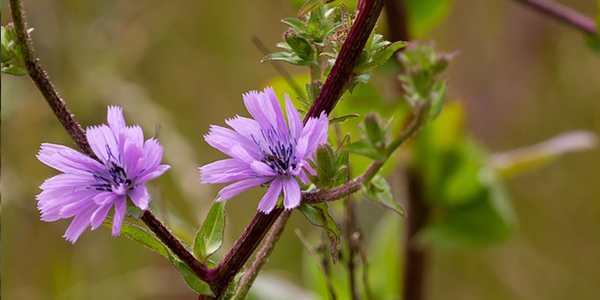
Local Name:Not specified
Family:Asteraceae (Daisy family)
1-2 meters in height
Perennial two years
- English Name: Large-rooted Cicerbita
- Botanical Name: Cicerbita macrorhiza
- Local Name: Not commonly known by a specific local name in India
- Flowering: Typically flowers in the months of June to August
- Life span: Generally a biennial plant, completing its life cycle within two years
- Height of the plant: Can grow up to 1-2 meters in height
- Size of the flower: The flower heads are usually small to medium-sized, measuring around 2-3 cm. in diameter
- Family: Asteraceae (Daisy family)
- Habitat: Native to the temperate regions of Europe and Asia, including the Himalayan regions of India. It thrives in moist, shady areas, such as forests, woodland edges, and grasslands.
- Uses:
- Culinary: Some parts of the plant, such as young leaves and shoots, can be consumed in salads or cooked as a vegetable.
- Medicinal: Traditional herbal medicine utilizes the roots and leaves of Cicerbita macrorhiza for various purposes, including aiding digestion and treating liver and gallbladder disorders.
- Ornamental: The attractive blue-purple flowers make it suitable for ornamental purposes in gardens and landscaping.
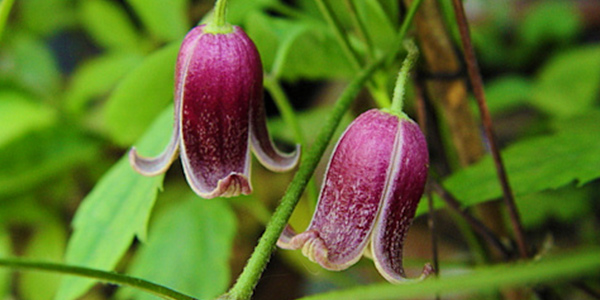
Local Name:Not specified
Family:Ranunculaceae
Up to 1.5 meters (5 feet)
Perennial (long-lived)
- English Name: Flower Clematis barbellata
- Botanical Name: Clematis barbellata
- Local Name: Not specified
- Flowering time: April to June
- Life span: Perennial (long-lived)
- Height of the plant: Up to 1.5 meters (5 feet)
- Size of the flower: Small to medium-sized flowers
- Family: Ranunculaceae
- Habitat: Native to the Himalayas, found in mountainous regions of India, Nepal, Bhutan, and Tibet.
- Uses:
- Ornamental purposes: Flower Clematis barbellata is often grown in gardens for its attractive flowers.
- Medicinal properties: Some species of Clematis have been used in traditional medicine for their therapeutic properties, but specific uses for Clematis barbellata are not mentioned. It is advisable to consult a healthcare professional before using any plant for medicinal purposes.
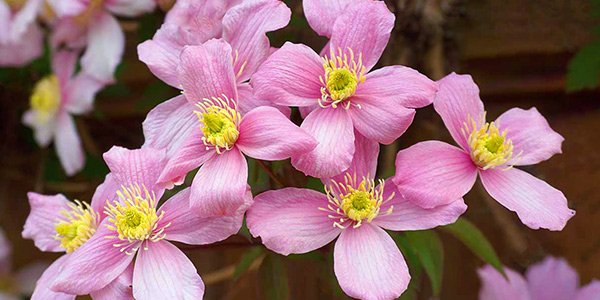
Local Name:Not specified
Family:Ranunculaceae (Buttercup family)
10-15 feet (3-4.5 meters)
Perennial (Can live for several decades)
- English Name: Clematis montana
- Botanical Name: Clematis montana
- Local Name: Not specific to India, but commonly known as "Clematis" or "Mountain Clematis"
- Flowering time: Typically blooms in late spring or early summer (May to June)
- Life span: Can live for several decades with proper care and maintenance
- Height of the plant: Can reach a height of up to 10-15 feet (3-4.5 meters)
- Size of the flower: The flowers are small to medium-sized, typically measuring around 1.5 to 2 inches (3.8 to 5 cm.) in diameter.
- Family: Ranunculaceae (Buttercup family)
- Habitat: Native to the mountainous regions of the Himalayas, it is found growing in forests and along the edges of woodland areas.
- Uses:
- Ornamental: Clematis montana is widely cultivated as an ornamental plant due to its beautiful flowers and vigorous growth . It is often trained to grow on fences, trellises, or pergolas, providing a stunning display of blossoms.
- It is often trained to grow on fences, trellises, or pergolas, providing a stunning display of blossoms.
- Climbing plant: With its twining stems, Clematis montana is an excellent choice for covering walls, arbors, and other structures, adding a touch of beauty and elegance to the garden.
- Pollinator attractant: The flowers of Clematis montana are attractive to bees, butterflies, and other pollinators, making it a valuable plant for supporting biodiversity in the garden.
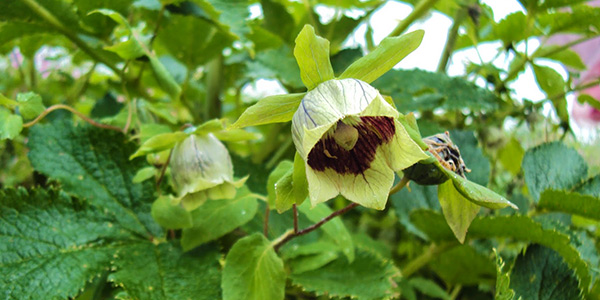
Local Name:Gokhru
Family:Campanulaceae
130-60 cm (1-2 feet)
Perennial
- English Name: Round-Leaved Bellflower
- Botanical Name: Codonopsis rotundifolia
- Local Name: Gokhru
- Flowering time: June to August
- Life span: Perennial
- Height of the plant: 30-60 cm (1-2 feet)
- Size of the flower: 2-3 cm (0.8-1.2 inches) in diameter
- Family: Campanulaceae
- Habitat: Found in the temperate regions of India, particularly in the Himalayan region.
- Uses:
- Medicinal: The roots of Codonopsis rotundifolia are used in traditional medicine for various purposes, such as boosting the immune system, improving digestion, and treating respiratory disorders.
- Ornamental: The attractive bell-shaped flowers make it a popular choice for garden cultivation, adding beauty to landscapes and flower beds.
- Culinary: In some cultures, the young shoots and leaves of the plant are consumed as a leafy vegetable.
- Traditional uses: It is believed to have tonic properties and is used in herbal formulations for promoting overall well-being.
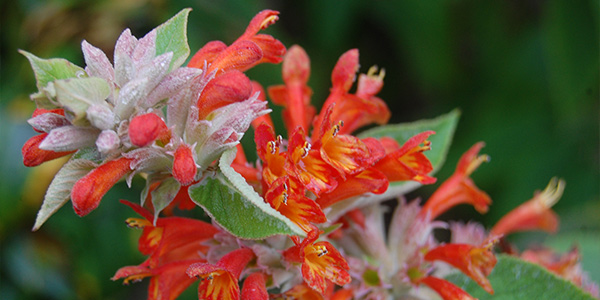
Local Name:Colquhounia, Lal Hinsal
Family:Lamiaceae (Mint family)
1-2 meters
Perennial
- English Name: Scarlet Plume
- Botanical Name: Colquhounia coccinea
- Local Name: Colquhounia, Lal Hinsal
- Flowering time: July to September
- Life span: Perennial
- Height of the plant: 1-2 meters
- Size of the flower: Small, tubular, about 2-3 cm. long
- Family: Lamiaceae (Mint family)
- Habitat: Native to the Himalayan region, found in forests, hillsides, and shrublands
- Uses:
- Ornamental: Cultivated for its attractive scarlet flowers and decorative foliage
- Medicinal: Used in traditional herbal medicine for various ailments
- Beekeeping: Flowers attract pollinators, making it beneficial for honey production
- Erosion control: Planting on slopes and banks helps prevent soil erosion
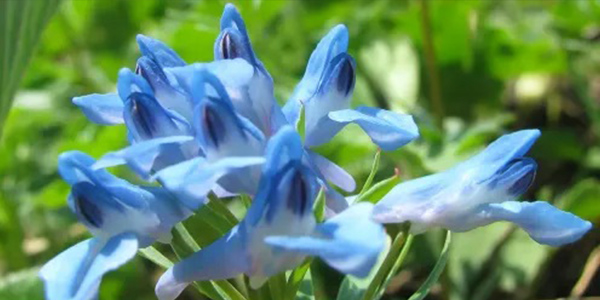
Local Name:Kasboora (Kashmiri)
Family:Papaveraceae
20-30 cm.
Perennial
- English Name: Flower Corydalis Cashmeriana
- Botanical Name: Corydalis cashmeriana
- Local Name: Kasboora (Kashmiri)
- Flowering time: April to June
- Life span: Perennial
- Height of the plant: 20-30 cm.
- Size of the flower: Small, typically 1-2 cm. in length
- Family: Papaveraceae
- Habitat: Native to the Himalayan region, found in Kashmir and other parts of northern India
- Uses:
- Ornamental plant: Flower Corydalis Cashmeriana is cultivated for its beautiful flowers and is often grown in gardens or used in floral arrangements.
- Traditional medicine: Some parts of the plant are used in traditional medicine for their potential medicinal properties.
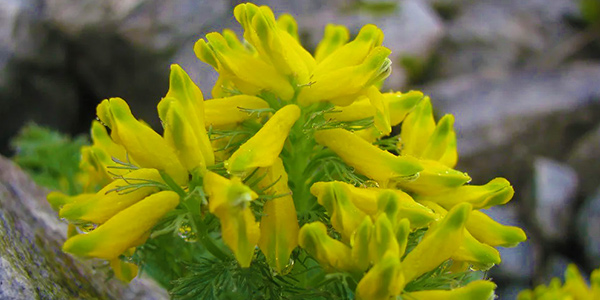
Local Name:Not specified
Family:Papaveraceae (Poppy family)
1 to 2 feet (30 to 60 cm.)
Perennial (lives for several years)
- English Name: Flower Corydalis meifolia
- Botanical Name: Corydalis meifolia
- Local Name: Not specified (It may have regional/local names specific to certain areas in India)
- Flowering time: Typically blooms in spring (March to May)
- Life span: Perennial plant, can live for several years
- Height of the plant: Generally grows up to 30-60 cm in height
- Size of the flower: Small to medium-sized flowers, approximately 1-2 cm in diameter
- Family: Papaveraceae (Poppy family)
- Habitat: Native to the Himalayan region, found in temperate forests and alpine meadows
- Uses:
- Ornamental plant: Cultivated for its attractive flowers in gardens and landscapes
- Medicinal properties: Some species of Corydalis are used in traditional medicine for various ailments, but specific uses for Corydalis meifolia are not mentioned in the available information.
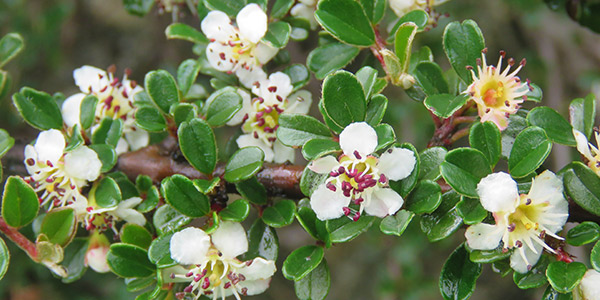
Local Name:Not specified
Family:Rosaceae (Rose family)
2 to 3 feet (60 to 90 cm.)
Perennial (lives for several years)
- English Name: Flower Cotoneaster
- Botanical Name: Cotoneaster microphyllus
- Local Name: Not specified, but commonly known as Flower Cotoneaster or Small-Leaved Cotoneaster
- Flowering time: Typically blooms in late spring to early summer (May to June)
- Life span: Can live for several decades
- Height of the plant: Generally grows to a height of 2 to 3 feet (60 to 90 cm.)
- Size of the flower: Small, typically around 1/4 inch (6 millimeters) in diameter
- Family: Rosaceae (Rose family)
- Habitat: Native to China, but widely cultivated and naturalized in various regions, including India.
- Thrives in temperate climates and can adapt to a wide range of soil conditions.
- Uses:
- Ornamental purposes: Flower Cotoneaster is often cultivated as an ornamental plant for its attractive flowers and foliage.
- Erosion control: Its dense growth and root system make it useful for preventing soil erosion on slopes and banks.
- Wildlife support: The flowers and subsequent berries provide a valuable food source for bees, birds, and other pollinators.
- Hedge or shrubbery: Flower Cotoneaster can be used to create hedges or as a shrub in gardens and landscapes due to its dense growth habit.
- Soil stabilization: The plant's extensive root system aids in stabilizing soil, making it useful in areas prone to erosion.
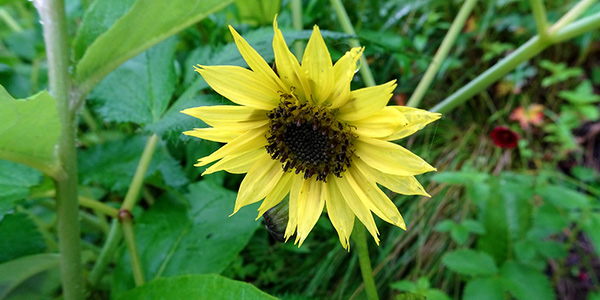
Local Name:Not specified
Family:Asteraceae (Compositae) family
30-60 cm. (12-24 inches)
Perennial (lives for several years)
- English Name: Arnicoides Flower Cremanthodium
- Botanical Name: Cremanthodium arnicoides
- Local Name: Not specified (commonly known as Arnicoides Flower Cremanthodium)
- Flowering time: July to August
- Life span: Perennial (can live for several years)
- Height of the plant: Approximately 30-60 cm. (12-24 inches)
- Size of the flower: The flower heads are usually small, around 2-3 cm. (0.8-1.2 inches) in diameter
- Family: Asteraceae (Compositae) family
- Habitat: Native to the alpine regions of the Himalayas, found in high-altitude meadows and rocky slopes
- Uses:
- Primarily admired for its ornamental value; it is often grown in gardens and used in floral arrangements. It also holds medicinal properties in some traditional practices.
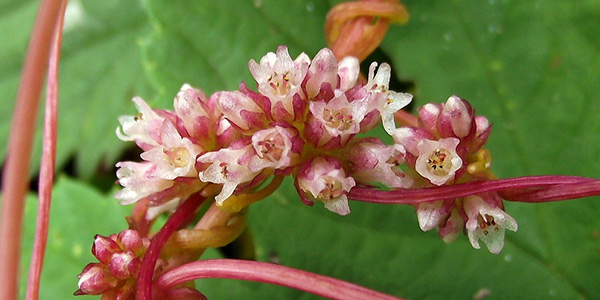
Local Name:Not specified
Family:Convolvulaceae
2-3 mm in diameter
Perennial (Annual)
- English Name: European dodder
- Botanical Name: Cuscuta europaea
- Local Name: Not specified
- Flowering time: June to August
- Life span: Annual
- Height of the plant: Variable, as it is a parasitic plant that grows on other plants
- Size of the flower: Small, approximately 2-3 mm in diameter
- Family: Convolvulaceae
- Habitat: Found in various habitats including grasslands, open woodlands, and disturbed areas
- Uses:
- Medicinal: Some traditional systems of medicine use Cuscuta europaea for its potential therapeutic properties.
- Ecological: Despite being a parasitic plant, it plays a role in ecosystem dynamics and nutrient cycling.
- Ornamental: Some gardeners may cultivate it for its unique appearance and interesting growth habit.
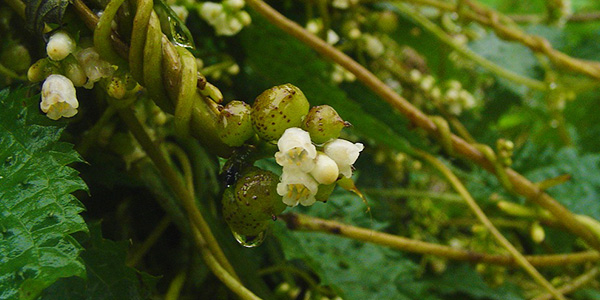
Local Name:Amar bel, Akash bel
Family:Convolvulaceae
several meters in length
Perennial (depending on the species)
- English Name: Dodder
- Botanical Name: Cuscuta reflexa
- Local Name: Amar bel, Akash bel
- Flowering time: July to September
- Life span: Annual or perennial depending on the species
- Height of the plant: Vines that can grow up to several meters in length
- Size of the flower: Small, typically less than 1 centimeter in diameter
- Family: Convolvulaceae
- Habitat: Commonly found in agricultural fields, gardens, and open areas
- Uses:
- Medicinal: In Ayurveda, Dodder is used for its therapeutic properties.
- It is believed to have anti-inflammatory, antioxidant, and antimicrobial effects.
- It is used to treat various ailments such as skin disorders, respiratory conditions, and digestive problems.
- Traditional: Dodder is sometimes used as a decorative plant for its delicate, thread-like vines. It can be grown on other plants or structures to create an aesthetic effect.
- Ecological: Dodder is a parasitic plant that attaches itself to the host plant, extracting nutrients and water from it. While it can be detrimental to cultivated crops, it also plays a role in ecological balance by providing shelter and food for certain insects and birds.
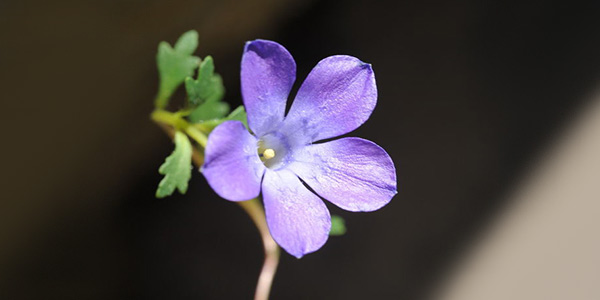
Local Name:Not specified
Family:Campanulaceae (Bellflower family)
20-30 cm. in height
Not specified
- English Name: Lobed Cyananthus
- Botanical Name: Cyananthus lobatus
- Local Name: Not specified in the provided information
- Flowering time: Typically blooms during the summer months, from May to July
- Life span: The average lifespan of Cyananthus lobatus is not specified in the provided information
- Height of the plant: The plant typically grows up to 20-30 cm. in height
- Size of the flower: The flowers of Cyananthus lobatus are small, measuring around 1-2 cm. in diameter
- Family: Campanulaceae (Bellflower family)
- Habitat: Found in alpine regions and rocky slopes of the Himalayan range, specifically in areas of Himachal Pradesh and Uttarakhand in India
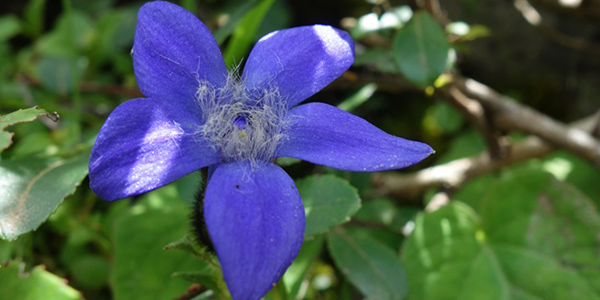
Local Name:Not specified
Family:Asteraceae (Composite family)
1 to 2 feet (30 to 60 cm.)
Perennial (lives for several years)
- English Name: Small-leaved Blue Star
- Botanical Name: Cyanatus microphyllus
- Local Name: Not specified
- Flowering time: Typically blooms in the spring and early summer months, around April to June.
- Life span: Perennial plant, can live for several years.
- Height of the plant: Generally grows up to 1-2 feet in height.
- Size of the flower: The flowers are small, typically measuring around 1 inch in diameter.
- Family: Belongs to the family Asteraceae (Composite family).
- Habitat: Native to North America, it is found in various habitats including prairies, meadows, open woodlands, and roadsides.
- In India, it may be found in specific regions or cultivated in gardens.
- Uses:
- Ornamental plant: Grown for its attractive blue flowers, which add beauty to gardens and landscapes.
- Pollinator attraction: The flowers of Cyanatus microphyllus attract bees, butterflies, and other pollinators, contributing to pollination and biodiversity.
- Cut flower: The small flowers can be used in floral arrangements or bouquets.
- Medicinal uses: Some species within the Cyanatus genus have traditional medicinal uses
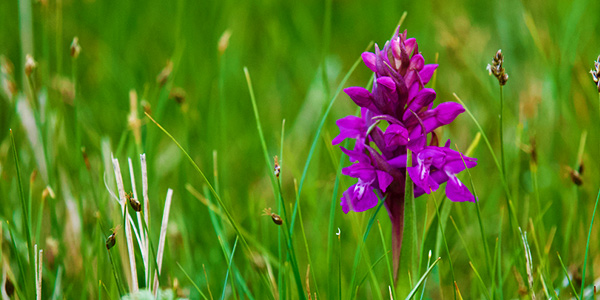
Local Name:Panchaule
Family:Orchidaceae
20-60 cm (8-24 inches)
Perennial
- English Name: Himalayan Marsh Orchid
- Botanical Name: Dactylorhiza hatagirea
- Local Name: Panchaule
- Flowering time: May to July
- Life span: Perennial
- Height of the plant: Typically 20-60 cm (8-24 inches)
- Size of the flower: Medium-sized, approximately 2-3 cm (0.8-1.2 inches) in diameter
- Family: Orchidaceae
- Habitat: Found in the Himalayan region, including India, Nepal, and Tibet, at elevations of 2,500 to 4,500 meters (8,200 to 14,800 feet).
- It prefers damp areas, such as marshes, meadows, and wetlands.
- Uses:
- Medicinal purposes: The rhizome of Dactylorhiza hatagirea has traditional medicinal uses in Ayurveda and Tibetan medicine. It is believed to possess various therapeutic properties, including anti-inflammatory, analgesic, and rejuvenating effects.
- Cultural significance: In some regions of India, the flower is considered sacred and used in religious ceremonies and rituals.
- Conservation: The species is protected in many areas due to its vulnerable status and overharvesting for medicinal purposes. Efforts are being made to conserve its natural habitats and promote sustainable practices.
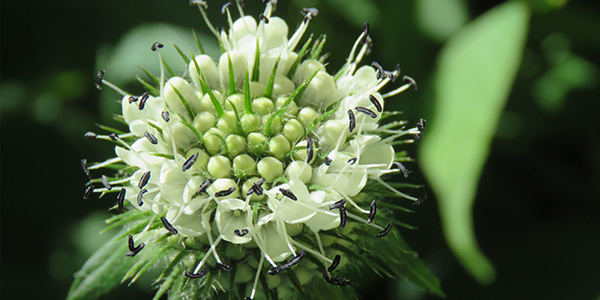
Local Name:Not specified
Family:Caprifoliaceae (Honeysuckle family)
1.5 to 2 meters tall
Perennial (Biennial or short-lived)
- English Name: Teasel
- Botanical Name: Dipsacus inermis
- Local Name: Not applicable (native to Europe and Western Asia)
- Flowering time: Typically blooms in summer, around June to August
- Life span: Biennial or short-lived perennial
- Height of the plant: Can grow up to 1.5 to 2 meters tall
- Size of the flower: The flower heads are cylindrical and measure about 5 to 8 cm in length
- Family: Caprifoliaceae (Honeysuckle family)
- Habitat: Thrives in open fields, grasslands, and disturbed areas
- Uses:
- Ornamental: The dried flower heads are often used in floral arrangements and crafts due to their unique shape and texture.
- Wildlife support: The plant provides nectar and pollen for bees, butterflies, and other pollinators.
- Textile industry: Historically, the hooked bracts of teasel were used in the textile industry for raising the nap on fabrics like wool, giving them a softer and more luxurious feel.
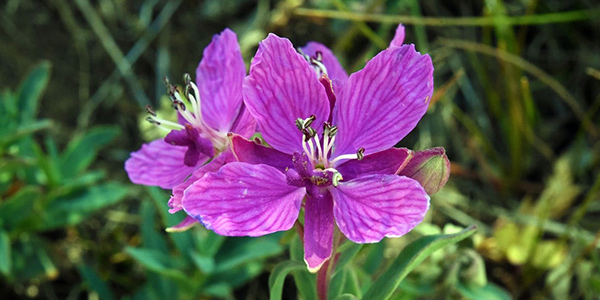
Local Name:Not specified
Family:Onagraceae (Evening Primrose family)
1.5 meters (4-5 feet)
Perennial (lives for several years)
- English Name: Willowherb or Broad-leaved Willowherb
- Botanical Name: Epilobium latifolium
- Local Name: Not commonly known by a specific local name in India.
- Flowering time: June to August
- Life span: Perennial plant, typically lives for several years.
- Height of the plant: Can reach a height of up to 1.5 meters (4-5 feet).
- Size of the flower: The flowers are relatively large, with a diameter of about 2-3 cm. (0.8-1.2 inches).
- Family: Onagraceae (Evening Primrose family)
- Habitat: Native to subarctic and alpine regions of Europe, Asia, and North America. In India, it is primarily found in the Himalayan region.
- Uses:
- Medicinal: Some traditional medicine systems use the plant for treating urinary tract infections, kidney stones, and prostate disorders.
- Wildlife: The flowers are a source of nectar for various pollinators, including bees and butterflies. The plant also serves as a food source
- Ornamental: The attractive flowers and tall growth make it a desirable plant for gardens and landscapes in suitable climates.
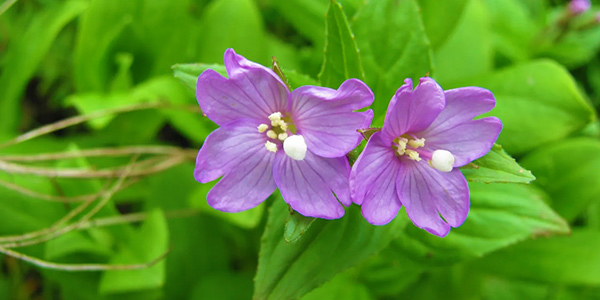
Local Name:Not specified
Family:Onagraceae (Evening Primrose family)
1-2 meters tall
Perennial (lives for several years)
- English Name: Slender Willowherb
- Botanical Name: Epilobium laxum
- Local Name: Not specified
- Flowering time: June to August
- Life span: Perennial (may live for several years)
- Height of the plant: Typically grows up to 1-2 meters tall
- Size of the flower: The flowers are small, about 1-2 cm in diameter
- Family: Onagraceae (Evening Primrose family)
- Habitat: Slender Willowherb is native to Europe and Western Asia. It can be found growing in wet meadows, marshes, ditches, and along rivers and streams. It can tolerate a variety of soil types and is often found in disturbed areas.
- Uses:
- Medicinal: Some species of the Epilobium genus, including Epilobium laxum, have been used in traditional medicine for various purposes. It is believed to have anti-inflammatory and diuretic properties and has been used to treat urinary tract problems, prostate issues, and gastrointestinal disorders.
- Wildlife: Slender Willowherb provides nectar and pollen for bees, butterflies, and other pollinators. It also serves as a host plant for the caterpillars of certain moth species.
- Ornamental: The attractive pink flowers and slender foliage make Epilobium laxum a desirable plant for gardens and landscaping.
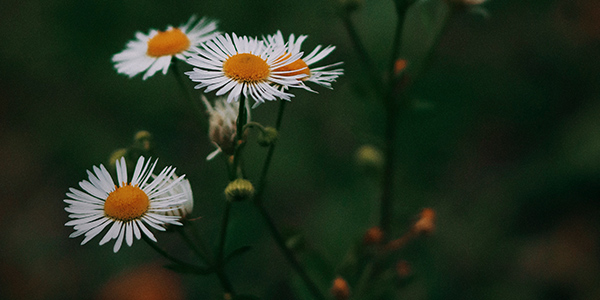
Local Name:Not specified
Family:Asteraceae (Composite or Daisy)
10-30 cm (4-12 inches)
Perennial (lives for several years)
- English Name: Daisy Fleabane
- Botanical Name: Erigeron bellidioides
- Local Name: Not commonly known by a specific local name in India
- Flowering time: Typically blooms from late spring to early summer (May to June)
- Life span: Perennial plant, can live for several years
- Height of the plant: Usually grows up to 10-30 cm (4-12 inches) in height
- Size of the flower: Small daisy-like flowers, typically 1-2 cm (0.4-0.8 inches) in diameter
- Family: Asteraceae (Composite or Daisy family)
- Habitat: Native to alpine regions, found in rocky or gravelly slopes, meadows, and alpine tundra habitats
- Uses:
- Ornamental plant: Often cultivated for its attractive flowers and low-growing habit, suitable for rock gardens, borders, or containers
- Medicinal uses: Some Erigeron species are used in traditional medicine for various purposes, although specific uses for Erigeron bellidioides are less documented
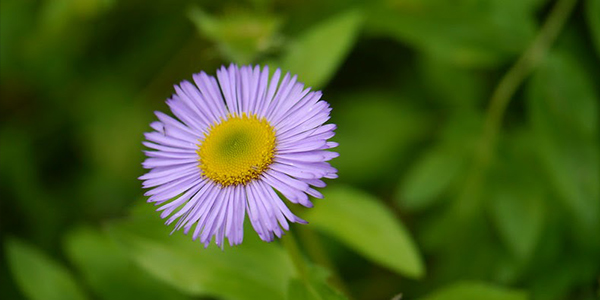
Local Name:Not specified
Family:Asteraceae (Aster family)
10-20 cm.
Perennial (lives for multiple years)
- English Name: Alpine Daisy
- Botanical Name: Erigeron multiradiatus
- Local Name: Not commonly known by a specific local name in India
- Flowering time: June to August
- Life span: Perennial plant, lives for multiple years
- Height of the plant: Typically grows up to 10-20 cm. in height
- Size of the flower: Small daisy-like flowers, approximately 1-2 cm. in diameter
- Family: Asteraceae (Aster family)
- Habitat: Native to North America, particularly found in alpine and subalpine regions. In India,
- it may be found in regions with similar climatic conditions such as high-altitude Himalayan meadows.
- Uses:
- Ornamental plant: Often cultivated for its attractive flowers in gardens, rockeries, and alpine plant collections.
- Medicinal purposes: Some species of Erigeron are used in traditional herbal medicine for various ailments, although specific uses for Erigeron multiradiatus may vary.
- Ecological value: As a native wildflower, it contributes to the biodiversity and ecological balance of its natural habitat, providing food and habitat for pollinators and other wildlife.
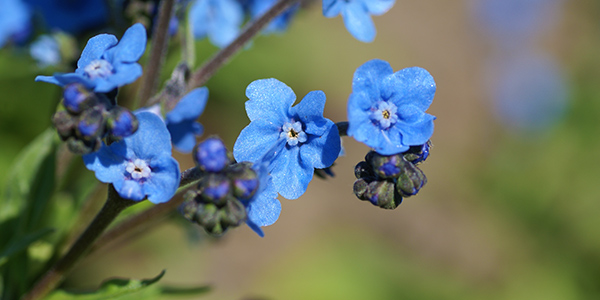
Local Name:Not specified
Family:Boraginaceae
10-30 cm.
Perennial (lives for multiple years)
- English Name: Alpine Forget-me-not
- Botanical Name: Eritrichium canum
- Local Name: Not commonly known by a specific local name in India
- Flowering time: June to August
- Life span: Perennial (typically lives for multiple years)
- Height of the plant: Usually grows up to 10-30 cm. in height
- Size of the flower: The flowers are small, measuring about 1 centimeter in diameter
- Family: Boraginaceae
- Habitat: Found in alpine and subalpine regions, usually on rocky slopes and meadows. It prefers well-drained soil and can tolerate cold temperatures.
- Uses:
- Ornamental purposes: Alpine Forget-me-not is often cultivated in gardens for its attractive blue flowers and its ability to thrive in rock gardens or containers.
- Medicinal uses: Some traditional medicinal practices use Eritrichium canum for its potential therapeutic properties, such as treating coughs and colds.
- Ecological significance: The plant is known to attract pollinators like bees and butterflies, contributing to local ecosystems' biodiversity and pollination processes.
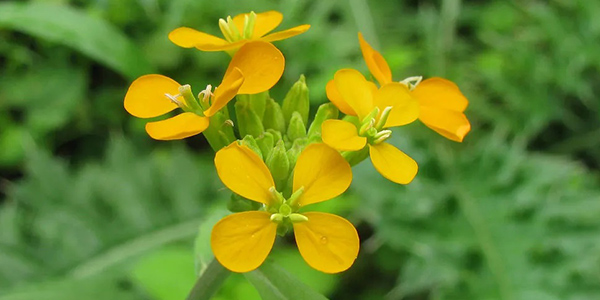
Local Name:Not specified
Family:Brassicaceae family
1 to 2 feet (30 to 60 cm.)
Perennial (lives for several years)
- English Name: Hawkweed-leaved Wallflower
- Botanical Name: Erysimum hieraciifolium
- Local Name: Not commonly known by a specific local name in India
- Flowering time: Typically blooms from late spring to early summer (May to June)
- Life span: Perennial plant, can live for several years
- Height of the plant: Usually reaches a height of 1 to 2 feet (30 to 60 cm.)
- Size of the flower: The flowers are small and measure around 1 inch (2.5 cm.) in diameter
- Family: Brassicaceae family, which includes cruciferous vegetables like broccoli and cabbage
- Habitat: Native to southern Europe, it is commonly found in dry, rocky habitats, including meadows, grasslands, and open woodlands.
- It can also be cultivated in gardens.
- Uses:
- Ornamental: Erysimum hieraciifolium is often grown in gardens for its attractive flowers and foliage.
- Pollinator plant: The flowers attract pollinators such as bees and butterflies, aiding in pollination.
- Medicinal: Some species of Erysimum have traditional medicinal uses, although specific uses for Erysimum hieraciifolium may vary.
- Erosion control: The plant's extensive root system helps stabilize soil, making it useful for erosion control on slopes and embankments.
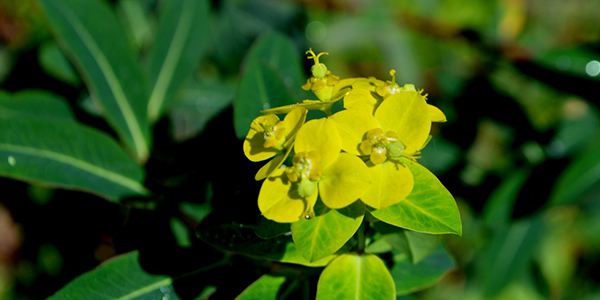
Local Name:Not specified
Family:Euphorbiaceae
30-60 cm (12-24 inches)
Perennial (lives for several years)
- English Name: Hairy Spurge
- Botanical Name: Euphorbia pilosa
- Local Name: Not specified
- Flowering time: Typically blooms in late spring to early summer
- Life span: Perennial plant, can live for several years
- Height of the plant: Generally reaches a height of about 30-60 cm (12-24 inches)
- Size of the flower: The flowers are small, approximately 1-2 mm in diameter
- Family: Euphorbiaceae
- Habitat: Native to southern Africa but also found in various parts of India and other tropical regions. It thrives in well-drained soils and can adapt to different habitats, including grasslands, rocky slopes, and open woodlands.
- Uses:
- Ornamental plant: The Hairy Spurge is often cultivated for its attractive foliage and unique flowers, making it a popular choice for gardens and landscapes.
- Medicinal properties: Some species of Euphorbia, including Euphorbia pilosa, are used in traditional medicine to treat various ailments such as skin infections, rheumatism, and respiratory disorders.
- Environmental benefits: Euphorbia pilosa, like other plants in the Euphorbiaceae family, plays a role in ecosystem stability and biodiversity by providing habitat and food for insects and other small organisms.
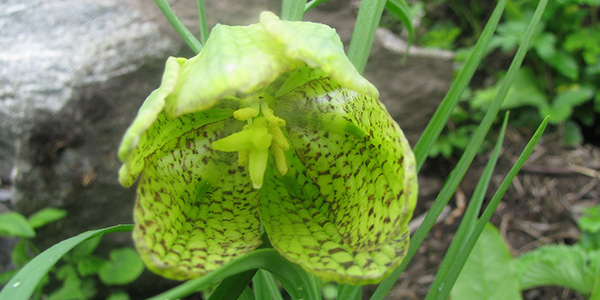
Local Name:Jammu and Kashmir Fritillary
Family:Liliaceae (Lily family)
1 to 2 feet (30 to 60 cm.)
Perennial (multiple years)
- English Name: Royle's Fritillary
- Botanical Name: Fritillaria roylei
- Local Name: Jammu and Kashmir Fritillary
- Flowering time: April to May
- Life span: Perennial (multiple years)
- Height of the plant: Approximately 30-60 cm.
- Size of the flower: 5-6 cm. in diameter
- Family: Liliaceae (Lily family)
- Habitat: Found in alpine meadows and subalpine regions of the Western Himalayas, particularly in Jammu and Kashmir, Himachal Pradesh, and Uttarakhand in India.
- Uses:
- Ornamental purposes: The beautiful flowers make it a popular choice for gardens and flower arrangements.
- Medicinal properties: Some species of Fritillaria, including Fritillaria roylei, have been used in traditional medicine for their potential therapeutic benefits, particularly in treating respiratory ailments such as coughs, bronchitis, and asthma. The bulbs and roots of the plant are often used in herbal preparations.
- Conservation: Fritillaria roylei is considered a vulnerable species in its native range due to habitat loss and over-harvesting. Efforts are being made to conserve and protect the plant in its natural habitat.
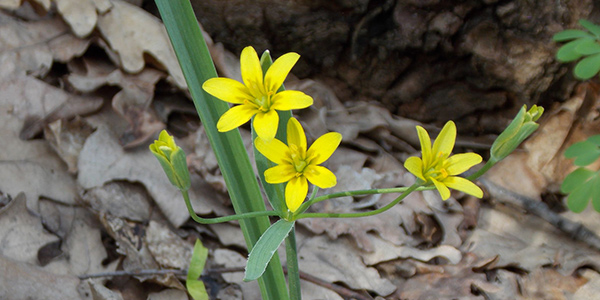
Local Name:Not specified
Family:Liliaceae
10-30 cm.
Perennial (lives for multiple years)
- English Name: Yellow Star-of-Bethlehem
- Botanical Name: Gagea lutea
- Local Name: Not specified
- Flowering time: March to April
- Life span: Perennial (multiple years)
- Height of the plant: Approximately 10-30 cm.
- Size of the flower: Small, typically around 1-2 cm. in diameter
- Family: Liliaceae
- Habitat: Grows in meadows, grasslands, open woodlands, and scrublands
- Uses:
- Ornamental plant: Yellow Star-of-Bethlehem is often cultivated for its attractive yellow flowers.
- Ecological role: The plant provides nectar and pollen for pollinators such as bees and butterflies.
- Medicinal uses: Some species in the Gagea genus have been used in traditional medicine for various purposes, although specific uses for Gagea lutea are not widely documented.
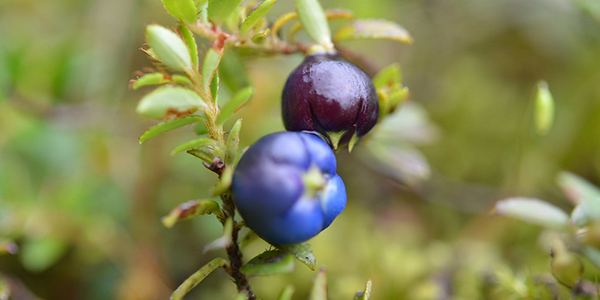
Local Name:Khasi Patta
Family:Ericaceae
15-30 cm.
Perennial (long-lived)
- English Name: Mountain Snowberry
- Botanical Name: Gaultheria trichophylla
- Local Name: Khasi Patta
- Flowering time: April to June
- Life span: Perennial (long-lived)
- Height of the plant: Typically 15-30 cm.
- Size of the flower: Small, bell-shaped flowers measuring approximately 1 centimeter in length
- Family: Ericaceae
- Habitat: Native to the Himalayan region, it is found in high-altitude forests, slopes, and meadows. It prefers cool and moist environments.
- Uses:
- Medicinal: Various parts of Gaultheria trichophylla, including leaves and berries, are used in traditional medicine for treating rheumatism, colds, coughs, and digestive disorders.
- Culinary: The berries of Gaultheria trichophylla are edible and have a slightly sweet and tangy flavor. They are sometimes used in the preparation of jams, jellies, and desserts.
- Ornamental: The plant's attractive evergreen foliage and colorful berries make it a popular choice for ornamental gardens and landscaping.
- Aromatic: The leaves of Gaultheria trichophylla have a distinct mint-like fragrance and are often used to make aromatic oils and scents.
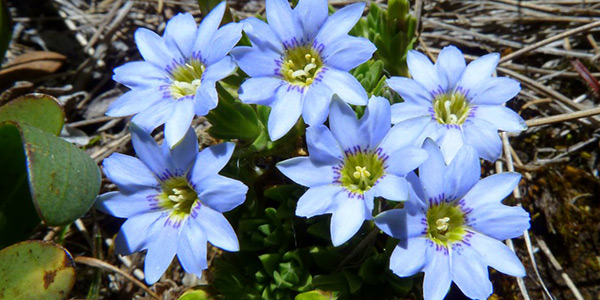
Local Name:Not specified
Family:Gentianaceae
10-30 cm.
Perennial (lives for several years)
- English Name: Gentiana pedicellata
- Botanical Name: Gentiana pedicellata
- Local Name: Not specified
- Flowering time: June to September
- Life span: Perennial (may live for several years)
- Height of the plant: Typically 10-30 cm.
- Size of the flower: Small to medium-sized flowers
- Family: Gentianaceae
- Habitat: Found in alpine meadows, grasslands, and rocky slopes in the Himalayan region of India,
- particularly in the states of Jammu and Kashmir, Himachal Pradesh, and Uttarakhand.
- Uses:
- Ornamental plant: The attractive flowers make it a popular choice for ornamental gardening.
- Medicinal purposes: Some species of Gentiana, including Gentiana pedicellata, have traditional medicinal uses.
- They are believed to have various properties, such as anti-inflammatory, anti-diabetic, and digestive benefits.
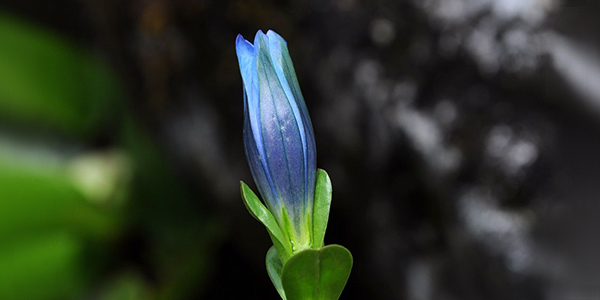
Local Name:Not specified
Family:Gentianaceae
10 to 40 cm.
Perennial (lives for several years)
- English Name: Flower Gentiana phyllocalyx
- Botanical Name: Gentiana phyllocalyx
- Local Name: Not specified
- Flowering time: Typically blooms from July to September
- Life span: Can live for several years
- Height of the plant: Varies, but generally ranges from 10 to 40 cm.
- Size of the flower: The flowers are usually small, measuring around 1 to 3 cm. in diameter
- Family: Gentianaceae
- Habitat: Found in alpine meadows, subalpine zones, and rocky slopes
- Uses:
- Ornamental: The flowers of Gentiana phyllocalyx are often admired for their beauty and can be grown in gardens or used in floral arrangements.
- Medicinal: Some species of Gentiana have traditional medicinal uses, and while specific uses for Gentiana phyllocalyx may vary, it is possible that it has similar applications in traditional medicine.
- Gentian plants are known for their bitter compounds and are sometimes used to stimulate digestion and treat gastrointestinal issues.
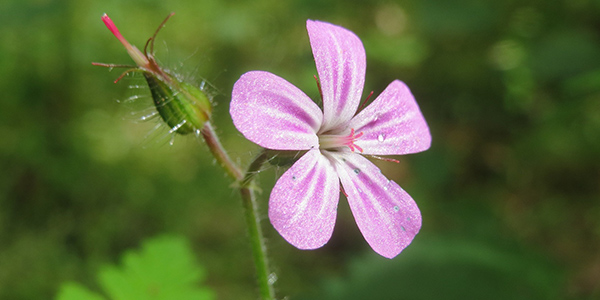
Local Name:Herb-Robert,Indian Geranium
Family:Geraniaceae
10-50 cm.
Perennial
- English Name: Herb-Robert
- Botanical Name: Geranium robertianum
- Local Name: Herb-Robert,Indian Geranium
- Flowering time: April to October
- Life span in: Perennial
- Height of the plant: 10-50 cm
- Size of the flower: Small, typically around 1 cm in diameter
- Family: Geraniaceae
- Habitat: Found in various habitats such as woodlands, hedgerows, meadows, and disturbed areas.
- Uses:
- Medicinal: The herb has been used in traditional medicine for its various medicinal properties. It is believed to have anti-inflammatory, diuretic, and astringent effects. It has been used to treat wounds, diarrhea, and urinary tract disorders.
- Culinary: The leaves of Geranium robertianum can be added to salads or used as a flavoring agent in herbal teas.
- Wildlife: The flowers of Herb-Robert attract pollinators such as bees and butterflies, making it beneficial for biodiversity in gardens and natural areas.
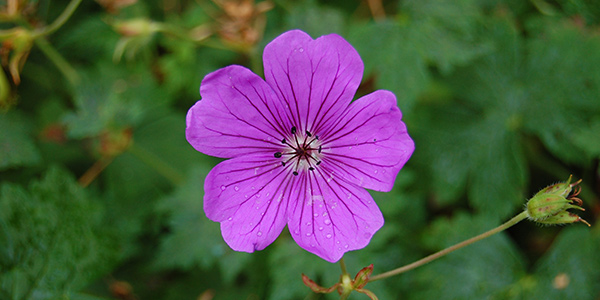
Local Name:Himalayan Geranium or Wallich's Geranium
Family:Geraniaceae
30 to 60 cm.
Perennial (lives for several years)
- English Name: Himalayan Cranesbill
- Botanical Name: Geranium wallichianum
- Local Name: Himalayan Geranium or Wallich's Geranium
- Flowering time: June to September
- Life span: Perennial (can live for several years)
- Height of the plant: Approximately 30 to 60 cm. (12 to 24 inches)
- Size of the flower: The flowers are small to medium-sized, usually measuring around 2 to 3 cm. (0.8 to 1.2 inches) in diameter.
- Family: Geraniaceae
- Habitat: Native to the Himalayan region, it can be found in various habitats such as meadows, forests, and slopes, typically at altitudes of 2,400 to 4,200 meters (7,900 to 13,800 feet) above sea level.
- Uses:
- Ornamental plant: The Himalayan Cranesbill is commonly cultivated for its attractive flowers and foliage, making it a popular choice for gardens and landscaping.
- Medicinal purposes: In traditional medicine, certain parts of the plant are used to treat various ailments, including diarrhea, dysentery, and inflammation.
- Bee and butterfly attractant: The flowers of Geranium wallichianum are nectar-rich and act as a food source for bees and butterflies, contributing to pollination and biodiversity.
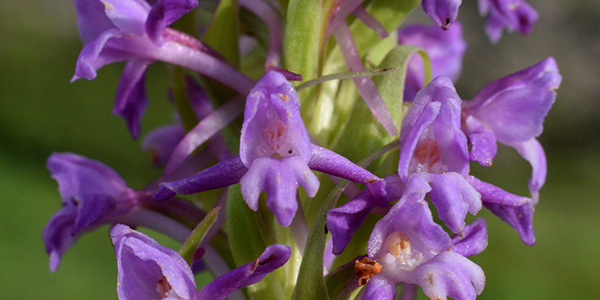
Local Name:Not specified
Family:Orchidaceae (Orchid family)
20 to 60 cm.
Perennial (lives for several years)
- English Name: Orchid Fragrant Orchis
- Botanical Name: Gymnadenia orchidis
- Local Name: Not commonly known by a specific local name in India
- Flowering time: Typically blooms in the summer months, from June to August
- Life span: Can live for several years, with some individual plants surviving for up to 10 years
- Height of the plant: Usually grows to a height of 20 to 60 cm.
- Size of the flower: The flowers are small to medium-sized, ranging from 1 to 2 cm. in diameter
- Family: Orchidaceae (Orchid family)
- Habitat: Found in various habitats such as meadows, grasslands, marshes, and open forests, often in mountainous regions
- Uses:
- Primarily appreciated for its aesthetic value, often used in ornamental gardening and flower arrangements.
- It may also play a role in supporting pollinators and contributing to local ecosystems.
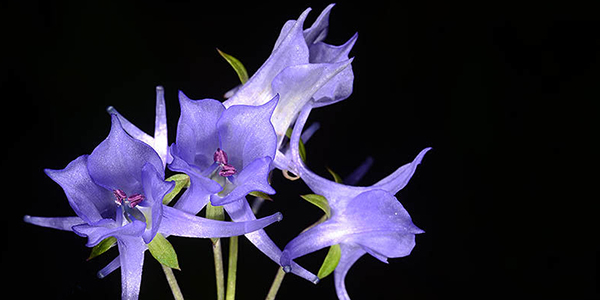
Local Name:Not specified
Family:Gentianaceae
20-60 centimeter
Perennial (long-lived)
- English Name: Elliptical Halenia
- Botanical Name: Halenia elliptica
- Local Name: Not specified
- Flowering time: July to September
- Life span in years: Perennial (long-lived)
- Height of the plant: Typically grows up to 20-60 cm. tall
- Size of the flower: Small, about 1-2 cm. in diameter
- Family: Gentianaceae
- Habitat: Found in alpine regions, meadows, and rocky slopes, especially in the Himalayan region of India.
- Uses:
- The plant is used in traditional medicine for various purposes, such as treating stomach ailments, fever, and respiratory disorders.
- It is also known for its anti-inflammatory and anti-diabetic properties. Additionally, Halenia elliptica is valued for its ornamental appeal and is sometimes grown in gardens for its attractive flowers.
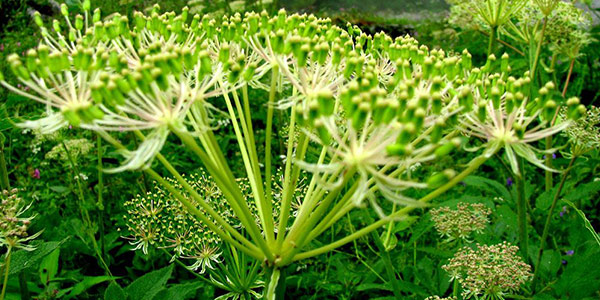
Local Name:Not specified
Family:Apiaceae (Umbelliferae) family.
2-3 meters (6-10 feet)
Biennial life cycle.
- English Name: Himalayan Cow Parsnip
- Botanical Name: Heracleum candicans
- Local Name: Not commonly known by a specific local name in India.
- Flowering time: Typically blooms from June to September.
- Life span: Generally, the plant has a biennial life cycle.
- Height of the plant: Can reach heights of 2-3 meters (6-10 feet) on average.
- Size of the flower: The flowers are typically small, forming clusters of white or pale pink umbels.
- Family: Apiaceae (Umbelliferae) family.
- Habitat: Native to the Himalayan region, the plant thrives in moist, cool, and shaded environments. It can be found growing in forests, meadows, and along streams.
- Uses:
- Medicinal: In traditional medicine, different parts of the plant are used for their therapeutic properties. The roots, leaves, and seeds contain compounds that are believed to have antispasmodic, diuretic, and anti-inflammatory effects. Extracts from the plant are also used in Ayurvedic medicine.
- Food: In some regions, the young shoots and leaves of Heracleum candicans are consumed as a vegetable, often cooked or pickled. However, caution must be exercised when handling or consuming the plant as it contains photosensitizing compounds that can cause skin irritation and burns when exposed to sunlight (phytophotodermatitis).
- Ornamental: Due to its impressive size and attractive flowers, Heracleum candicans is sometimes grown as an ornamental plant in gardens and parks. Its towering presence adds a dramatic element to landscapes.
- Wildlife: The flowers of Heracleum candicans attract pollinators such as bees and butterflies, contributing to the ecosystem's biodiversity.
- The plant also serves as a host for various insects and provides shelter for small animals.
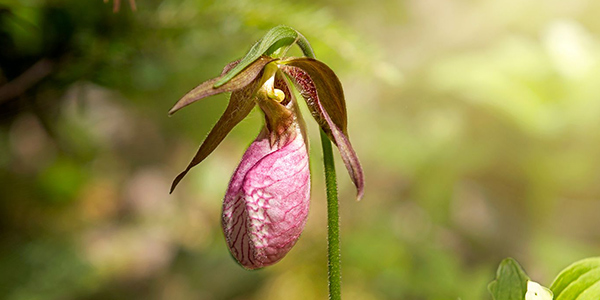
Local Name:Himalayan Slipper Orchid
Family:Orchidaceae
30-40 cm.(12-16 inches)
Perennial(15 to 20 years)
- English Name: Himalayan Slipper Orchid
- Botanical Name: Paphiopedilum wardii
- Local Name: N/A(Himalayan Slipper Orchid is commonly used)
- Flowering time: June to September
- Life span: Approximately 15 to 20 years
- Height of the plant: Typically grows up to 30-40 cm. (12-16 inches)
- Size of the flower: The flowers can reach a size of about 5-10 cm. (2-4 inches) in diameter
- Family: Orchidaceae
- Habitat: Native to the eastern Himalayas, specifically found in regions like Bhutan, Nepal, and northeastern India (Arunachal Pradesh, Sikkim, and Darjeeling)
- Uses:
- Primarily cultivated as an ornamental plant due to its unique and attractive slipper-shaped flowers.
- It is also used for hybridization with other orchid species to develop new cultivars. Additionally, some local communities in the region may use the plant for medicinal purposes or traditional rituals, although specific uses may vary.
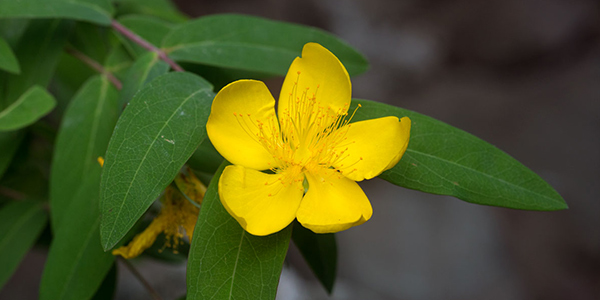
Local Name:Not specified
Family:Hypericaceae
1 to 3 feet (30 to 90 cm.)
Perennial (lives for several years)
- English Name: Oblong-leaved St. John's Wort
- Botanical Name: Hypericum oblongifolium
- Local Name: Not commonly known by a specific local name in India
- Flowering time: June to August
- Life span: Perennial (typically lives for several years)
- Height of the plant: Approximately 1 to 3 feet (30 to 90 cm.)
- Size of the flower: The flowers are small, measuring about 1 inch (2.5 cm.) in diameter
- Family: Hypericaceae
- Habitat: Native to the eastern United States and can be found in open woodlands, rocky slopes, and meadows
- Uses:
- Ornamental purposes: The plant is often cultivated for its attractive yellow flowers and oblong-shaped leaves, adding beauty to gardens and landscapes.
- Medicinal properties: Some species within the Hypericum genus, including Hypericum oblongifolium, have been traditionally used in herbal medicine for their potential antidepressant and anti-inflammatory properties.
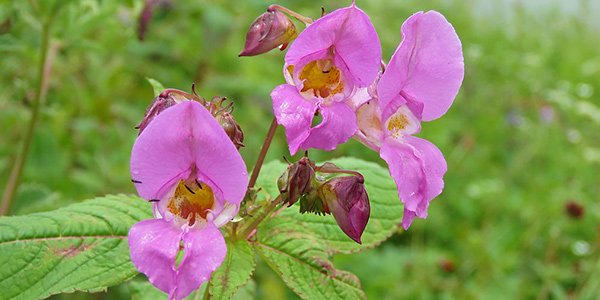
Local Name:Not specified
Family:Balsaminaceae
1 to 2 feet (30 to 60 cm.)
lives for 1 to 2 years
- English Name: Crested Balsam
- Botanical Name: Impatiens sulcata
- Local Name: Not specified in the available information
- Flowering time: Typically blooms from late spring to early autumn (May to September)
- Life span in years: Typically lives for 1 to 2 years
- Height of the plant: Can grow up to 1 to 2 feet in height
- Size of the flower: The flowers are small and delicate, measuring approximately 1 inch in diameter
- Family: Balsaminaceae
- Habitat: Native to the Eastern Himalayas and Southeast Asia, it can be found growing in moist, shaded areas, such as forest understories and along stream banks.
- Uses:
- Often cultivated as an ornamental plant for its attractive flowers, Crested Balsam is commonly used in gardens, parks, and landscapes to add color and beauty.
- It is also known for its ability to attract butterflies and other pollinators, contributing to the biodiversity of the area.
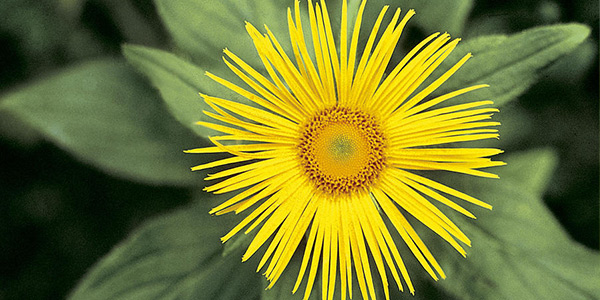
Local Name: Not specified
Family:Asteraceae
2 to 4 feet (60 to 120 cm).
3 to 5 years.
- English Name: Flower Inula grandiflora
- Botanical Name: Inula grandiflora
- Local Name: Not specified in the available information.
- Flowering time: Typically blooms in the summer months, from June to August.
- Life span: The average lifespan of Inula grandiflora is about 3 to 5 years.
- Height of the plant: The plant can grow to a height of approximately 2 to 4 feet (60 to 120 cm).
- Size of the flower: The flowers of Inula grandiflora are relatively large, measuring around 2 to 3 inches (5 to 7.5 cm) in diameter.
- Family: It belongs to the family Asteraceae, which is the aster or daisy family.
- Habitat: Inula grandiflora is native to Central Asia, specifically regions such as Kazakhstan, Kyrgyzstan, Tajikistan, and Uzbekistan. It thrives in meadows, slopes, and rocky areas at altitudes ranging from 1,500 to 3,000 meters.
- Uses:
- Inula grandiflora is primarily cultivated as an ornamental plant due to its attractive large flowers. It is often grown in gardens and flower beds for its aesthetic appeal.
- The plant is also known for its medicinal properties and has been traditionally used in herbal remedies for various ailments.
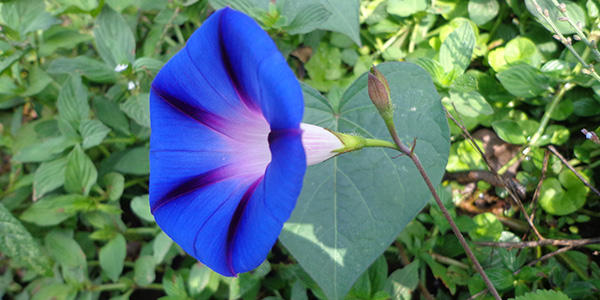
Local Name:Vishnukranti,Kailash Pushp
Family:Convolvulaceae
6 to 10 feet
Annual (lives for one year)
- English Name: Morning Glory
- Botanical Name: Ipomoea purpurea
- Local Name: Vishnukranti, Kailash Pushp
- Flowering time: June to September
- Life span: Annual (lives for one year)
- Height of the plant: Can grow up to 6 to 10 feet
- Size of the flower: Typically 2 to 3 inches in diameter
- Family: Convolvulaceae
- Habitat: Native to tropical regions of Central and South America, but widely cultivated and naturalized in India and other parts of the world.
- Uses:
- Ornamental purposes: Morning glory flowers are grown for their beautiful blooms and are commonly used in gardens, landscapes, and hanging baskets to add color and charm.
- Medicinal uses: In traditional medicine, various parts of the morning glory plant are used for their medicinal properties.
- They are believed to have laxative, diuretic, and purgative effects.
- Symbolism and spiritual significance: Morning glory flowers are associated with love, affection, and spirituality in different cultures. They are often used in rituals, ceremonies, and religious offerings.
- Ecological benefits: Morning glory plants can attract pollinators like bees and butterflies, thereby contributing to the ecosystem and promoting biodiversity. Seed production: Morning glory seeds are sometimes harvested for their decorative value or for propagation purposes.
- Some varieties of morning glory seeds are also edible and used in cooking or baking.
.jpg)
Local Name:Kaemaon Lily
Family:Iridaceae
30-45 cm(12-18 inches)
Perennial (multiple years)
- English Name: Kaemaon Iris
- Botanical Name: Iris kaemaonensis
- Local Name: Kaemaon Lily
- Flowering time: May-June
- Life span: Perennial (multiple years)
- Height of the plant: Typically grows up to 30-45 cm (12-18 inches)
- Size of the flower: The flowers are medium-sized, usually around 7-10 cm (3-4 inches) in diameter
- Family: Iridaceae
- Habitat: Found in the Kumaon region of the Himalayas in India, specifically in the Kaemaon Range.
- It thrives in mountainous regions and is often found in open meadows and rocky slopes.
- Uses:
- The Kaemaon Iris is primarily cultivated as an ornamental plant due to its attractive flowers.
- It is also used in traditional medicine for its potential medicinal properties.
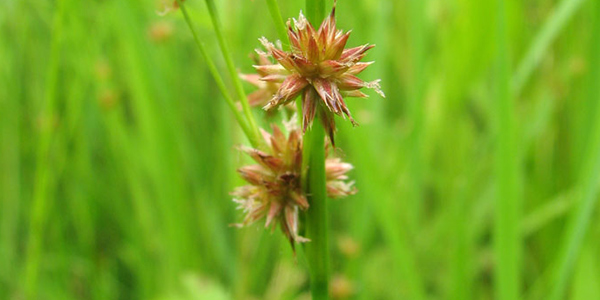
Local Name:Not specified
Family:Juncaceae (Rush family)
60-90 cm (2-3 feet)
Perennial (lives for multiple years)
- English Name: Himalayan Rush
- Botanical Name: Juncus himalensis
- Local Name: Not specified, as local names may vary regionally
- Flowering time: Generally blooms from June to September
- Life span: Perennial plant, typically living for multiple years
- Height of the plane: Can grow up to 60-90 cm (2-3 feet) in height
- Size of the flower: Small, inconspicuous flowers in clusters or inflorescences
- Family: Juncaceae (Rush family)
- Habitat: Found in the Himalayan region, particularly in damp or marshy areas such as wet meadows, bogs, and along stream banks
- Uses:
- Ecological importance: Provides habitat and food for various wildlife, including insects and birds.
- Soil stabilization: Its root system helps prevent soil erosion in wetland areas.
- Ornamental: Some gardeners may cultivate Juncus himalensis in water gardens or damp areas for its aesthetic appeal.
- Traditional uses: The local communities may have traditional medicinal uses for the plant, but these are specific to the region and not widely documented.
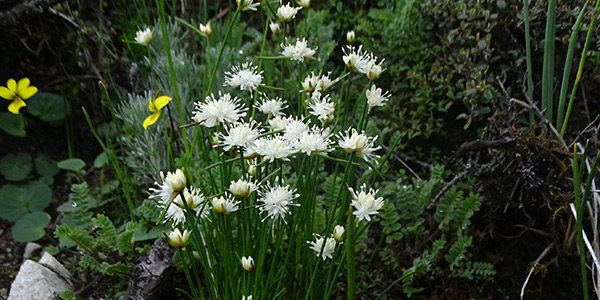
Local Name:Not specified
Family:Juncaceae (Rush family)
1 to 2 feet (30 to 60 cm.)
Perennial (lives for several years)
- English Name: Thomson's Rush
- Botanical Name: Juncus thomsonii
- Local Name in India: Not specified, as it is not commonly known by a local name.
- Flowering time in month: June to August
- Life span in year: Perennial (can live for several years)
- Height of the plant: Typically grows up to 30-60 cm in height
- Size of the flower: The flowers are small and inconspicuous, usually less than 1 cm in size
- Family: Juncaceae (Rush family)
- Habitat: Native to the high-altitude regions of the Western Himalayas and Tibet.
- It is found in damp meadows, marshes, and along streams and lakeshores.
- Uses:
- Ornamental: Thomson's Rush is cultivated as an ornamental plant in gardens and landscapes due to its attractive foliage and texture.
- Erosion control: The dense root system of the plant helps stabilize soil and prevent erosion, making it useful in landscaping projects.
- Wetland restoration: Juncus thomsonii is often used in wetland restoration projects to help improve water quality and create habitat for wildlife.
- Traditional medicine: In some traditional medicinal practices, various parts of the plant, such as the roots and stems, are used for their purported medicinal properties.
- Wildlife habitat: The dense clumps of Juncus thomsonii provide shelter and nesting sites for small birds and other wildlife species in wetland habitats.
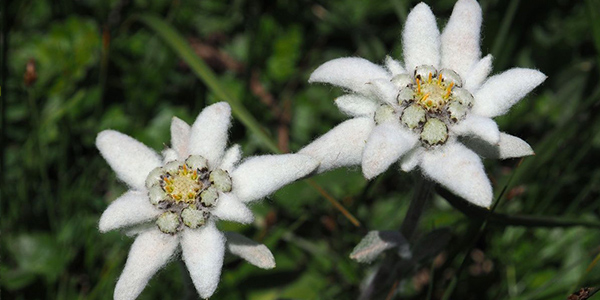
Local Name:Edelweiss
Family:Asteraceae (the aster or daisy family)
10-20 cm.
Perennial (lives for several years)
- English Name: Edelweiss
- Botanical Name: Leontopodium brachyactis
- Local Name: Edelweiss (same as the English name)
- Flowering time: Typically blooms from June to August
- Life span: Perennial plant, can live for several years
- Height of the plant: Typically grows up to 10-20 cm. in height
- Size of the flower: The flower head is small, about 2-3 cm. in diameter
- Family: Asteraceae (the aster or daisy family)
- Habitat: Native to mountainous regions of Europe, including the Alps, Pyrenees, and Carpathians. It is also found in some parts of Asia, including the Himalayas.
- Uses:
- Cultural significance: Edelweiss is considered a symbol of alpine beauty and is often associated with mountaineering and hiking. Ornamental plant: Edelweiss is cultivated as an ornamental plant in gardens and rockeries due to its unique and attractive white woolly flowers.
- Medicinal uses: In traditional herbal medicine, certain parts of the plant, such as the flowers and leaves, are used for their potential anti-inflammatory and antioxidant properties. They are also believed to have soothing effects on the skin.
- Souvenir and decorative purposes: Edelweiss flowers are sometimes collected and preserved as souvenirs or used in crafts and decorations, such as in dried flower arrangements or pressed flower art.
.jpg)
Local Name:Not specified
Family:Asteraceae family
1 to 2 meters
Perennial (lives for several years)
- English Name: Ligularia amplexicaulis
- Botanical Name: Ligularia amplexicaulis
- Local Name: Not commonly known by a specific local name in India
- Flowering time: Typically flowers in the summer months, from June to August
- Life span: Perennial plant, can live for several years
- Height of the plant: Usually grows to a height of 1 to 2 meters
- Size of the flower: The flowers are large and showy, measuring approximately 5-10 cm. in diameter
- Family: Asteraceae family (also known as the daisy family)
- Habitat: Native to the Himalayan region, including parts of India, Nepal, and Bhutan. It is commonly found in moist, shady areas, such as forest undergrowth and along streams or rivers.
- Uses:
- Ornamental: Ligularia amplexicaulis is commonly cultivated as an ornamental plant in gardens and landscapes due to its attractive foliage and striking flowers.
- Medicinal: Some species of Ligularia, including Ligularia amplexicaulis, have traditional medicinal uses in certain cultures. However, it's important to note that specific medicinal uses may vary and should be researched further.
- Environmental: Ligularia amplexicaulis is known to attract pollinators like bees and butterflies, contributing to biodiversity and ecosystem health.
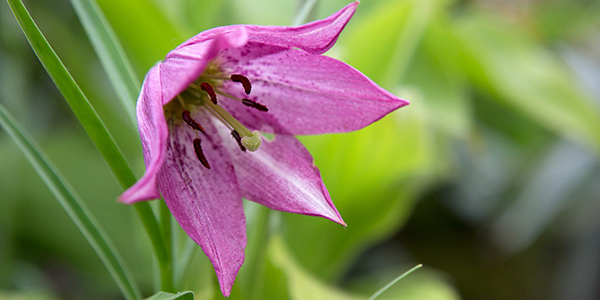
Local Name:Surya Pushpam
Family:Liliaceae (Lily family)
1-2 meters
Perennial (can live for many years)
- English Name: Fragrant Himalayan Lily
- Botanical Name: Lilium oxypetalum
- Local Name: Surya Pushpam or Brahma Kamal
- Flowering time: July to September
- Life span: Perennial (can live for many years)
- Height of the plant: Typically grows up to 1-2 meters in height
- Size of the flower: The flowers are large, measuring around 15-20 cm. in diameter
- Family: Liliaceae (Lily family)
- Habitat: Native to the Himalayan region, found in higher altitudes, usually in forests or rocky areas
- Uses:
- Ornamental: Often grown in gardens for its beautiful and fragrant flowers.
- Medicinal: In traditional medicine, various parts of the plant are used for their therapeutic properties. The flowers, roots, and bulbs are believed to have medicinal value and are used to treat various ailments.
- Cultural and Religious Significance: The Brahma Kamal flower holds a significant place in Hindu mythology and is considered sacred.
- It is associated with deities like Lord Brahma and Lord Vishnu. It is often used in religious rituals and offerings.
- Aesthetic and Photography: The unique and exquisite appearance of the Lilium oxypetalum flower makes it a popular subject for photographers and artists. Its large, white petals and intricate floral structure create visually captivating images.
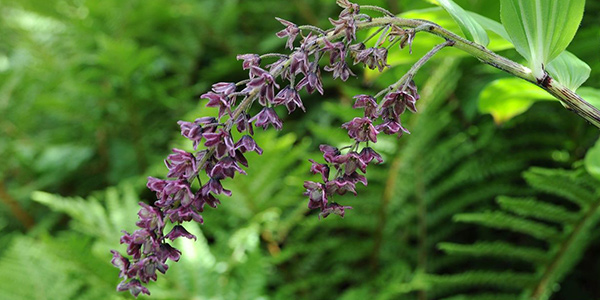
Local Name:Not specified
Family:Asparagaceae
30-60 cm. (12-24 inches)
Perennial (lives for several years)
- English Name: Purple False Solomon's Seal
- Botanical Name: Mianthemum purpureum
- Local Name: Not commonly known by a specific local name in India
- Flowering time: Typically blooms in late spring or early summer (May to June)
- Life span: Perennial plant, can live for several years
- Height of the plant: Usually reaches a height of about 30-60 cm. (12-24 inches)
- Size of the flower: Small, white or pale pink flowers, approximately 6-10 millimeters (0.24-0.39 inches) in diameter
- Family: Asparagaceae
- Habitat: Native to North America, commonly found in moist woodlands, shaded areas, and along stream banks
- Uses:
- Ornamental purposes: The attractive foliage and delicate flowers make it a popular choice for gardens and landscaping.
- Medicinal uses: Some Native American tribes have historically used parts of the plant for various medicinal purposes, such as treating respiratory ailments and digestive issues.
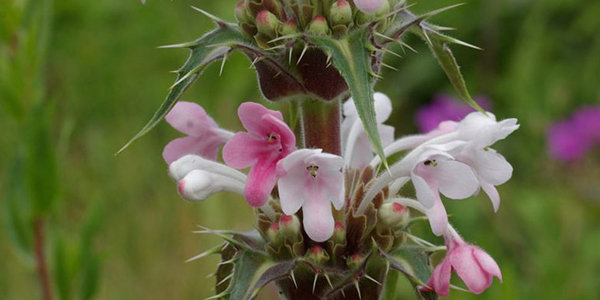
Local Name:Not specified
Family:Caprifoliaceae (Honeysuckle family)
1.5 to 2 meters
Perennial (long-lived)
- English Name: Morina longifolia
- Botanical Name: Morina longifolia
- Local Name: Not specified
- Flowering time: June to August
- Life span: Perennial (long-lived)
- Height of the plant: Can grow up to 1.5 to 2 meters
- Size of the flower: Small, approximately 2-3 cm. in diameter
- Family: Caprifoliaceae (Honeysuckle family)
- Habitat: Native to the Himalayan region, found in alpine meadows and rocky slopes at high altitudes
- Uses:
- Ornamental plant: Morina longifolia is appreciated for its attractive flowers and foliage, making it a popular choice for gardens and landscaping. Medicinal purposes: Various parts of the plant, such as the roots and leaves, are used in traditional medicine for their potential therapeutic properties.
- They are believed to possess anti-inflammatory, analgesic, and antioxidant properties.
- Food source for wildlife: The flowers of Morina longifolia attract pollinators like bees and butterflies, contributing to the biodiversity of the area.
- The plant may also serve as a food source for certain wildlife species.
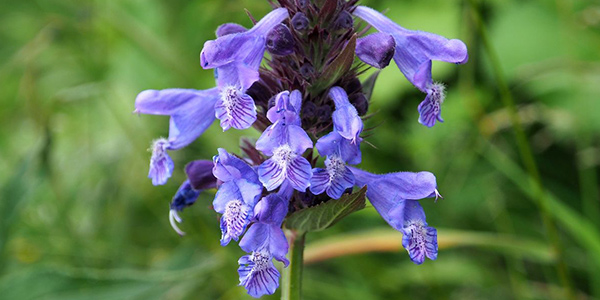
Local Name:Not specified
Family:Lamiaceae (Mint family)
30-60 cm (12-24 inches)
Perennial (lives for several years)
- English Name: Erect Catmint
- Botanical Name: Nepeta erecta
- Local Name: Not commonly known by a specific local name
- Flowering time: June to August
- Life span: Perennial plant, can live for several years
- Height of the plant: Typically grows up to 30-60 cm (12-24 inches) tall
- Size of the flower: Small, typically around 1-2 cm (0.4-0.8 inches) in diameter
- Family: Lamiaceae (Mint family)
- Habitat: Native to the Mediterranean region, but can be found in various other regions as well. It prefers well-drained soils and can tolerate dry conditions.
- Uses:
- Ornamental purposes: Often grown in gardens for its attractive flowers and aromatic foliage. Medicinal uses: Some species of Nepeta have traditional medicinal uses, but specific uses for Nepeta erecta are less well-known.
- Attracts pollinators: The flowers of Nepeta erecta are known to attract bees, butterflies, and other pollinators.
- Wildlife habitat: Provides a habitat for small animals and insects.
- Fragrance: The leaves of Nepeta erecta release a pleasant scent when crushed, often used in potpourri or herbal sachets.
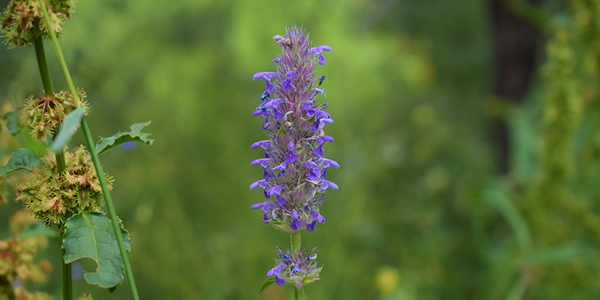
Local Name:Not specified
Family:Lamiaceae (Mint family)
30-60 cm (12-24 inches)
Perennial (lives for multiple years)
- English Name: Smooth Catmint
- Botanical Name: Nepeta laevigata
- Local Name: Not commonly known by a specific local name in India
- Flowering time: May to August
- Life span: Perennial (can live for multiple years)
- Height of the plant: Typically grows up to 30-60 cm (12-24 inches) tall
- Size of the flower: Small, tubular-shaped flowers measuring approximately 1-2 cm (0.4-0.8 inches) in length
- Family: Lamiaceae (Mint family)
- Habitat: Native to the Mediterranean region, including countries like Greece, Italy, and Turkey.
- It can also be found in other parts of Europe and Western Asia. In India, it may be cultivated in gardens or grown as an ornamental plant.
- Uses:
- Ornamental Plant: Nepeta laevigata is often grown in gardens for its attractive foliage and flowers.
- Medicinal Properties: Some species of Nepeta have been used in traditional medicine for their potential medicinal properties, including anti-inflammatory and sedative effects. However, specific information regarding the medicinal uses of Nepeta laevigata is limited, and it is not widely used for medicinal purposes.
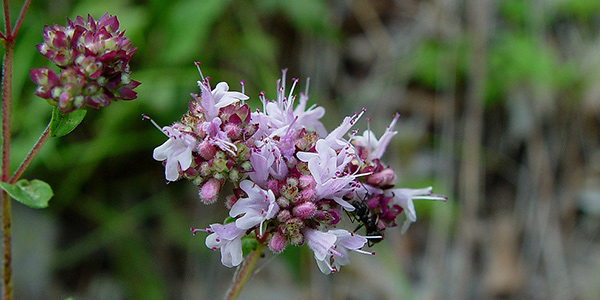
Local Name:Patta Ajwain
Family:Lamiaceae (Mint family)
20-80 cm (8-32 inches)
Perennial (lives for several years)
- English Name: Flower Origanum vulgare
- Botanical Name: Origanum vulgare
- Local Name: Patta Ajwain
- Flowering time: July to September
- Life span: Perennial (can live for several years)
- Height of the plant: 20-80 cm (8-32 inches)
- Size of the flower: Small, approximately 3-4 mm in diameter
- Family: Lamiaceae (Mint family)
- Habitat: Native to Europe, North Africa, and temperate regions of Asia; commonly found in dry, rocky, and well-drained soils
- Uses:
- Culinary herb: The leaves are commonly used as a flavorful addition to various dishes, such as soups, stews, and sauces.
- Medicinal purposes: Origanum vulgare has been used in traditional medicine for its potential antibacterial, antifungal, and antioxidant properties. It is also believed to aid digestion and relieve symptoms of respiratory conditions.
- Aromatic herb: The leaves and flowers have a pleasant aroma and are often used in potpourri and herbal sachets.
- Ornamental plant: The attractive flowers and foliage make Origanum vulgare a popular choice for garden borders and rock gardens.
- Insect repellent: The strong scent of the plant helps repel insects, making it useful for natural pest control.
- Tea infusion: The dried leaves and flowers can be used to make herbal tea, which is enjoyed for its soothing and aromatic qualities.
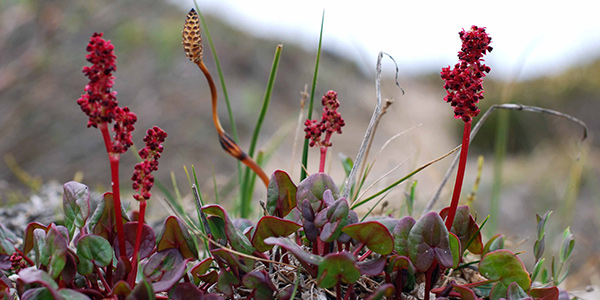
Local Name:Not specified
Family:Polygonaceae (Buckwheat family)
10-30 cm (4-12 inches)
Perennial (lives for several years)
- English Name: Alpine Mountain Sorrel
- Botanical Name: Oxyria digyna
- Local Name: Not commonly known by a specific local name in India
- Flowering time: June to August
- Life span: Perennial (can live for several years)
- Height of the plant: Typically grows up to 10-30 cm (4-12 inches) tall
- Size of the flower: Small, inconspicuous flowers, usually less than 1 cm (0.4 inches) in diameter
- Family: Polygonaceae (Buckwheat family)
- Habitat: Native to cool and alpine regions, found in mountainous areas, rocky slopes, and meadows
- Habitat: Native to cool and alpine regions, found in mountainous areas, rocky slopes, and meadows.
- It prefers well-drained soils and thrives in moist and shady habitats.
- Uses:
- Culinary: The leaves of Oxyria digyna are edible and have a tangy flavor. They are sometimes used in salads, soups, or cooked as a vegetable.
- Medicinal: In traditional medicine, Oxyria digyna has been used for its astringent and diuretic properties.
- It has been used to treat conditions like diarrhea, hemorrhoids, and urinary tract disorders.
- Ornamental: The attractive foliage of Oxyria digyna makes it a desirable plant for rock gardens or alpine plant collections.
- Its low-growing habit and colorful leaves add visual interest to landscapes.
- Environmental: Oxyria digyna plays a role in stabilizing soil in alpine habitats and contributes to biodiversity in mountain ecosystems.
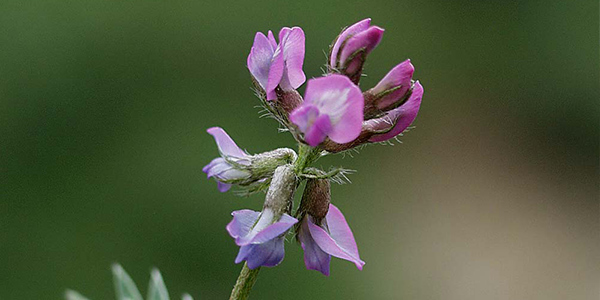
Local Name:Not specified
Family:Fabaceae(Pea family)
10 to 20 cm.
Perennial
- English Name: Lapland Oxytrope
- Botanical Name: Oxytropis lapponica
- Local Name: Not commonly found in India
- Flowering time: June to August
- Life span: Perennial
- Height of the plant: Usually around 10-20 cm tall
- Size of the flower: Small, about 1 cm in diameter
- Family: Fabaceae (Pea family)
- Habitat: Alpine and subalpine regions, typically found in mountainous areas with rocky and well-drained soil
- Uses:
- Ornamental plant: The delicate flowers and compact size make it a popular choice for rock gardens or alpine plant collections.
- Medicinal uses: Some species within the Oxytropis genus have traditional uses in folk medicine, but specific uses for Oxytropis lapponica may vary or require further research.
- Ecological importance: As a legume, it can contribute to nitrogen fixation in the soil, benefiting the surrounding plant community.
- Wildlife support: The flowers attract pollinators such as bees and butterflies, contributing to biodiversity in their habitat.
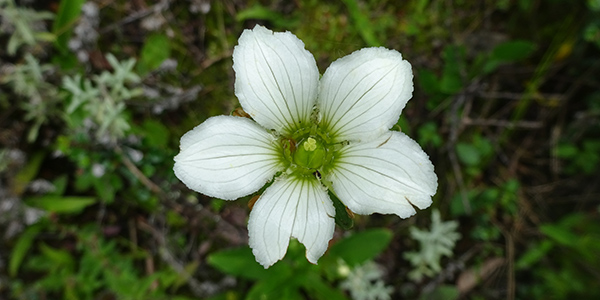
Local Name:Not specified
Family:Celastraceae
10 to 25 cm.
Perennial (lives for several years)
- English Name: Flower Parnassia
- Botanical Name: Parnassia nubicola
- Local Name: Not specified, as Flower Parnassia is not native to India.
- Flowering time: Typically blooms from July to August.
- Life span: The lifespan of Flower Parnassia is not well-documented but is estimated to be several years.
- Height of the plant: Usually reaches a height of 10 to 25 cm. (4 to 10 inches).
- Size of the flower: The flower of Parnassia nubicola is approximately 2 to 3 cm. (0.8 to 1.2 inches) in diameter.
- Family: Flower Parnassia belongs to the family Celastraceae.
- Habitat: It is primarily found in alpine meadows and rocky slopes in the Himalayan region, including countries like Nepal, Bhutan, and Tibet.
- Uses:
- Flower Parnassia is mainly admired for its ornamental value and is frequently cultivated in gardens for its delicate and attractive flowers.
- It is also sometimes used in traditional medicine for its potential medicinal properties, although further research is needed to validate its effectiveness.

Local Name:Not specified
Family:Scrophulariaceae(Figwort family)
30-60 cm.
Perennial (lives for several years)
- English Name: Hoffmeister's Lousewort
- Botanical Name: Pedicularis hoffmeisteri
- Local Name: Not commonly known by a specific local name in India
- Flowering time: Generally blooms from June to August
- Life span: Perennial plant with a life span of several years
- Height of the plant: Typically grows up to 30-60 cm. in height
- Size of the flower: The flowers are small, measuring around 1-2 cm. in length
- Family: Scrophulariaceae (Figwort family)
- Habitat: Found in alpine and subalpine regions, usually in rocky or gravelly areas, meadows, and open slopes
- Uses:
- Horticulture: Can be cultivated in rock gardens or alpine plant collections for its attractive flowers.
- Medicinal: Some species of the Pedicularis genus are used in traditional medicine for their potential medicinal properties, although the specific uses of Pedicularis hoffmeisteri are less documented.
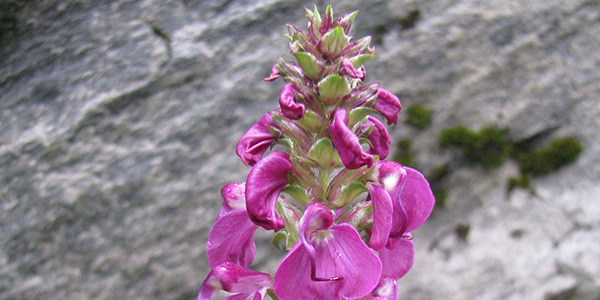
Local Name:Not specified
Family:Orobanchaceae
30-60 cm.
Perennial (lives for several years)
- English Name: Bent Lousewort
- Botanical Name: Pedicularis porrecta
- Local Name: Not specified (may vary regionally)
- Flowering time: Typically blooms during the summer months, from June to August
- Life span in year: Perennial plant, capable of living for several years
- Height of the plant: Can grow up to 30-60 cm. (12-24 inches) in height
- Size of the flower: The flowers are small, typically measuring around 1-2 cm. (0.4-0.8 inches) in length
- Family: Orobanchaceae
- Habitat: Found in alpine and subalpine regions, usually in moist meadows, grasslands, and open slopes. It thrives in cool, mountainous environments.
- Uses:
- Medicinal: Some species within the Pedicularis genus, including Pedicularis porrecta, have traditional uses in herbal medicine. They are believed to possess properties that can help with various ailments, including respiratory issues, headaches, and joint pain.
- Ornamental: Due to its attractive flowers and unique appearance, Pedicularis porrecta is occasionally grown in gardens as an ornamental plant. Its colorful blooms can add beauty and interest to flower beds and borders.
- Ecological: The flowers of Pedicularis porrecta attract pollinators such as bees and butterflies, contributing to the biodiversity and ecosystem health of their native habitats.
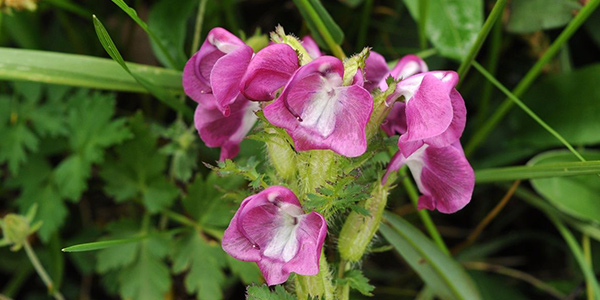
Local Name:Not specified
Family:Orobanchaceae
20 to 60 cm.
Perennial
- English Name: Spotted Lousewort
- Botanical Name: Pedicularis punctata
- Local Name: Not specified
- Flowering time: June to August
- Life span : Perennial
- Height of the plant: 20-60 cm (8-24 inches)
- Size of the flower: Small, approximately 1 cm (0.4 inches)
- Family: Orobanchaceae
- Habitat: Native to the western parts of North America, including the Rocky Mountains. It can be found in meadows, open forests, and alpine regions.
- Uses:
- Medicinal: Some species of Pedicularis are used in traditional medicine for their potential anti-inflammatory, analgesic, and sedative properties.
- Ornamental: Due to its attractive flowers, Pedicularis punctata is sometimes grown as an ornamental plant in gardens and landscapes.
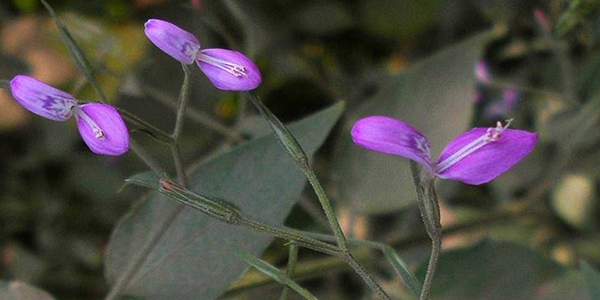
Local Name:Vanjaramani
Family:Acanthaceae
1-2 meters
Perennial
- English Name: Slender Vervain
- Botanical Name: Peristrophe paniculata
- Local Name: Vanjaramani, Keela Nelli
- Flowering time: June to October
- Life span: Perennial
- Height of the plant: 1-2 meters
- Size of the flower: Small, about 1-2 cm. in length
- Family: Acanthaceae
- Habitat: Native to tropical and subtropical regions of India, Sri Lanka, and Southeast Asia. It is found in open forests, grasslands, and along roadsides.
- Uses:
- Medicinal: The leaves and roots of Peristrophe paniculata are used in traditional medicine for various purposes. They are believed to have anti-inflammatory, antimicrobial, and antidiabetic properties. The plant is used in the treatment of fever, skin diseases, digestive disorders, and respiratory ailments.
- Ornamental: The attractive flowers of Peristrophe paniculata make it a popular choice for gardens and landscaping.
- Ecological: The plant serves as a nectar source for butterflies and other pollinators, contributing to biodiversity in its habitat.
- Cultural: In some regions of India, the plant is considered sacred and is used in religious rituals and ceremonies.
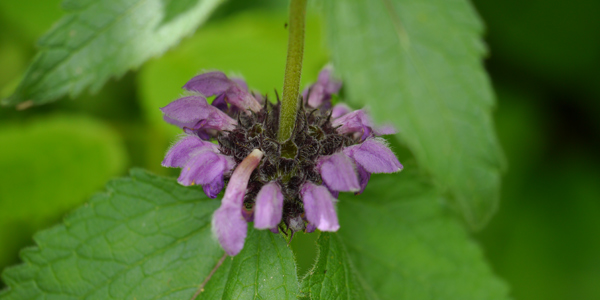
Local Name:Bhootkeshi
Family:Lamiaceae (Mint family)
2 to 3 feet
Perennial (long-lived)
- English Name: Kashmir Sage
- Botanical Name: Phlomis bracteosa
- Local Name: Bhootkeshi
- Flowering time: May to June
- Life span: Perennial (long-lived)
- Height of the plant: 2 to 3 feet
- Size of the flower: 1 to 2 inches in diameter
- Family: Lamiaceae (Mint family)
- Habitat: Native to the Himalayan region, found in forests and meadows at higher altitudes.
- Uses:
- Ornamental plant: The beautiful flowers make it a popular choice for gardens and landscaping.
- Medicinal purposes: Some traditional medicinal uses in India include treating digestive disorders and respiratory ailments.
- Cultural significance: In certain regions of India, the plant is considered sacred and used in religious ceremonies.
- Wildlife habitat: The flowers attract bees, butterflies, and other pollinators, contributing to biodiversity and supporting the ecosystem.
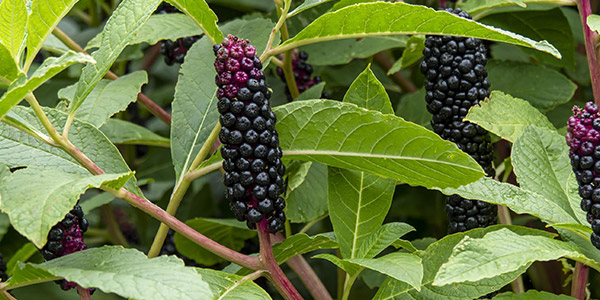
Local Name:Kharphul
Family:Phytolaccaceae
2 to 3 meters
Perennial (lives for several years)
- English Name: Indian Pokeweed
- Botanical Name: Phytolacca acinosa
- Local Name: Kharphul
- Flowering time: July to September
- Life span: Perennial (lives for several years)
- Height of the plant: 2 to 3 meters (6.5 to 10 feet)
- Size of the flower: Small, white to pinkish, arranged in clusters
- Family: Phytolaccaceae
- Habitat: Native to Asia, commonly found in India, China, and Southeast Asia. Grows in open areas, wastelands, forest edges, and along roadsides.
- Uses:
- Medicinal: Various parts of the plant are used in traditional medicine to treat skin diseases, rheumatism, arthritis, and digestive disorders.
- Dye: The berries of the plant yield a red dye used for coloring fabrics.
- Culinary: Young leaves are consumed as a vegetable in some regions.
- Ornamental: The attractive clusters of flowers make it a popular choice for gardens and landscaping.
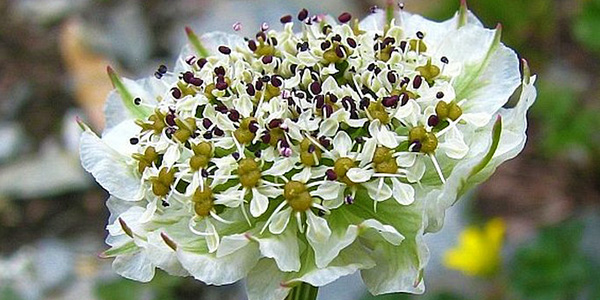
Local Name:Not specified
Family:Apiaceae (Umbelliferae)
2 to 4 feet
Perennial (long-lived)
- English Name: Candolle's Pleurospermum
- Botanical Name: Pleurospermum candollei
- Local Name: Not specified
- Flowering time: June to August
- Life span: Perennial (long-lived)
- Height of the plant: About 2 to 4 feet (60 to 120 cm)
- Size of the flower: Small, approximately 0.1 to 0.2 inches (3 to 5 mm) in diameter
- Family: Apiaceae (Umbelliferae)
- Habitat: Found in alpine meadows and rocky slopes of the Himalayas, primarily in the regions of Himachal Pradesh, Uttarakhand, and Sikkim in India
- Uses:
- The plant is primarily used for ornamental purposes due to its attractive, delicate flowers.
- It is also known to have medicinal properties and is used in traditional medicine for various ailments, although specific uses and preparations may vary across different communities.
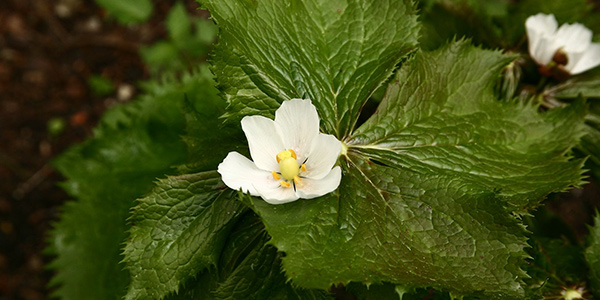
Local Name:Bankakri
Family:Berberidaceae
30-60 cm (12-24 inches)
Perennial (long-lived)
- English Name: Himalayan Mayapple
- Botanical Name: Podophyllum hexandrum
- Local Name: Bankakri, Ban Kakri
- Flowering time: April to May
- Life span: Perennial (long-lived)
- Height of the plant: Typically 30-60 cm (12-24 inches) tall
- Size of the flower: The flowers are small, measuring about 2-3 cm (0.8-1.2 inches) in diameter
- Family: Berberidaceae
- Habitat: Found in the Himalayan region, particularly in the temperate forests of India, Nepal, Bhutan, and Tibet. It prefers moist, shady locations with rich soil.
- Uses:
- Medicinal purposes: The rhizomes and roots of Podophyllum hexandrum are used in traditional medicine for their antiviral, antifungal, and anti-inflammatory properties. They contain bioactive compounds such as podophyllotoxin, which is used in the production of drugs for cancer treatment.
- Ornamental plant: Due to its attractive foliage and unique flowers, Podophyllum hexandrum is cultivated as an ornamental plant in gardens and landscapes.
- Food source: The fruits of Podophyllum hexandrum are edible and can be consumed, but they are not widely utilized for culinary purposes.
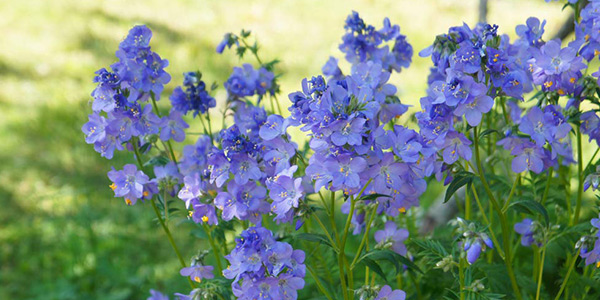
Local Name:Not specified
Family:Polemoniaceae
1 to 3 feet
Perennial (lives for several years)
- English Name: Jacob's Ladder
- Botanical Name: Polemonium caeruleum
- Local Name: Not commonly known by a specific local name in India
- Flowering time: Typically blooms in late spring or early summer, around the months of May and June
- Life span: Perennial plant with a lifespan of several years
- Height of the plant: Typically grows to a height of 1 to 3 feet (30 to 90 cm)
- Size of the flower: The flowers are medium-sized, measuring approximately 1 inch (2.5 cm) in diameter
- Family: Polemoniaceae family
- Habitat: Native to North America, it thrives in moist, well-drained soils and is often found in woodland areas, meadows, and along streams or in mountainous regions.
- Uses:
- Jacob's Ladder is primarily grown as an ornamental plant for its attractive blue, lavender, or white flowers.
- It is popular in gardens and landscaping for its delicate foliage and colorful blooms. Additionally, it is known for attracting pollinators such as bees and butterflies. However, it does not have significant traditional or medicinal uses in India.
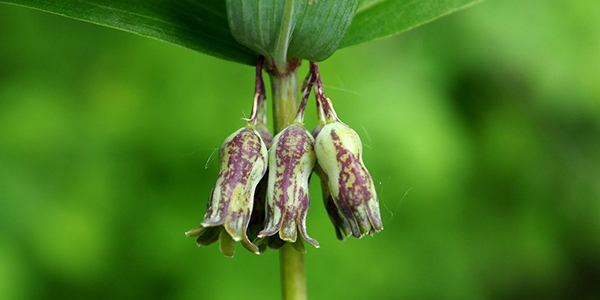
Local Name:Not specified
Family:Asparagaceae
30-90 cm.
Perennial (lives for many years)
- English Name: Whorled Solomon's Seal
- Botanical Name: Polygonatum verticillatum
- Local Name: Not specified
- Flowering time: May to June
- Life span: Perennial (can live for many years)
- Height of the plant: 30-90 cm (1-3 feet)
- Size of the flower: Small, bell-shaped flowers about 1 cm long
- Family: Asparagaceae
- Habitat: Woodlands, forests, shady areas
- Uses:
- Ornamental plant: Whorled Solomon's Seal is often cultivated for its attractive foliage and delicate flowers.
- Medicinal purposes: Some traditional medicinal uses include treating digestive disorders, reducing inflammation, and improving lung function.
- Wildlife habitat: The plant provides food and shelter for various insects and small animals.
- Conservation: Whorled Solomon's Seal is sometimes grown as part of conservation efforts to protect and preserve native plant species.
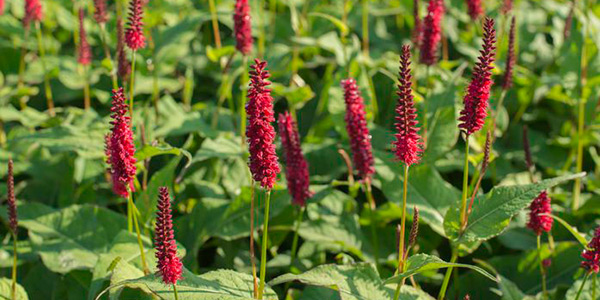
Local Name:Not specified
Family:Polygonaceae
up to 1 meter
Perennial (lives for several years)
- English Name: Willow-leaf knotweed
- Botanical Name: Polygonum amplexicaule
- Local Name: Not specified, as the plant is not native to India.
- Flowering time: July to September
- Life span: Perennial plant, typically living for several years.
- Height of the plant: Can grow up to 1 meter in height.
- Size of the flower: Small, typically measuring around 2-3 mm in diameter.
- Family: Polygonaceae
- Habitat: Native to Europe and Asia, the plant can be found in meadows, pastures, waste areas, and along roadsides.
- Uses:
- While not commonly used for specific purposes, it can be grown as an ornamental plant in gardens and landscapes. Some varieties of Polygonum amplexicaule are also utilized in traditional herbal medicine for their potential health benefits.
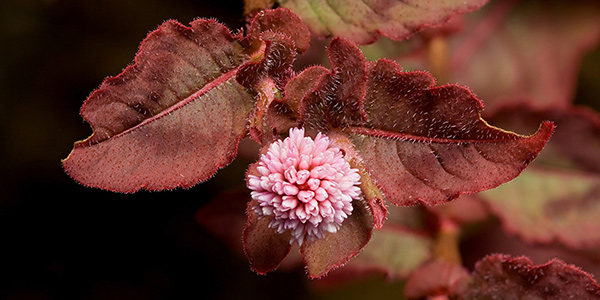
Local Name:Not specified
Family:Polygonaceae
up to 20-30 cm.
Perennial (lives for several years)
- English Name: Pinkhead Smartweed
- Botanical Name: Polygonum capitatum
- Local Name: Not specified, as the plant is not native to India
- Flowering time: June to October
- Life span: Perennial (can live for several years)
- Height of the plant: Typically grows up to 20-30 cm. in height
- Size of the flower: Small, pink or reddish-pink flowers
- Family: Polygonaceae
- Habitat: Native to China, Japan, and Korea. It is also found in other parts of Asia, Europe, and North America.
- In India, it is not a commonly found plant.
- Uses:
- Ornamental purposes: The attractive pink flowers and dense foliage make it a popular choice for ornamental gardens.
- Erosion control: The plant's spreading habit and dense root system help prevent soil erosion in gardens and landscapes.
- Wildlife support: The flowers attract pollinators such as bees and butterflies, contributing to biodiversity in the area where it grows.
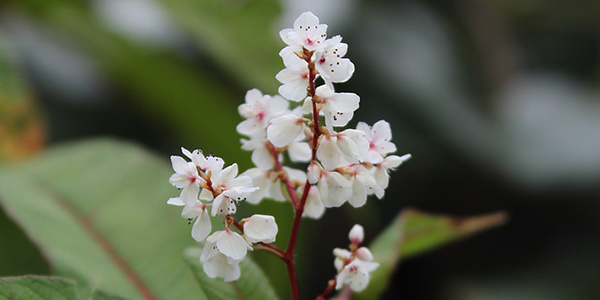
Local Name:Not specified
Family:Polygonaceae
1.5 meters(4.9 feet)
Perennial (lives for multiple years)
- English Name: Manyflowered Smartweed
- Botanical Name: Polygonum polystachyum
- Local Name: Not specified
- Flowering time: August to November
- Life span: Perennial (can live for multiple years)
- Height of the plant: Can reach up to 1.5 meters (4.9 feet) tall
- Size of the flower: Small, typically less than 1 centimeter (0.4 inches) in diameter
- Family: Polygonaceae
- Habitat: Native to Asia, including India. It is found in wetlands, marshes, and along riverbanks.
- Uses:
- Ornamental plant: It is often cultivated for its attractive foliage and flowers in gardens and landscapes.
- Ecological role: It provides habitat and food for various insects, birds, and other wildlife.
- Medicinal use: Some traditional medicine systems use the plant for its potential medicinal properties.
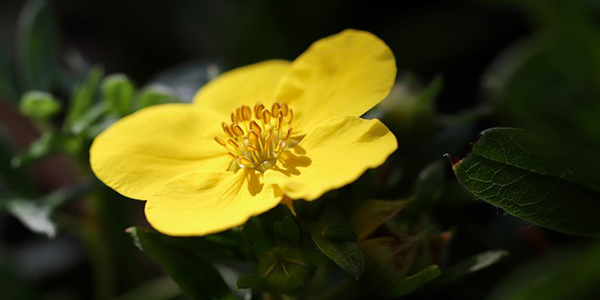
Local Name:Not specified
Family:Rosaceae (Rose family)
10 to 30 cm.
Perennial (lives for multiple years)
- English Name: Flower Potentilla rigida
- Botanical Name: Potentilla rigida
- Local Name: Not specified (Potentilla rigida is not native to India)
- Flowering time: May to July
- Life span: Perennial (can live for multiple years)
- Height of the plant: Approximately 10-30 cm.
- Size of the flower: Small, typically around 1 centimeter in diameter
- Family: Rosaceae (Rose family)
- Habitat: Potentilla rigida is native to alpine regions of Europe and Asia, and it thrives in rocky areas, mountain slopes, and grasslands.
- Uses:
- Ornamental purposes: The attractive flowers of Potentilla rigida make it a popular choice for gardens and landscaping.
- Medicinal uses: Some species of Potentilla have been used in traditional medicine for their potential anti-inflammatory and antioxidant properties, although specific uses of Potentilla rigida in traditional medicine are not widely documented.
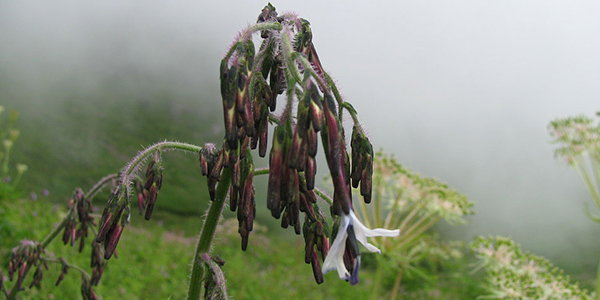
Local Name:Not specified
Family:Asteraceae
p to 1 to 2 meters
Perennial (lives for multiple years)
- English Name: Brunonia Lettuce
- Botanical Name: Prenanthes brunoniana
- Local Name: Not applicable (it is not native to India)
- Flowering time: July to September
- Life span: Perennial (can live for multiple years)
- Height of the plant: Usually grows up to 1 to 2 meters in height
- Size of the flower: The flowers are small and arranged in clusters, with each flower measuring approximately 1 to 2 cm. in diameter.
- Family: Asteraceae (the aster family)
- Habitat: Found in alpine meadows, grasslands, and open slopes in the Himalayan region, particularly in Bhutan, Nepal, and Tibet.
- Uses:
- Medicinal uses: In traditional Tibetan medicine, the plant is used for treating respiratory conditions, gastrointestinal disorders, and as a diuretic. It is also believed to have anti-inflammatory properties.
- Ornamental purposes: Due to its attractive flowers and distinctive foliage, Prenanthes brunoniana is occasionally cultivated as an ornamental plant in gardens.
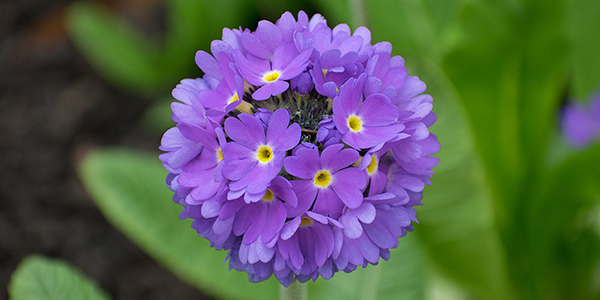
Local Name:Drumstick Primrose
Family:Primulaceae
12-24 inches
Perennial (lives for several years)
- English Name: Drumstick Primrose
- Botanical Name: Primula denticulata
- Local Name: None; commonly known as Drumstick Primrose or Himalayan Primrose
- Flowering time: March to May
- Life span: Perennial (can live for several years)
- Height of the plant: Typically grows to a height of 12-24 inches (30-60 cm)
- Size of the flower: The flower heads can reach a diameter of 2-3 inches (5-7.5 cm)
- Family: Primulaceae
- Habitat: Native to the Himalayas and found in regions like India, Bhutan, Nepal, and Tibet.
- It prefers moist and shady locations such as woodland areas and damp meadows.
- Uses:
- Ornamental plant: Primula denticulata is popular for its attractive and vibrant flower heads, making it a desirable addition to gardens and flower beds.
- Medicinal purposes: Some species of Primula have been traditionally used in herbal medicine for treating certain ailments, although specific uses for Primula denticulata are less known.
- Conservation: Primula denticulata, as a native species, contributes to the biodiversity of the Himalayan region and is important for maintaining ecological balance.

Local Name:Not specified
Family:Primulaceae
20-40 cm.
Perennial (lives for several years)
- English Name: Large-leaf Primrose
- Botanical Name: Primula macrophylla
- Local Name: Not commonly known by a specific local name in India
- Flowering time: Typically blooms in late spring or early summer (May to June)
- Life span: Perennial plant, with a lifespan of several years
- Height of the plant: Usually grows up to 20-40 cm. (8-16 inches) in height
- Size of the flower: The flowers are relatively large, measuring around 2-3 cm. (0.8-1.2 inches) in diameter
- Family: Primulaceae family
- Habitat: Native to the Himalayas, it can be found in alpine regions and mountainous areas, often growing in meadows, grassy slopes, and woodland edges.
- Uses:
- Primula macrophylla is primarily grown as an ornamental plant in gardens and landscapes due to its attractive flowers. It adds color and beauty to flower beds, borders, and rock gardens. Additionally, some species of Primula have traditional medicinal uses, but specific uses for Primula macrophylla are not widely documented.
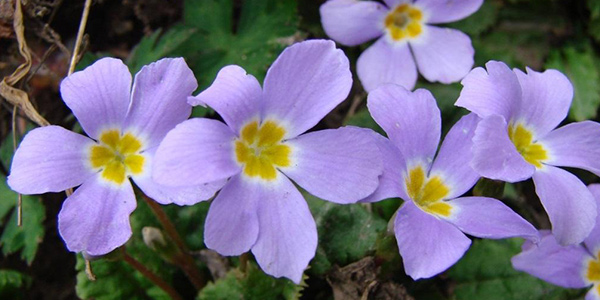
Local Name:Not specified
Family:Primulaceae
2 to 3 cm.
Perennial (lives for several years)
- English Name: Flower Primula macrophylla (Variety - Moorcroftiana)
- Botanical Name: Primula macrophylla (Variety - Moorcroftiana)
- Local Name: Not specified, as it is commonly referred to as Primula macrophylla or simply Primrose.
- Flowering time: Typically blooms in late spring to early summer (May to June).
- Life span: Primula macrophylla (Moorcroftiana variety) is a perennial plant, meaning it can live for several years.
- Height of the plant: The plant reaches a height of about 20 to 30 cm. (8 to 12 inches).
- Size of the flower: The flowers of Primula macrophylla (Moorcroftiana variety) are relatively large, with a diameter of approximately 2 to 3 cm. (0.8 to 1.2 inches).
- Family: Primulaceae family.
- Habitat: Primula macrophylla (Moorcroftiana variety) is native to the Himalayan region and can be found growing in alpine meadows, mountain slopes, and moist areas with well-drained soil.
- Uses:
- Primula macrophylla (Moorcroftiana variety) is primarily grown as an ornamental plant in gardens and landscapes.
- It adds a vibrant splash of color to flower beds and borders. Additionally, it is sometimes used in traditional medicine for its potential medicinal properties, although more research is needed in this regard.
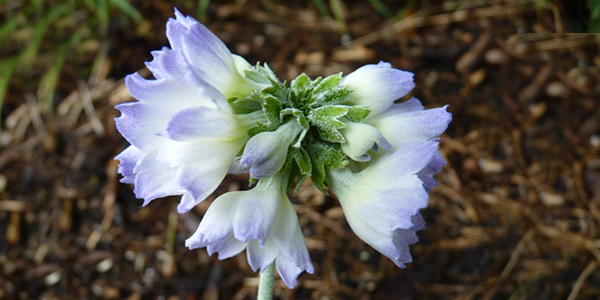
Local Name:Not specified
Family:Primulaceae
15-30 cm.
Perennial (lives for multiple years)
- English Name: Reid's Primrose
- Botanical Name: Primula reidii
- Local Name: Not specified
- Flowering time: March to May
- Life span: Perennial (typically lives for multiple years)
- Life span: Perennial (typically lives for multiple years)
- Size of the flower: Small to medium-sized, usually around 1-2 cm. (0.4-0.8 inches) in diameter
- Family: Primulaceae
- Habitat: Primula reidii is native to the Western Himalayas and is found in alpine meadows, rocky slopes, and damp areas at high altitudes.
- Uses:
- Ornamental purposes: Reid's Primrose is often cultivated as an ornamental plant for its attractive flowers.
- Medicinal uses: Some species of Primula have traditional medicinal uses in different cultures, but specific uses for Primula reidii may not be extensively documented.
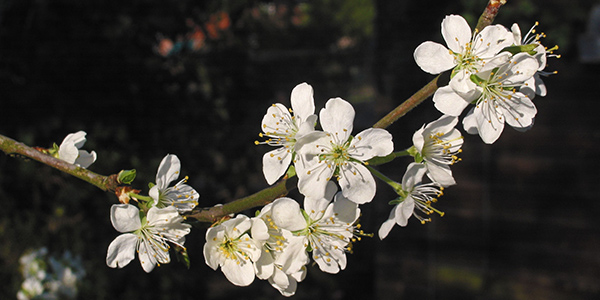
Local Name:Not specified
Family:Rosaceae
15-30 feet
Perennial (lives for 20-25 years)
- English Name: Flower Prunus cornuta
- Botanical Name: Prunus cornuta
- Local Name: Not specified
- Flowering time: Spring (usually April-May)
- Life span: Typically lives for 20-25 years
- Height of the plane: Can reach heights of 15-30 feet (4.5-9 meters)
- Size of the flower: The flowers are small and arranged in clusters
- Family: Rosaceae
- Habitat: Native to various regions of North America, particularly in the United States and Canada
- Uses:
- Ornamental purposes: Prunus cornuta is often grown for its attractive flowers and foliage, making it a popular choice in gardens and landscapes.
- Wildlife habitat: The plant provides a food source and shelter for various wildlife species, including birds and insects.
- Medicinal properties: Some Native American tribes have traditionally used parts of the plant for medicinal purposes, including treating coughs and sore throats. However, it is important to consult with a healthcare professional before using any plant for medicinal purposes.
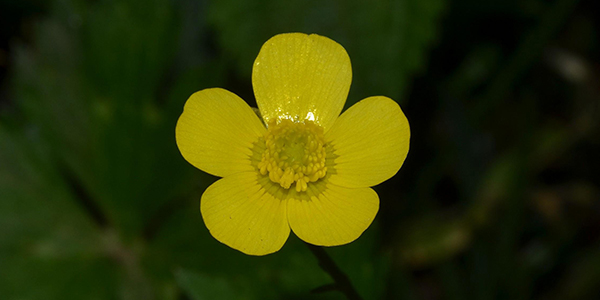
Local Name:Not specified
Family:Ranunculaceae
3 to 5 cm.
Perennial (lives for multiple years)
- English Name: Flower Ranunculus laetus
- Botanical Name: Ranunculus laetu
- Local Name: Not commonly known by a specific local name in India
- Flowering time: Typically blooms from late winter to early spring, usually around February to March
- Life span in year: Perennial plant, can live for multiple years
- Height of the plant: Generally reaches a height of about 30 to 40 cm.
- Size of the flower: The flowers of Ranunculus laetus can vary in size but are typically small to medium-sized, with an average diameter of 3 to 5 cm.
- Family: Belongs to the family Ranunculaceae
- Habitat: Native to the mountainous regions of Central Asia, specifically Afghanistan, Pakistan, and Tajikistan.
- It can also be found in parts of Iran and northern India.
- Uses:
- Often cultivated as an ornamental plant due to its vibrant and colorful flowers. It is commonly used in flower arrangements, bouquets, and gardens for its attractive appearance.
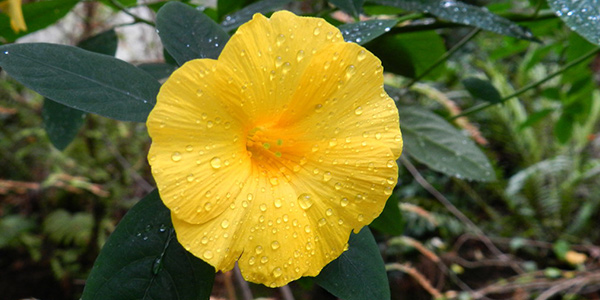
Local Name:Yellow Bells
Family:Linaceae
Up to 2 meters
Perennial
- English Name: Reinwardtia indica
- Botanical Name: Reinwardtia indica
- Local Name: Yellow Bells
- Flowering time: April to June
- Life span: Perennial
- Height of the plant: Up to 2 meters
- Size of the flower: Approximately 4-5 cm in diameter
- Family: Linaceae
- Habitat: Native to Southeast Asia, including India
- Uses:
- Ornamental plant: It is grown for its attractive yellow flowers and is often cultivated in gardens and parks.
- Traditional medicine: Various parts of the plant, including the leaves and roots, have been used in traditional medicine for their potential medicinal properties.
- Landscaping: Due to its vibrant flowers, it is sometimes used in landscaping projects to add color and visual interest to outdoor spaces.
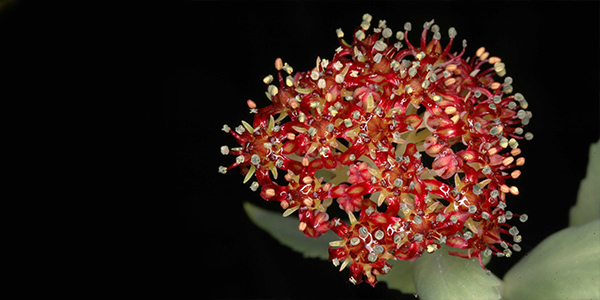
Local Name:Not specified
Family:Crassulaceae
10-15 cm.
Perennial (long lifespan)
- English Name: Flower Rhodiola heterodonta
- Botanical Name: Rhodiola heterodonta
- Local Name: Not specified or unknown
- Flowering time: Typically blooms from June to July
- Life span: Perennial plant with a long lifespan
- Height of the plant: Grows up to 10-15 cm. in height
- Size of the flower: Small, typically around 1-2 cm. in diameter
- Family: Crassulaceae family
- Habitat: Native to the Himalayan region, found in high-altitude areas such as alpine meadows and rocky slopes
- Uses:
- Medicinal properties: Rhodiola heterodonta is used in traditional medicine for its adaptogenic and anti-fatigue properties.
- It is believed to enhance physical endurance, reduce stress, and improve mental performance.
- Ornamental purposes: The flower's attractive appearance and ability to thrive in harsh environments make it suitable for rock gardens and alpine gardens. It is often cultivated as an ornamental plant.
- Conservation: Due to its restricted habitat and the potential threat of overharvesting, efforts may be made to conserve and protect Rhodiola heterodonta in its natural environment.
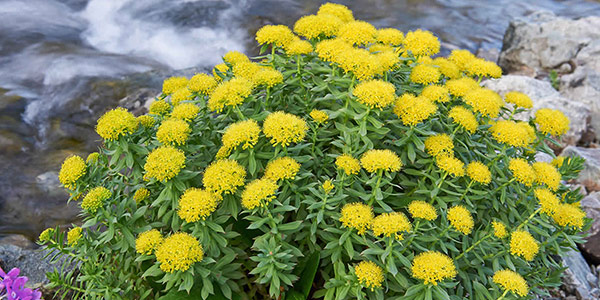
Local Name:Lali Gurans
Family:Crassulaceae
30-50 cm.
Perennial (lives for many years)
- English Name: Himalayan Rhodiola
- Botanical Name: Rhodiola imbricata
- Local Name: Lali Gurans
- Flowering time: June to August
- Life span: Perennial (can live for many years)
- Height of the plant: Typically grows up to 30-50 cm tall
- Size of the flower: Small, typically around 1 cm in diameter
- Family: Crassulaceae
- Habitat: Native to the Himalayan region, found in alpine and subalpine areas at elevations between 3,000 to 5,000 meters
- Uses:
- Medicinal properties: Rhodiola imbricata is used in traditional medicine for its adaptogenic and rejuvenating properties. It is believed to help increase energy, reduce fatigue, and enhance mental and physical performance.
- Ornamental: The plant's attractive flowers make it a popular choice for gardens and landscaping.
- Food: In some regions, the young shoots of Rhodiola imbricata are consumed as a vegetable and added to salads or cooked dishes.
- Traditional rituals: The flowers of Rhodiola imbricata hold cultural significance and are used in religious and festive ceremonies in some indigenous communities.
- Ecological value: The plant plays a role in soil conservation and stabilization in its native habitats.

Local Name:Buras
Family:Ericaceae
2 to 5 meters
50 to 100 years
- English Name: Bell Rhododendron
- Botanical Name: Rhododendron campanulatum
- Local Name: Buras
- Flowering time: April to June
- Life span in year: 50 to 100 years
- Height of the plant: 2 to 5 meters
- Size of the flower: 3 to 5 cm. in diameter
- Family: Ericaceae
- Habitat: Native to the Himalayan region, found at altitudes of 2,400 to 4,600 meters
- Uses:
- Ornamental plant: Grown for its attractive flowers and foliage in gardens and parks
- Traditional medicine: Various parts of the plant are used in traditional medicine for treating cough, cold, and other respiratory ailments.
- Bee forage: The flowers attract bees and other pollinators, contributing to biodiversity and honey production.
- Woodcraft: The wood is sometimes used for making small items like tool handles and walking sticks.
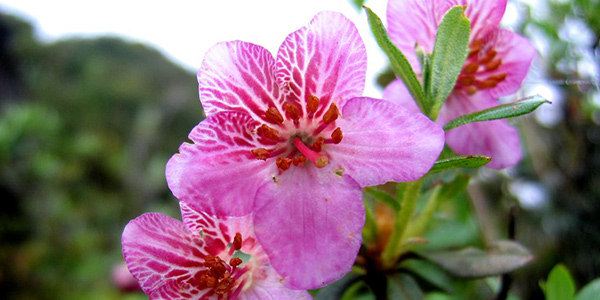
Local Name:Buras
Family:Ericaceae
2 to 4 meters
30 to 50 years
- English Name: Lepidotum Rhododendron
- Botanical Name: Rhododendron lepidotum
- Local Name: Buras
- Flowering time: April to June
- Life span: 30 to 50 years
- Height of the plant: 2 to 4 meters
- Size of the flower: Small to medium-sized flowers, approximately 2 to 5 cm. in diameter
- Family: Ericaceae
- Habitat: Native to the Himalayas, it can be found in regions with altitudes ranging from 2,000 to 4,000 meters.
- Uses:
- Ornamental plant: Grown for its attractive flowers and foliage in gardens and parks.
- Medicinal purposes: In traditional medicine, various parts of the plant are used for their therapeutic properties, such as treating gastrointestinal disorders and inflammation.
- Honey production: The flowers of Rhododendron lepidotum are a source of nectar for honeybees, contributing to honey production in some regions.
- Traditional rituals: In some cultures, the flowers are used in religious or ceremonial rituals.
- Environmental significance: Rhododendron lepidotum plays a role in maintaining biodiversity by providing habitat and food for insects, birds, and other wildlife.

Local Name:Indian Rose
Family:Rosaceae
10 to 20 feet
5 to 10 years
- Botanical Name: Rosa macrophylla
- Local Name: Indian Rose
- Flowering time: June to September
- Life span: Approximately 5 to 10 years
- Height of the plant: Can reach up to 10 to 20 feet (3 to 6 meters)
- Size of the flower: Large, typically around 3 to 5 inches (7 to 13 cm.) in diameter
- Family: Rosaceae
- Habitat: Native to the Himalayan region, found in forests and mountain slopes at altitudes of 1,500 to 3,000 meters.
- Uses:
- Ornamental purposes: Often cultivated for its attractive flowers and used in gardens and landscapes.
- Medicinal properties: Various parts of the plant are used in traditional medicine for their therapeutic properties, such as treating digestive disorders, skin conditions, and respiratory ailments.
- Fragrance: The flowers of Rosa Macrophylla have a pleasant fragrance and are sometimes used in perfumes and aromatherapy.
- Culinary uses: The petals of the flower can be used in cooking for flavoring desserts, jams, and teas.
- English Name: Rosa Macrophylla
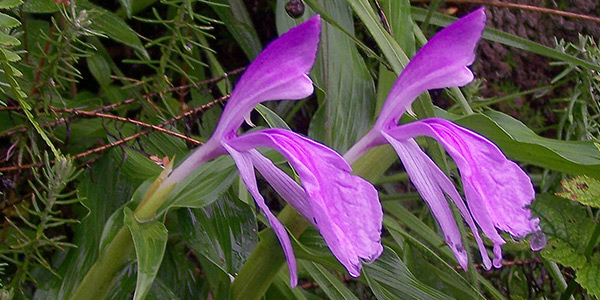
Local Name:Not specified
Family:Zingiberaceae(Ginger family)
1 to 2 feet (30 to 60 cm.)
Perennial (lives for several years)
- English Name: Alpine Roscoea
- Botanical Name: Roscoea alpina
- Local Name: Not commonly known by a specific local name in India
- Flowering time: June to August
- Life span: Perennial (can live for several years)
- Height of the plant: Typically grows up to 30-60 cm. in height
- Size of the flower: The flowers are small, approximately 2-3 cm. in diameter
- Family: Zingiberaceae (Ginger family)
- Habitat: Native to the Himalayan region, found in alpine meadows and rocky slopes at high elevations
- Uses:
- Ornamental plant: Roscoea alpina is cultivated for its attractive flowers and foliage in gardens and rockeries.
- Traditional medicine: Some species of Roscoea have traditional medicinal uses in certain regions, but specific uses for Roscoea alpina are not well-documented.
- Conservation: As an alpine plant, Roscoea alpina contributes to the biodiversity and ecological balance of its native Himalayan habitat.
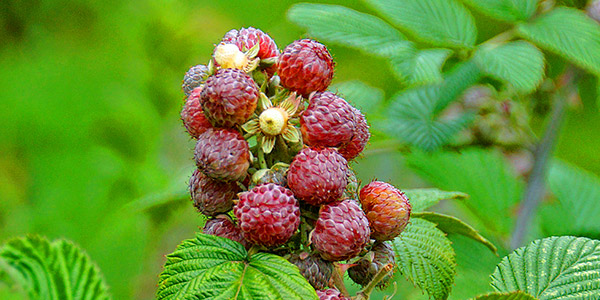
Local Name:Kavanda
Family:Rosaceae
1-2 cm.
Perennial (lives for several years)
- English Name: Snowy Bramble or Mysore Raspberry
- Botanical Name: Rubus niveus
- Local Name: Kavanda or Mysore Raspberry
- Flowering time: Late spring to early summer (April to June)
- Life span: Perennial (lives for several years)
- Height of the plant: Usually grows up to 1-2 meters in height
- Size of the flower: The flowers are small, measuring around 1-2 cm. in diameter
- Family: Rosaceae
- Habitat: Native to the Indian subcontinent, specifically found in the Western Ghats region of southern India.
- It thrives in moist and shaded areas, often found in forests, shrublands, and along stream banks.
- Uses:
- Ornamental purposes: The plant is valued for its attractive flowers and can be grown in gardens or landscapes.
- Culinary uses: The fruits of Rubus niveus are edible and can be consumed fresh or used in jams, jellies, desserts, or as a flavoring ingredient.
- Medicinal properties: Some traditional systems of medicine use parts of the plant for various purposes, including treating gastrointestinal disorders and skin ailments. However, scientific research on its medicinal properties is limited.
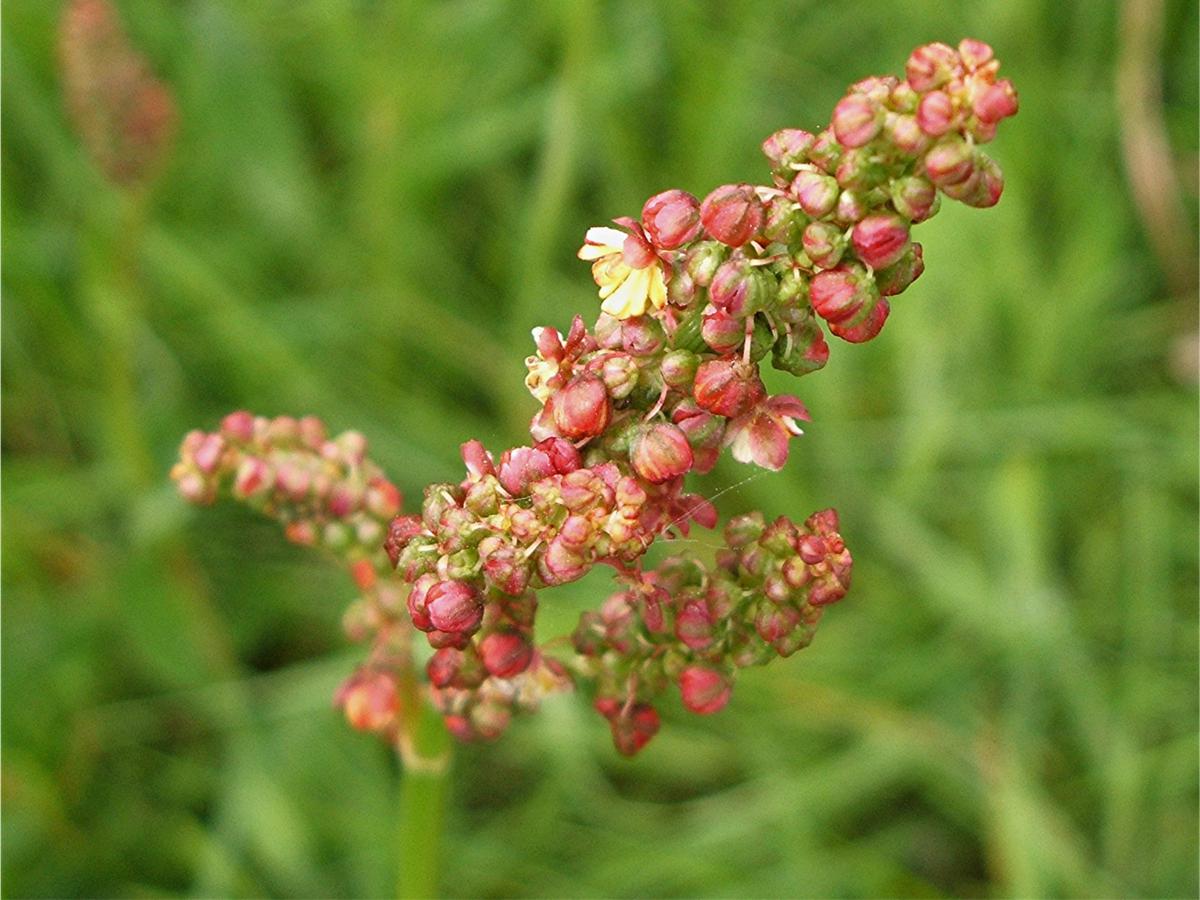
Local Name:Chukka
Family:Polygonaceae
30-90 cm (12-35 inches)
Perennial (lives for several years)
- English Name: Sorrel
- Botanical Name: Rumex acetosa
- Local Name: Chukka
- Flowering time: April to July
- Life span: Perennial (can live for several years)
- Height of the plant: 30-90 cm (12-35 inches)
- Size of the flower: Small, about 2-3 mm in diameter
- Family: Polygonaceae
- Habitat: Sorrel is native to Europe and Asia but can be found in various parts of India. It grows in meadows, grasslands, and open woodlands.
- Uses:
- Culinary: The leaves of Sorrel are used in cooking for their tangy flavor. They can be added to salads, soups, sauces, and various dishes.
- Medicinal: Sorrel is known for its medicinal properties. It contains vitamin C, antioxidants, and other beneficial compounds.
- It is used to treat digestive issues, purify the blood, and as a diuretic.
- Traditional medicine: In some traditional systems of medicine, Sorrel is used to treat skin diseases, urinary tract infections, and to improve appetite.
- Ornamental: Sorrel's attractive foliage and flowers make it a popular choice for ornamental gardens.
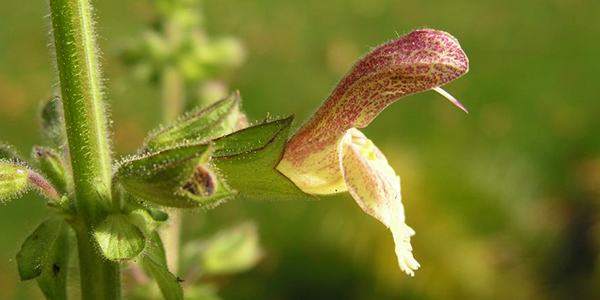
Local Name:Not specified
Family:Lamiaceae (Mint family)
1 to 2 feet (30 to 60 cm.)
Perennial (lives for several years)
- English Name: Nubicola Sage
- Botanical Name: Salvia nubicola
- Local Name: Not specified (commonly referred to as Nubicola Sage)
- Flowering time: June to September
- Life span: Perennial (can live for several years)
- Height of the plant: Typically reaches a height of 1 to 2 feet
- Size of the flower: The flowers are small, measuring around 0.5 to 0.75 inches in length
- Family: Lamiaceae (Mint family)
- Habitat: Native to the Himalayan region, found in the alpine meadows and rocky slopes at elevations of 3,000 to 4,500 meters.
- Uses:
- Ornamental purposes: Nubicola Sage is cultivated for its attractive flowers and foliage, often used in garden borders or rock gardens.
- Medicinal properties: Some species of Salvia have traditional medicinal uses, but specific uses for Salvia nubicola have not been extensively documented.
- Ecological value: The plant serves as a nectar source for pollinators, including bees and butterflies, supporting local ecosystems.
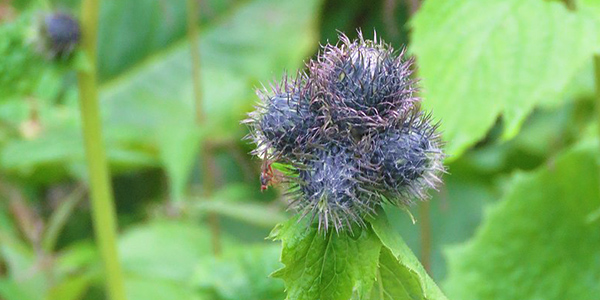
Local Name:Kuth,Kuth Root
Family:Asteraceae
1 to 2 meters
Perennial (lives for several years)
- English Name: Costus
- Botanical Name: Saussurea costus
- Local Name: Kuth, Kuth Root, Kushta, or Indian Costus
- Flowering time: July to September
- Life span: Perennial (can live for several years)
- Height of the plant: 1 to 2 meters
- Size of the flower: The flowers are small, measuring approximately 2 to 3 cm. in diameter
- Family: Asteraceae (the daisy family)
- Habitat: Native to the Himalayan region, found in India, Nepal, and Tibet. It typically grows in rocky slopes and alpine meadows at high altitudes.
- Uses:
- Medicinal purposes: The roots of Saussurea costus are highly valued in Ayurvedic medicine.
- They are used to treat various ailments such as digestive disorders, respiratory problems, and skin conditions. The root is often used in powdered form or as an essential oil.
- Fragrance and incense: Costus root has a distinct musky and spicy fragrance, which makes it a popular ingredient in perfumes, incense, and scented oils.
- Cultural and religious significance: In some Indian rituals and ceremonies, the Costus root is used as an offering to deities and is considered auspicious.
- Ornamental plant: Due to its attractive flowers and foliage, Saussurea costus is also cultivated as an ornamental plant in gardens and landscapes.
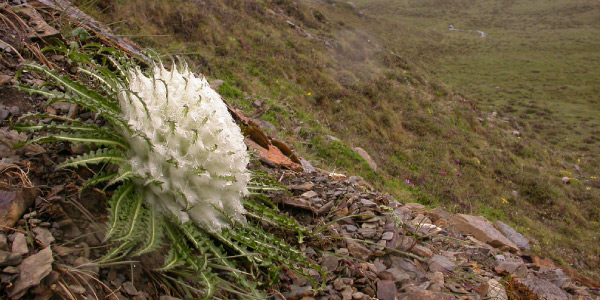
Local Name:Kapasru
Family:Asteraceae
1 to 2 feet(30 to 60 cm.)
Perennial (multiple years)
- English Name: Cottony Saussurea
- Botanical Name: Saussurea gossypiphora
- Local Name: Kapasru
- Flowering time: July to September
- Life span: Perennial (multiple years)
- Height of the plant: 30-60 cm (1-2 feet)
- Size of the flower: Approximately 5 cm (2 inches) in diameter
- Family: Asteraceae (Sunflower family)
- Habitat: Alpine regions of the Himalayas, particularly in Uttarakhand and Himachal Pradesh in India.
- Uses:
- Medicinal purposes: The plant is highly valued in traditional Ayurvedic medicine for its various therapeutic properties. It is used to treat respiratory disorders, asthma, coughs, and colds.
- Conservation: The Cottony Saussurea is considered a vulnerable species and is protected under the Indian Wildlife Protection Act. Efforts are made to conserve and protect its natural habitat.
- Ornamental: The plant's attractive flowers and unique cottony appearance make it popular among garden enthusiasts as an ornamental plant.
- Cultural significance: The plant holds cultural and religious significance in the region, and it is often associated with spiritual and ritual practices.
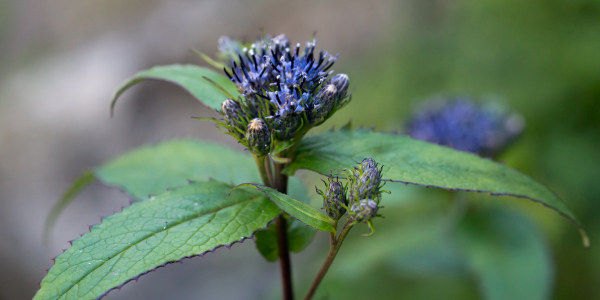
Local Name:Jangli Baduli
Family:Asteraceae
20 to 40 cm.
Perennial (long-lived)
- English Name: Himalayan Edelweiss
- Botanical Name: Saussurea piptathera
- Local Name: Jangli Baduli
- Flowering time: July to September
- Life span: Perennial (long-lived)
- Height of the plant: 20 to 40 cm.
- Size of the flower: Small, about 1 to 2 cm. in diameter
- Family: Asteraceae (Composite family)
- Habitat: Found in the high-altitude regions of the Himalayas, especially in the alpine meadows and rocky slopes.
- Uses:
- Medicinal: The roots and flowers of Saussurea piptathera are used in traditional medicine for treating various ailments such as respiratory disorders, gastrointestinal issues, and rheumatism.
- Ornamental: Due to its unique and beautiful appearance, it is sometimes cultivated as an ornamental plant in gardens.
- Cultural significance: In some Himalayan cultures, Saussurea piptathera is considered a sacred flower and is used in religious ceremonies and rituals.
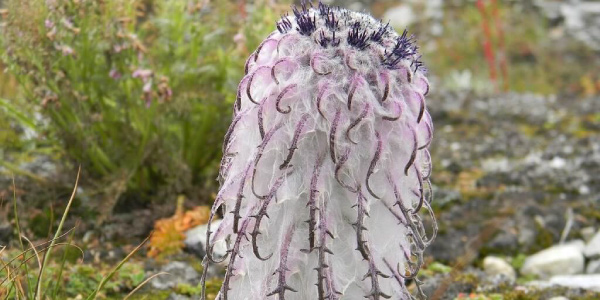
Local Name:Not specified
Family:Asteraceae
30-60 cm (12-24 inches)
Perennial
- English Name: Simpson's Saussurea
- Botanical Name: Saussurea simpsoniana
- Local Name: Not specified
- Flowering time: July to September
- Life span: Perennial
- Height of the plant: 30-60 cm (12-24 inches)
- Size of the flower: Small to medium-sized, typically 2-3 cm (0.8-1.2 inches) in diameter
- Family: Asteraceae
- Habitat: Native to the Western Himalayas, found in alpine meadows and rocky slopes at elevations between 3,000 to 4,500 meters (9,800 to 14,800 feet)
- Uses:
- The flowers of Saussurea simpsoniana are admired for their beauty and are sometimes grown as ornamental plants in gardens. Some species of Saussurea are also used in traditional medicine for their medicinal properties.
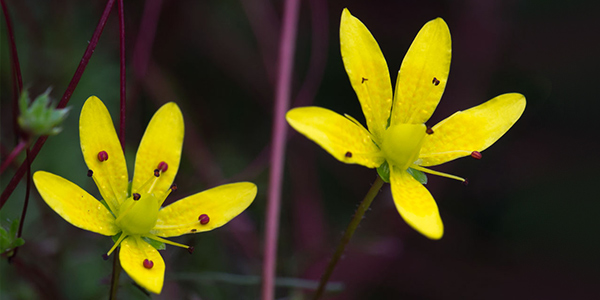
Local Name:Not specified
Family:Saxifragaceae
10-15 cm.
Perennial
- English Name: Brown's Saxifrage
- Botanical Name: Saxifraga brunonis
- Local Name: Not specified
- Flowering time: May to August
- Life span: Perennial
- Height of the plant: 10-15 cm.
- Size of the flower: Small, typically less than 1 centimeter in diameter
- Family: Saxifragaceae
- Habitat: Native to the Himalayan region, found in alpine meadows and rocky slopes at high altitudes.
- Uses:
- Ornamental plant, used in rock gardens and alpine plantings.
- Some species of Saxifraga are also used in traditional medicine for various purposes.
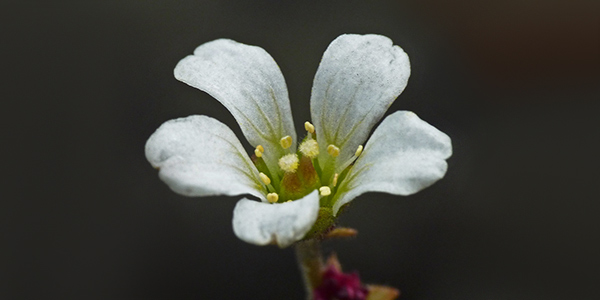
Local Name:Not specified
Family:Saxifragaceae
10-30 cm.
Perennial (lives for several years)
- English Name: Nodding Saxifrage
- Botanical Name: Saxifraga cernua
- Local Name: Not commonly known by a specific local name
- Flowering time: Late spring to early summer (typically May to June)
- Life span: Perennial plant, lives for several years
- Height of the plant: Usually grows up to 10-30 cm. (4-12 inches) in height
- Size of the flower: Small, delicate flowers measuring approximately 1-2 cm. (0.4-0.8 inches) in diameter
- Family: Saxifragaceae
- Habitat: Native to alpine and subalpine regions, often found in rocky or mountainous areas with well-drained soil
- Uses:
- Ornamental purposes: Nodding Saxifrage is cultivated as a garden plant for its attractive flowers and low-growing habit.
- Rock gardens: Its compact size and ability to thrive in rocky environments make it suitable for rock gardens.
- Erosion control: Due to its mat-forming habit and ability to tolerate harsh conditions, it can be used for erosion control on slopes or in areas prone to soil erosion.
- Medicinal uses: In some traditional systems of medicine, certain species of Saxifraga are used for various medicinal purposes, although specific uses for Saxifraga cernua may not be well-documented.
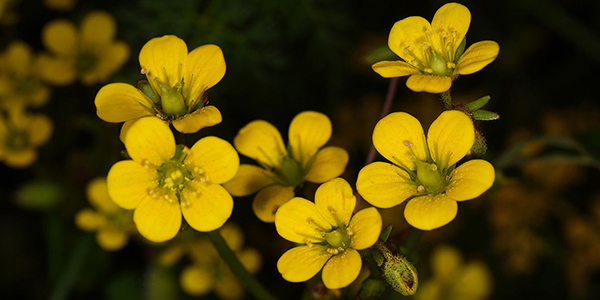
Local Name:Not specified
Family:Saxifragaceae
up to 10-20 cm
Perennial (lives for multiple years)
- English Name: Parnassus-leaved Saxifrage
- Botanical Name: Saxifraga parnassifolia
- Local Name: Not commonly known by a specific local name in India
- Flowering time: June to August
- Life span: Perennial (can live for multiple years)
- Height of the plant: Typically grows up to 10-20 cm in height
- Size of the flower: The flowers are small, measuring around 1 cm in diameter
- Family: Saxifragaceae
- Habitat: Found in high-altitude regions, such as alpine meadows, rocky slopes, and subalpine forests
- Uses:
- Primarily admired for its ornamental value in gardens and rockeries due to its attractive foliage and delicate flowers. It can also be used as a ground cover in suitable climates. Additionally, some species of Saxifraga have traditional medicinal uses in herbal remedies, although specific uses for Saxifraga parnassifolia are limited.
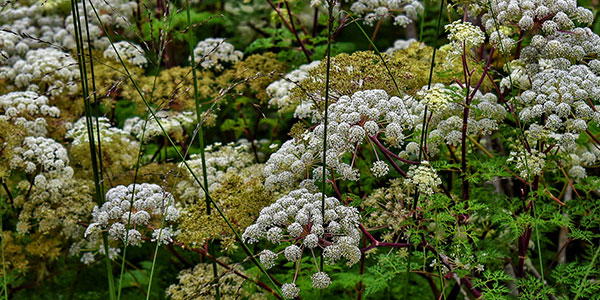
Local Name:Not specified
Family:Apiaceae
60-90 cm (2-3 feet)
Perennial
- English Name: Wallich's Selinum
- Botanical Name: Selinum wallichianum
- Local Name: Not specified
- Flowering time: July to September
- Life span: Perennial
- Height of the plant: Approximately 60-90 cm (2-3 feet)
- Size of the flower: Small, typically less than 1 cm (0.4 inches) in diameter
- Family: Apiaceae (Carrot family)
- Habitat: Found in the Himalayan region, especially in moist alpine meadows and open forests at elevations between 2,400 and 4,500 meters (7,900 and 14,800 feet)
- Uses:
- Ornamental plant: Wallich's Selinum is grown for its attractive flowers and foliage in gardens and landscapes.
- Medicinal purposes: Certain parts of the plant, such as the roots and seeds, are used in traditional medicine for their potential therapeutic properties.
- Wildlife habitat: The plant provides food and habitat for various insects and pollinators, contributing to biodiversity in its natural habitat.
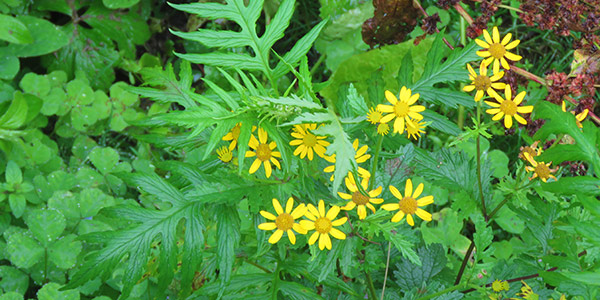
Local Name:Not specified
Family:Asteraceae
1 to 2 feet (30 to 60 cm.)
Perennial (short-lived)
- English Name: Flower Senecio graciliflorus
- Botanical Name: Senecio graciliflorus
- Local Name: Not specified
- Flowering time: Typically blooms in the spring and summer months
- Life span: Varies, typically an annual or short-lived perennial
- Height of the plant: Can reach up to 1 to 2 feet (30 to 60 cm.) in height
- Size of the flower: Small, daisy-like flowers measuring approximately 0.5 to 1 inch (1.3 to 2.5 cm.) in diameter
- Family: Asteraceae (the aster or daisy family)
- Habitat: Native to South Africa but can also be found in other regions with similar climates
- Uses:
- Primarily cultivated as an ornamental plant in gardens and landscapes for its attractive flowers and foliage. It can be grown in containers or used as a ground cover.
/DSC_3230.jpg)
Local Name:Not specified
Family:Asteraceae
1 to 2 feet (30 to 60 cm.)
Perennial (lives for several years)
- English Name: Cheerful Senecio
- Botanical Name: Senecio laetus
- Local Name: Not commonly known by a specific local name
- Flowering time: Generally blooms from late spring to early summer (April to June)
- Life span: Perennial plant, can live for several years
- Height of the plant: Typically grows up to 1-2 feet (30-60 cm) in height
- Size of the flower: The flower heads are small, usually around 1 inch (2.5 cm) in diameter
- Family: Asteraceae (Sunflower family)
- Habitat: Native to South Africa, but can be found in various regions with Mediterranean climates. It prefers well-drained soil and full sun exposure.
- Uses:
- Primarily grown as an ornamental plant for its attractive flowers and foliage. It is often used in gardens, borders, and containers to add color and texture. The cut flowers can also be used in floral arrangements. However, it is important to note that some species of Senecio can be toxic, so caution should be exercised when handling or ingesting the plant.
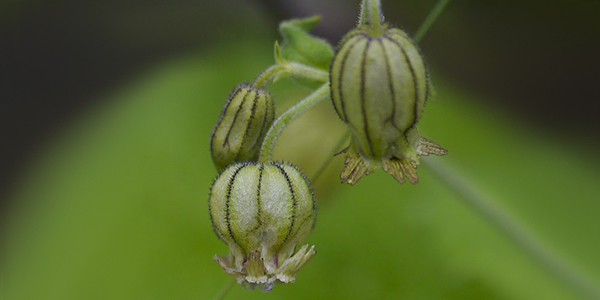
Local Name:Bhatkayi,Khursani
Family:Caryophyllaceae
30 to 60 cm.
Perennial (lives for several years)
- English Name: Indian Catchfly
- Botanical Name: Silene indica
- Local Name: Bhatkayi, Khursani, Indal, Ratta, and Chulyu (varies by region)
- Flowering time: April to July
- Life span: Perennial (can live for several years)
- Height of the plant: Typically grows up to 30-60 cm tall
- Size of the flower: The flowers are small, measuring about 1-2 cm in diameter
- Family: Caryophyllaceae
- Habitat: Found in the Himalayan region, particularly in India, Nepal, and Bhutan. It is commonly seen in alpine meadows, grasslands, and open slopes at elevations between 1,500 to 4,000 meters.
- Uses:
- Ornamental: The attractive flowers make it a popular choice for ornamental gardens and floral arrangements.
- Medicinal: Some traditional medicinal systems use Silene indica for its therapeutic properties.
- It is believed to have diuretic, digestive, and anti-inflammatory properties.
- Cultural significance: In some parts of India, the plant holds cultural significance and is used in religious ceremonies and rituals.
- Ecological value: Silene indica plays a role in maintaining biodiversity
- as it serves as a food source for various pollinators like bees and butterflies.
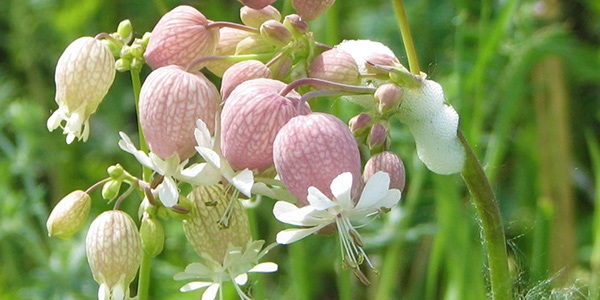
Local Name:Not specified
Family:Caryophyllaceae
30-60 cm.
Perennial (lives for several years)
- English Name: Bladder Campion
- Botanical Name: Silene vulgaris
- Local Name: Not commonly known by a specific local name in India
- Flowering time: June to August
- Life span: Perennial (can live for several years)
- Height of the plant: Typically grows up to 30-60 cm. in height
- Size of the flower: The flowers are small, measuring about 2 cm. in diameter
- Family: Caryophyllaceae (Pink family)
- Habitat: Commonly found in meadows, grasslands, woodland edges, and disturbed areas. It can adapt to various soil types.
- Uses:
- Ornamental: Bladder Campion is often cultivated as an ornamental plant in gardens for its delicate, white flowers.
- Medicinal: Some traditional medicinal uses are associated with Bladder Campion, including its use as a diuretic and treatment for digestive issues.
- Culinary: The young leaves of the plant are edible and can be used in salads or cooked as a vegetable. The flowers can also be consumed.
- Ecological: Bladder Campion serves as a food source for certain insects, including butterflies and bees. It also attracts pollinators to the garden.
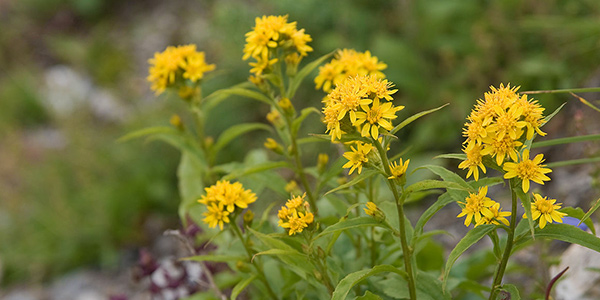
Local Name:Not specified
Family:Asteraceae
1 to 3 feet
2 to 5 years
- English Name: Goldenrod
- Botanical Name: Solidago virgaurea
- Local Name: Not commonly known by a specific local name in India
- Flowering time: Typically blooms from July to October
- Life span: Generally lives for 2 to 5 years
- Height of the plant: Can grow up to 1 to 3 feet in height
- Size of the flower: Small, yellow flowers arranged in dense, elongated clusters called racemes
- Family: Asteraceae (Composite or Aster family)
- Habitat: Native to Europe and Asia, it can be found in meadows, grasslands, open woods, and along roadsides.
- Uses:
- Ornamental: Often grown in gardens for its attractive yellow flowers.
- Medicinal: Traditionally used in herbal medicine to treat various ailments, including respiratory conditions, urinary tract disorders, and digestive issues.
- Wildlife: The flowers provide a valuable nectar source for bees, butterflies, and other pollinators, while the seeds are a food source for birds and small mammals.

Local Name:Not specified
Family:Rosaceae(Rose family)
6 to 10 feet
10 to 15 years
- English Name: False Spirea
- Botanical Name: Sorbaria tomentosa
- Local Name: Not commonly known by a specific local name in India
- Flowering time: June to July
- Life span: Approximately 10 to 15 years
- Height of the plant: Typically grows up to 6 to 10 feet (1.8 to 3 meters) in height
- Size of the flower: The flowers are small, usually measuring around 0.4 to 0.6 inches (1 to 1.5 cm.) in diameter
- Family: Rosaceae (Rose family)
- Habitat: Native to eastern Asia, including China, Korea, and Japan. It can also be found in parts of North America, Europe, and India. In India, it is mostly found in regions with temperate climates.
- Uses:
- Ornamental purposes: The False Spirea is commonly grown in gardens and landscapes for its attractive foliage and flowers.
- Erosion control: Its extensive root system helps stabilize soil on slopes, making it useful for erosion control.
- Wildlife habitat: The plant's dense growth habit provides shelter and nesting sites for various small animals and birds.
- Medicinal uses: Some traditional medicine systems use parts of the plant for their potential medicinal properties, although scientific evidence supporting their effectiveness is limited.

Local Name:Not specified
Family:Rosaceae
2 to 3 feet
3 to 10 years
- English Name: Spirea
- Botanical Name: Spiraea bella
- Local Name: Not commonly known by a specific local name in India.
- Flowering time: Usually blooms in late spring to early summer, typically from May to June.
- Life span: Can live for several years, ranging from 3 to 10 years on average.
- Height of the plant: Spiraea bella can grow up to a height of 2 to 3 feet (60 to 90 cm.).
- Size of the flower: The flowers are small, clustered in dense, rounded clusters called corymbs, with each flower measuring around 0.2 to 0.4 inches (5 to 10 millimeters) in diameter.
- Family: Rosaceae family.
- Habitat: Spiraea bella is native to parts of eastern Asia, including China, Korea, and Japan. It can be found growing in various habitats, such as forests, woodlands, and along stream banks.
- Uses:
- Ornamental Purposes: Spiraea bella is often cultivated as an ornamental shrub in gardens and landscapes due to its attractive flowers and foliage.
- Landscaping: It can be used in hedges, borders, or as a standalone specimen plant to add beauty and visual interest to outdoor spaces.
- Butterfly Attraction: The flowers of Spiraea bella can attract butterflies and other pollinators, making it a beneficial plant for supporting local ecosystems.
- Erosion Control: The dense growth habit of this shrub can help stabilize soil and prevent erosion, making it suitable for planting on slopes or areas prone to erosion.
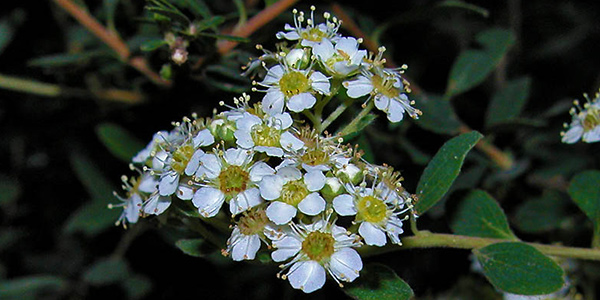
Local Name:Not specified
Family:Rosaceae
3 to 5 feet
5 to 10 years
- English Name: Bridal Wreath Spiraea
- Botanical Name: Spiraea canescens
- Local Name: Not known to have a specific local name in India
- Flowering time: April to June
- Life span: Approximately 5 to 10 years
- Height of the plant: Typically grows up to 3 to 5 feet (0.9 to 1.5 meters) tall
- Size of the flower: Small, white or pink flowers arranged in dense clusters
- Family: Rosaceae
- Habitat: Native to North America, commonly found in moist woods, thickets, and stream banks
- Uses:
- Ornamental plant: Bridal Wreath Spiraea is often grown in gardens and landscapes for its attractive, cascading branches and abundant flowers.
- Erosion control: The plant's extensive root system helps stabilize soil, making it useful for erosion control in riparian areas.
- Wildlife habitat: The flowers attract pollinators such as bees and butterflies, while the dense growth provides shelter for small mammals and birds
.jpg)
Local Name:Not specified
Family:Orchidaceae
20 to 30 cm.
Perennial (lives for several years)
- English Name: Chinese Lady's Tresses
- Botanical Name: Spiranthes sinensis
- Local Name: Not commonly known by a specific local name in India
- Flowering time: Late summer to early autumn (August to October)
- Life span: Perennial plant, can live for several years
- Height of the plant: Typically grows up to 20-30 cm in height
- Size of the flower: Small and delicate, approximately 1-1.5 cm in diameter
- Family: Orchidaceae (Orchid family)
- Habitat: Native to East Asia, including China, Japan, Korea, and Taiwan. It can also be found in parts of Southeast Asia. In India, it may be cultivated in suitable conditions.
- Uses:
- Primarily appreciated for its ornamental value, often cultivated as a garden plant.
- It is also known for its ecological importance as a pollinator attractant, providing nectar for bees, butterflies, and other insects.
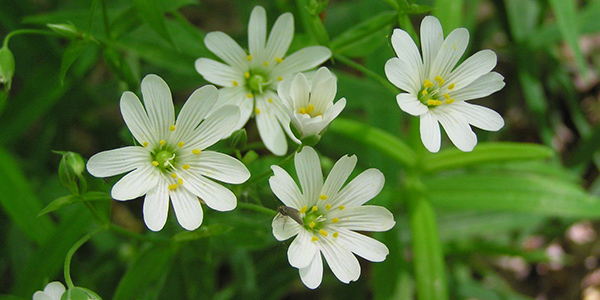
Local Name:Not specified
Family:Caryophyllaceae
15-30 cm.
Perennial (lives for several years)
- English Name: Star Chickweed
- Botanical Name: Stellaria semivestita
- Local Name: Not specified
- Flowering time: Spring to early summer (typically March to June)
- Life span: Perennial (can live for multiple years)
- Height of the plant: Usually 15-30 cm. (6-12 inches) tall
- Size of the flower: Small, usually less than 1 centimeter (0.4 inches) in diameter
- Family: Caryophyllaceae
- Habitat: Native to the Himalayan region, it can be found in mountainous areas of India, Nepal, Bhutan, and Tibet. It grows in alpine meadows, rocky slopes, and open grasslands.
- Uses:
- Ornamental plant: Star Chickweed is appreciated for its delicate, star-shaped flowers and can be cultivated in gardens for decorative purposes.
- Medicinal uses: Some traditional medicine systems use Stellaria semivestita for its purported diuretic and anti-inflammatory properties.
- It has been used to treat urinary tract infections and skin conditions.
- Culinary uses: In some regions, the leaves of Stellaria semivestita are consumed as a leafy vegetable and added to salads or cooked as a green vegetable.
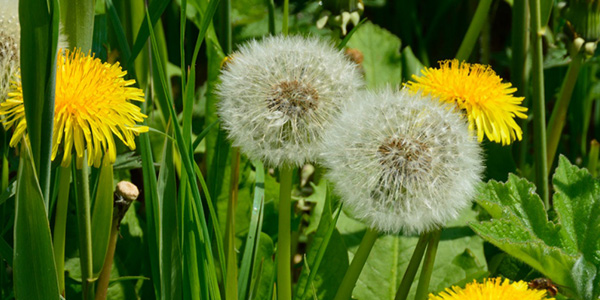
Local Name:Dudhi,Simhadanti
Family:
15 to 45 cm.
2 to 5 years
- English Name: Dandelion
- Botanical Name: Taraxacum officinale
- Local Name: Dudhi, Simhadanti
- Flowering time: April to June
- Life span: 2 to 5 years
- Height of the plant: 15 to 45 cm.
- Size of the flower: 2 to 5 cm. in diameter
- Family: Asteraceae (Compositae)
- Habitat: Found in lawns, meadows, fields, and disturbed areas
- Uses:
- Culinary: Young leaves can be used in salads, while older leaves are often cooked as greens. Flower buds can be pickled or used in herbal teas.
- Medicinal: Dandelion has various traditional medicinal uses, including as a diuretic, liver tonic, and digestive aid.
- Herbal remedies: The roots are used in traditional herbal remedies for conditions such as indigestion, loss of appetite, and urinary tract infections.
- Herbal teas: Dandelion flowers can be used to make a soothing herbal tea, often used for its diuretic properties.
- Natural dye: The flowers can be used to produce a yellow dye for fabrics and other materials.
- Wildlife support: Dandelion flowers provide an important source of nectar for bees and other pollinators.
- The plant also serves as a host for various butterfly and moth species.
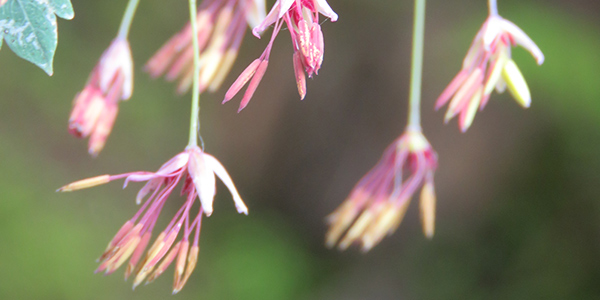
Local Name:Not specified
Family:Ranunculaceae
3 to 4 feet
2 to 5 years
- English Name: Cutleaf Meadow-rue
- Botanical Name: Thalictrum cultratum
- Local Name: Not commonly known by a specific local name in India
- Flowering time: Typically blooms in the months of July and August
- Life span: Generally has a lifespan of 2 to 5 years
- Height of the plant: Can reach a height of 3 to 4 feet (90 to 120 cm.)
- Size of the flower: The flowers are small and delicate, measuring around 0.5 to 0.75 inches (1.3 to 1.9 cm.) in diameter
- Family: Belongs to the Ranunculaceae family (Buttercup family)
- Habitat: Native to North America, specifically found in moist areas such as meadows, stream banks, and forest clearings
- Uses:
- Ornamental: Cutleaf Meadow-rue is commonly cultivated as an ornamental plant in gardens and landscapes due to its attractive foliage and delicate flowers.
- Medicinal: Some species within the Thalictrum genus have been used in traditional medicine, but specific uses for Thalictrum cultratum are limited and not well-documented.

Local Name:Not specified
Family:Fabaceae
2-4 feet (60-120 cm)
Perennial (lives for several years)
- English Name: Bush Pea
- Botanical Name: Thermopsis barbata
- Local Name: Not commonly known by a specific local name in India
- Flowering time: April to June
- Life span: Perennial plant, can live for several years
- Height of the plant: Typically grows up to 2-4 feet (60-120 cm) tall
- Size of the flower: The flowers are small, measuring about 1 inch (2.5 cm) in length
- Family: Fabaceae (Legume family)
- Habitat: Native to temperate regions of Asia, including parts of India, China, and Siberia. It can be found in grasslands, meadows, and open woodlands.
- Uses:
- Ornamental plant: It is cultivated for its attractive flowers and foliage, often used in garden borders or as a ground cover.
- Medicinal purposes: In traditional medicine, certain parts of Thermopsis barbata, such as the roots, are used to treat various ailments including respiratory disorders, gastrointestinal issues, and as a diuretic.
- Nitrogen fixation: Like other legumes, it forms a symbiotic relationship with nitrogen-fixing bacteria, which helps enrich the soil with nitrogen.
- Wildlife habitat: The plant serves as a food source and habitat for various insects and small animals.
- Conservation: It is important for maintaining biodiversity and ecological balance in its native habitats.

Local Name:Not specified
Family:Lamiaceae
10-20 cm (4-8 inches)
Perennial (lives for several years)
- English Name: Linear Thyme
- Botanical Name: Thymus linearis
- Local Name: Not commonly known by a specific local name in India.
- Flowering time: Typically flowers in late spring and early summer, from May to June.
- Life span: Perennial plant with a lifespan of several years.
- Height of the plant: Grows up to 10-20 cm (4-8 inches) in height.
- Size of the flower: Small, typically around 4-8 mm (0.15-0.3 inches) in size.
- Family: Belongs to the Lamiaceae family, commonly known as the mint family.
- Habitat: Native to regions of Europe and the Mediterranean, it prefers well-drained soils and can tolerate dry conditions.
- It is often found in rocky areas, open meadows, and slopes.
- Uses:
- Culinary: The leaves of Thymus linearis can be used as a culinary herb, adding flavor to various dishes, especially in Mediterranean cuisine. It is known for its aromatic and slightly spicy taste.
- Medicinal: Thymus linearis has been traditionally used in herbal medicine for its potential health benefits. It is believed to possess antimicrobial, antiseptic, and antioxidant properties. It may be used in herbal remedies for coughs, sore throats, and respiratory issues.
- Ornamental: With its low-growing habit and attractive flowers, Thymus linearis is often cultivated as an ornamental plant in gardens and rockeries. It can be used as ground cover or in borders, providing a touch of color and fragrance.
- Pollinator-friendly: The flowers of Thymus linearis attract pollinators, such as bees and butterflies, making it a beneficial plant for supporting biodiversity in gardens or natural habitats.
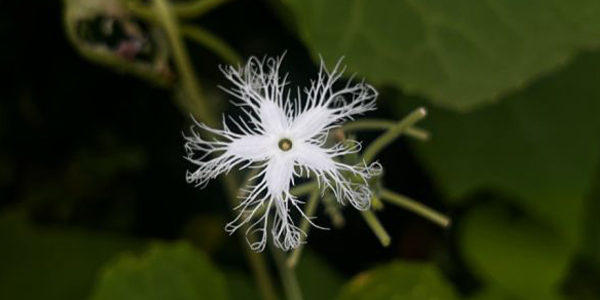
Local Name:Padwal,Paddu
Family:Cucurbitaceae
up to 6 meters
Perennial vine
- English Name: Cucumeropsis edulis or Red Snake Gourd
- Botanical Name: Trichosanthes tricuspidata
- Local Name: Padwal, Paddu, or Paddava
- Flowering time: July to September
- Life span: Perennial vine
- Height of the plant: Can reach up to 6 meters in height
- Size of the flower: The flowers are approximately 5-7 cm in diameter
- Family: Cucurbitaceae
- Habitat: Native to India, it is found in various regions across the country, particularly in the northern and eastern parts.
- Uses:
- Culinary: The young fruits of Trichosanthes tricuspidata are often used as a vegetable in Indian cuisine. They are cooked and consumed in various preparations, including curries, stir-fries, and pickles.
- Medicinal: Different parts of the plant, including the roots, fruits, and leaves, are utilized in traditional medicine. It is believed to have various medicinal properties and is used for treating ailments like diabetes, respiratory disorders, and skin diseases.
- Ornamental: The attractive flowers of Trichosanthes tricuspidata make it a popular choice for ornamental purposes, especially in gardens and landscapes.
/1278176802_47d1edccfc_b.jpg)
Local Name:Vajardanti
Family:Rosaceae
30 cm to 90 cm
Perennial
- English Name: Potentilla
- Botanical Name: Potentilla spp.
- Local Name: Vajardanti
- Flowering time: May to July
- Life span: Perennial
- Height of the plant: Varies depending on species, generally between 30 cm to 90 cm (1 to 3 feet)
- Size of the flower: Small to medium-sized, typically around 1 to 2 cm (0.4 to 0.8 inches) in diameter
- Family: Rosaceae (Rose family)
- Habitat: Potentilla species are found in various habitats, including meadows, forests, rocky slopes, and alpine regions.
- Uses:
- Medicinal: Some species of Potentilla have traditional medicinal uses in India, such as treating gastrointestinal disorders, diarrhea, and dysentery.
- Ornamental: Potentilla plants are cultivated for their attractive flowers and are used in gardens and landscapes for their ornamental value.
- Soil erosion control: The deep-rooted nature of Potentilla species helps stabilize soil and prevent erosion.
- Wildlife habitat: The flowers of Potentilla attract pollinators like bees and butterflies, making them valuable for supporting local ecosystems.
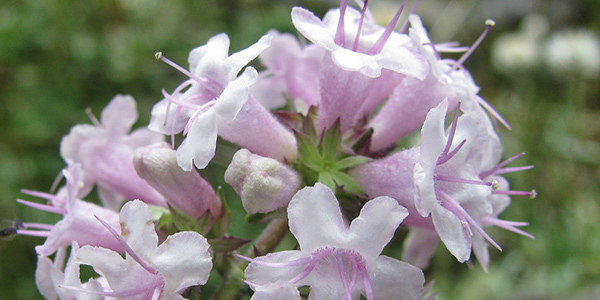
Local Name:Tagar
Family:Caprifoliaceae
1 to 1.5 meters
Perennial (multiple years)
- English Name: Indian Valerian
- Botanical Name: Valeriana hardwickii
- Local Name: Tagar
- Flowering time: June to September
- Life span: Perennial (multiple years)
- Height of the plant: Approximately 1 to 1.5 meters
- Size of the flower: Small, about 3 to 5 mm in diameter
- Family: Caprifoliaceae
- Habitat: Valeriana hardwickii is native to the Himalayan region and is found in parts of India, Nepal, Bhutan, and Tibet.
- It grows in alpine meadows, forests, and rocky slopes.
- Uses:
- Medicinal: The roots of Valeriana hardwickii are used in traditional Ayurvedic and Unani medicine systems to treat various ailments. It is believed to have sedative, calming, and anti-anxiety properties. The root extracts are used for treating insomnia, nervousness, and anxiety disorders.
- Fragrance: The plant has a pleasant fragrance, and the dried roots are sometimes used to make incense sticks and perfumes.
- Ornamental: Valeriana hardwickii is also cultivated as an ornamental plant in gardens for its attractive flowers and foliage.
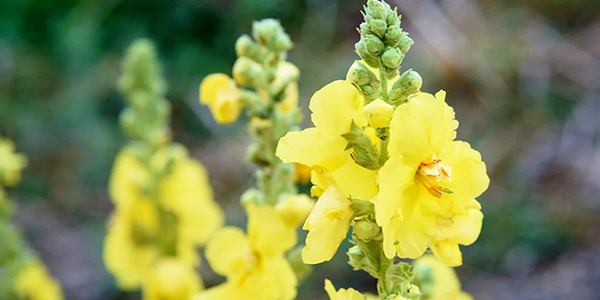
Local Name:Gidar tamaku
Family:Scrophulariaceae
1 to 2 meters
short-lived perennial
- English Name: Mullein
- Botanical Name: Verbascum thapsus
- Local Name: Gidar tamaku
- Flowering time: June to September
- Life span: Biennial or short-lived perennial
- Height of the plant: 1 to 2 meters (3 to 6 feet)
- Size of the flower: Large, yellow flowers with five petals, approximately 2 to 3 cm. in diameter
- Family: Scrophulariaceae
- Habitat: Native to Europe and Asia, introduced and naturalized in various parts of India
- Uses:
- Medicinal: Mullein leaves and flowers are used in traditional herbal medicine for treating respiratory conditions such as cough, bronchitis, and asthma. They can be made into teas, tinctures, or poultices.
- Ornamental: The tall, showy flower spikes of Verbascum thapsus make it a popular choice for adding vertical interest to gardens and landscaping.
- Wildlife: The flowers attract bees, butterflies, and other pollinators, contributing to the ecosystem and supporting biodiversity.
- Cultural: In some traditional cultures, the dried stalks of Mullein were used as torches or dipped in wax to make candles.

Local Name:Dalchini Kandi
Family:Fabaceae
up to 2 meters
depending on the conditions
- English Name: Creeping Vigna
- Botanical Name: Vigna vexillata
- Local Name: Dalchini Kandi, Jungle Kandi
- Flowering time: July to October
- Life span: Annual or perennial, depending on the conditions
- Height of the plant: Can reach up to 2 meters
- Size of the flower: Small, approximately 1-2 cm. in diameter
- Family: Fabaceae (Legume family)
- Habitat: Native to tropical regions of Asia, including India. It thrives in a variety of habitats, including open forests, grasslands, and disturbed areas.
- Uses:
- Food: The young pods and seeds of Vigna vexillata are edible and are used in traditional cuisines in various parts of India.
- Forage: The plant is sometimes cultivated as a forage crop for livestock, as its leaves and stems provide good fodder.
- Medicinal: In traditional medicine, the plant is believed to have diuretic, anti-inflammatory, and antioxidant properties, and it is used for various ailments.
- Soil improvement: Vigna vexillata is a nitrogen-fixing plant, which means it helps enrich the soil with nitrogen, benefiting neighboring plants.
- Erosion control: Due to its creeping and trailing nature, Vigna vexillata can be used in erosion control efforts, helping stabilize soil on slopes or disturbed areas.
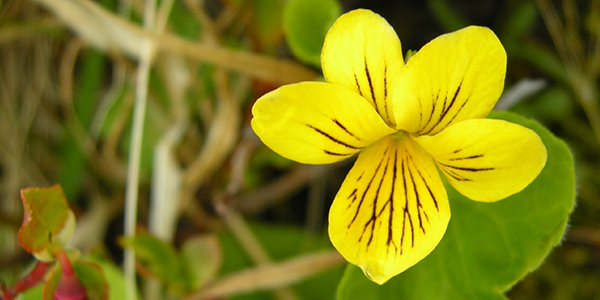
Local Name:Not specified
Family:Violaceae
up to 10-20 cm.
Perennial(lives for multiple years)
- English Name: Yellow Wood Violet
- Botanical Name: Viola biflora
- Local Name: Not specified, as it is not native to India
- Flowering time: April to July
- Life span: Perennial, meaning it lives for multiple years
- Height of the plant: Typically grows up to 10-20 cm. in height
- Size of the flower: The flowers are small, measuring approximately 1-2 cm. in diameter
- Family: Violaceae
- Habitat: Found in various habitats, including woodlands, meadows, and rocky slopes
- Uses:
- The Viola biflora flowers are ornamental and are sometimes used in traditional herbal medicine for their potential health benefits. They can also be cultivated in gardens or used as ground cover in shaded areas.
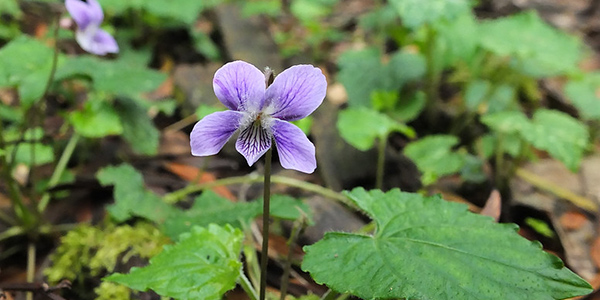
Local Name:Not specified
Family:Violaceae
10-20 cm.
lives for 2 to 3 years
- English Name: Hairy Violet
- Botanical Name: Viola pilosa
- Local Name: Not commonly known by a specific local name in India
- Flowering time: Typically blooms from March to July
- Life span: Usually lives for 2 to 3 years
- Height of the plant: Generally grows up to 10-20 cm. in height
- Size of the flower: The flowers are small, measuring about 1-2 cm. in diameter
- Family: Violaceae (Violet family)
- Habitat: Found in grasslands, meadows, open woodlands, and rocky slopes
- Uses:
- Ornamental purposes: The attractive violet flowers make it a popular choice for gardens and landscaping.
- Medicinal uses: Some traditional systems of medicine use Viola pilosa for various ailments, such as cough, sore throat, and skin conditions.
- Ecological importance: The plant serves as a food source for insects, butterflies, and bees.
- Traditional symbolism: Violets, including Viola pilosa, have been associated with various symbolic meanings, including love, modesty, and faithfulness in different cultures.


